If you are a birder who yearns to go on an out-of-state lifer grab but can’t because of your commitments to non-birding family members or significant others, pay attention. If you are stuck at home drooling over others’ epic blog posts of exotic birds from far-off lands, listen up. This post is for you. Like you, when it comes to birding I don’t have the devil-may-care attitude of the retired, the single, or the extremely rare birding couple. In recent months I discovered there was a whole pocket of lifers waiting for me not too far to the south in the Kansas City area. KC is less than 8 hours away by car, which is nothing considering its potential for lifer glory. Dragging the family there for birds was not going to fly. Neither was spending the time and money to go on a solo adventure. So I hatched a plan to get to KC where everyone won.
Since Melissa and Evan are die-hard Minnesota Twins fans, all I had to do to sell them on the idea was an offer to take them to KC to see their beloved team take on the Royals.
 That pretty much sealed the deal for them, but for added insurance I got seats which put Evan in a position of high probability to check off a major bucket-list item. It worked.
That pretty much sealed the deal for them, but for added insurance I got seats which put Evan in a position of high probability to check off a major bucket-list item. It worked.
 Having the entire family on the jumbo-tron and on TV was the icing.
Having the entire family on the jumbo-tron and on TV was the icing.

So what about Marin? She is neither a fan of birds or baseball. All it took to win her over was the promise of three nights in hotels with pools. It helped that the kids thought these pools were awesome.
 I mean, seriously, an indoor/outdoor pool where you can actually swim under the freaking wall of the hotel–how cool is that? This is the kind of thing that blows kids’ minds.
I mean, seriously, an indoor/outdoor pool where you can actually swim under the freaking wall of the hotel–how cool is that? This is the kind of thing that blows kids’ minds.
 So what about the birds? Let’s get on with it then. I had a number of targets of regular breeders in this central part of the country. The first one I targeted is one that has caused me heartache on a couple of occasions in Minnesota, the Least Tern. Since this bird breeds in shallow rivers with sandbars, Omaha is a great place to go after them because of the nearby Platte River. Unfortunately, though, it was getting late in the year to find any, and my chances were slim. Regardless, we were going to give it a try, checking out a couple of spots on the way to our Omaha hotel. The first stop was a place I’d been watching on eBird for months and was eager to see, a sandpit lake in Fremont, Nebraska.
So what about the birds? Let’s get on with it then. I had a number of targets of regular breeders in this central part of the country. The first one I targeted is one that has caused me heartache on a couple of occasions in Minnesota, the Least Tern. Since this bird breeds in shallow rivers with sandbars, Omaha is a great place to go after them because of the nearby Platte River. Unfortunately, though, it was getting late in the year to find any, and my chances were slim. Regardless, we were going to give it a try, checking out a couple of spots on the way to our Omaha hotel. The first stop was a place I’d been watching on eBird for months and was eager to see, a sandpit lake in Fremont, Nebraska.

Upon initial inspection, I didn’t see what I came to see. I don’t know if I just overlooked it at first or if it flew in when I wasn’t looking, but after ten minutes I spotted a Least Tern bathing off a sandbar right in front of me!
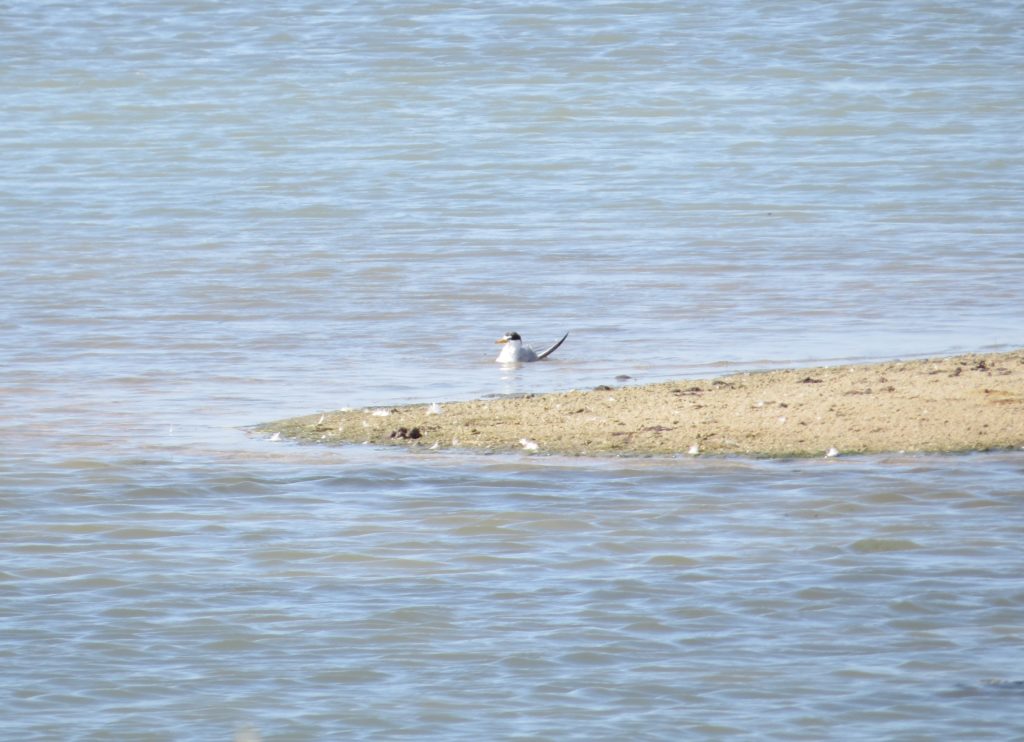 I’ve been yearning to see that bright yellow-bill for awhile. My family waiting in the car probably didn’t even notice the fist-pumping going on outside over this lifer.
I’ve been yearning to see that bright yellow-bill for awhile. My family waiting in the car probably didn’t even notice the fist-pumping going on outside over this lifer.
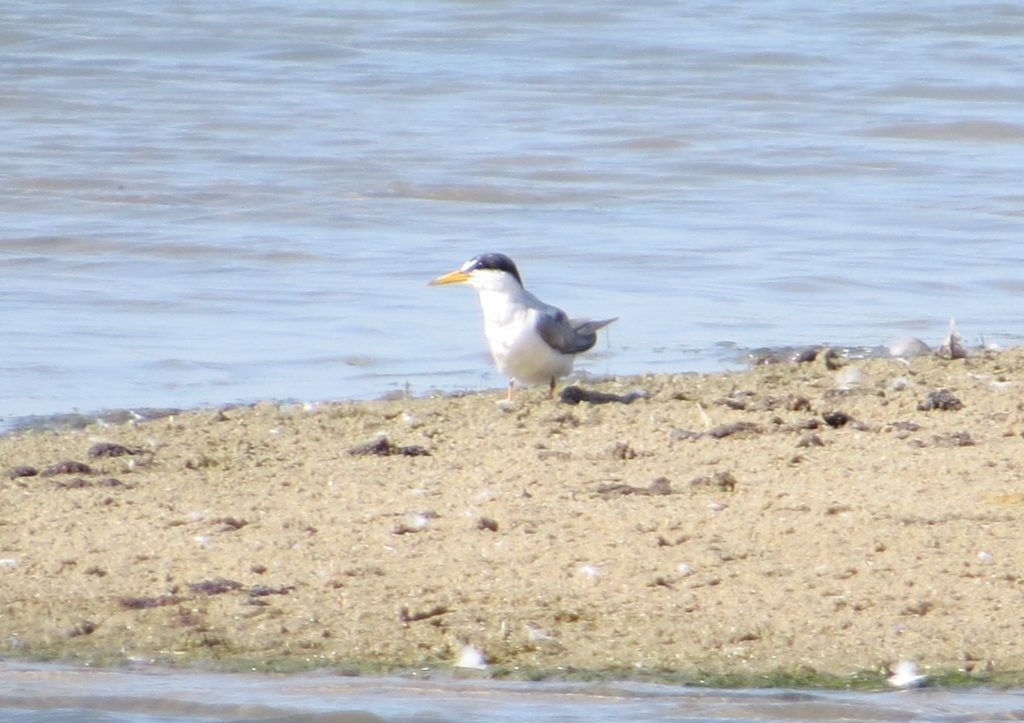 Getting a lifer at the first stop for that species keeps the non-birding family happy. And even better (for them) was that this bird only stuck around for 10 minutes before flying off forever.
Getting a lifer at the first stop for that species keeps the non-birding family happy. And even better (for them) was that this bird only stuck around for 10 minutes before flying off forever.
The plan for Day 2 of our trip was to meander our way from Omaha to Kansas City via the back roads in the hopes of turning up a Scissor-tailed Flycatcher, the number-one target of the trip. STFL is a rarity in southern Nebraska even though northern Kansas is part of its normal range. I decided to drive to a spot in southeastern Nebraska where a pair had nested in June. There hadn’t been reports for two months, but I figured it was worth a shot anyway. When we were still five miles from the site, I was shocked when a Scissor-tailed Flycatcher lifer flew across the road in front of us. Unfortunately we could not track it down for better looks, so it was a bittersweet sighting. I wasn’t worried because I picked a southerly route that would put us by several reported STFL sightings in Kansas. But one-by-one as we drove by those sites, I was getting worried. We weren’t having any luck. Common Nighthawks are nice, but this was supposed to be a Scissor-tailed Flycatcher on this wire.
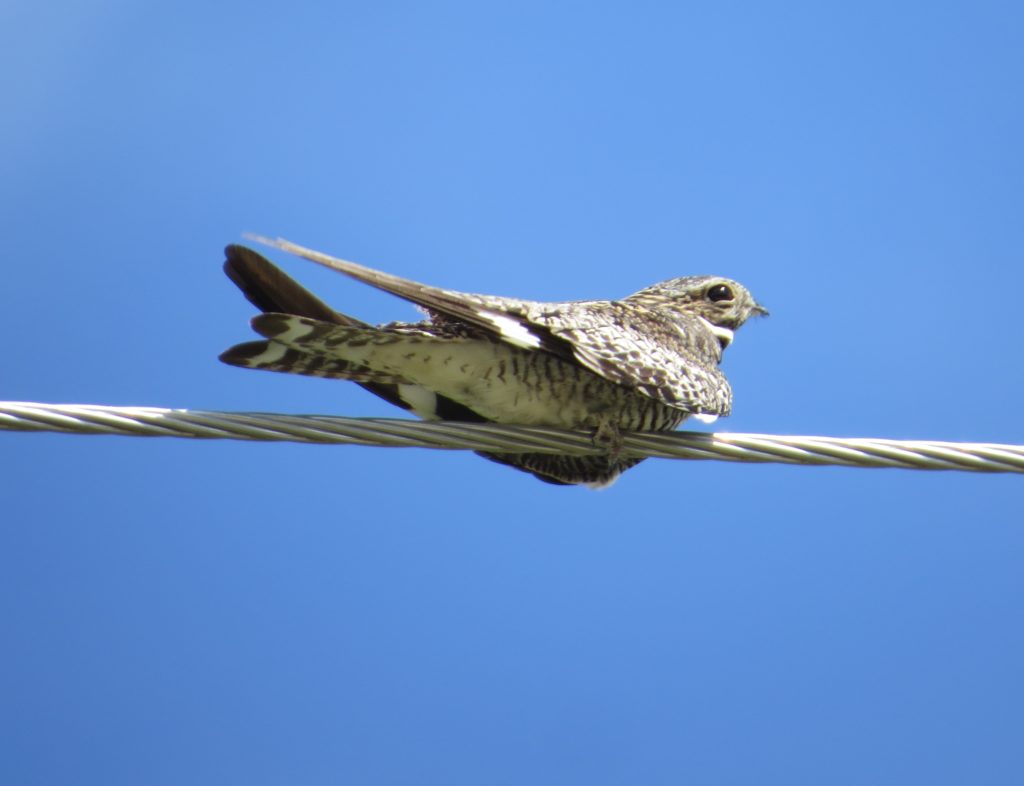
I was frustrated, but it was time to switch gears to look for another lifer at Baker Wetlands just outside of Lawrence, Kansas. The Little Blue Heron shows up in Minnesota every few years, but I haven’t connected with one yet. I was hoping to fix that here. It took awhile, but eventually we found a distant bird toward the far eastern end of the Baker Wetlands. I was going to settle for some blurry distant shots until Melissa noticed a service road that would put us closer to the bird. What a fantastic-looking Heron.
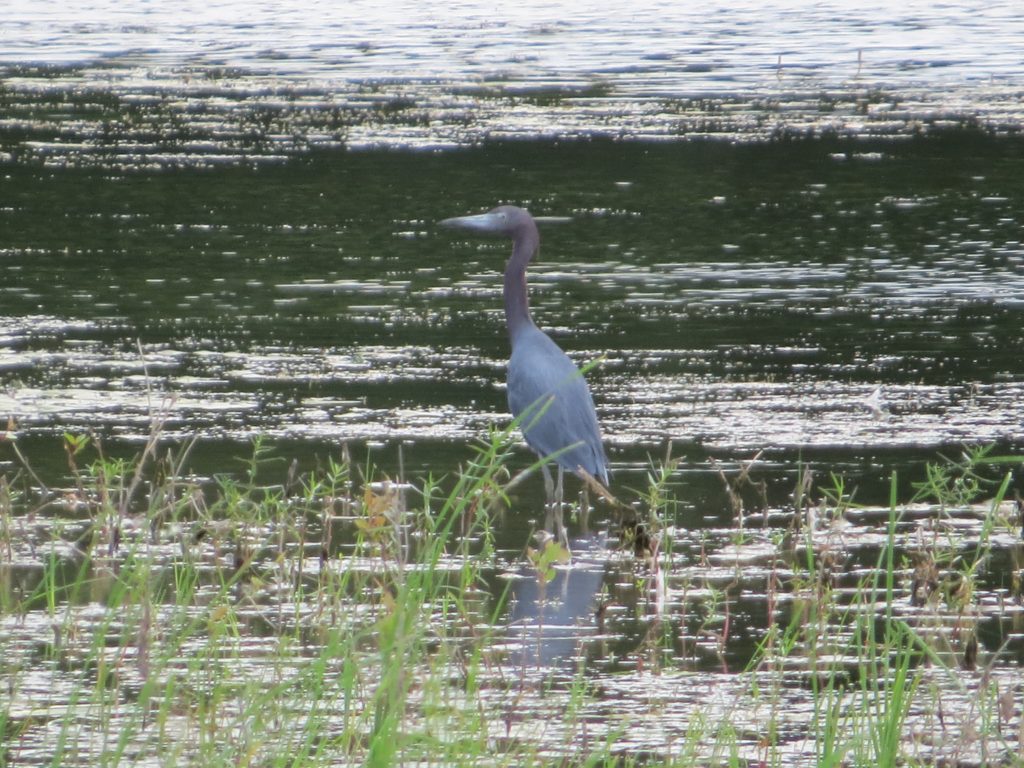
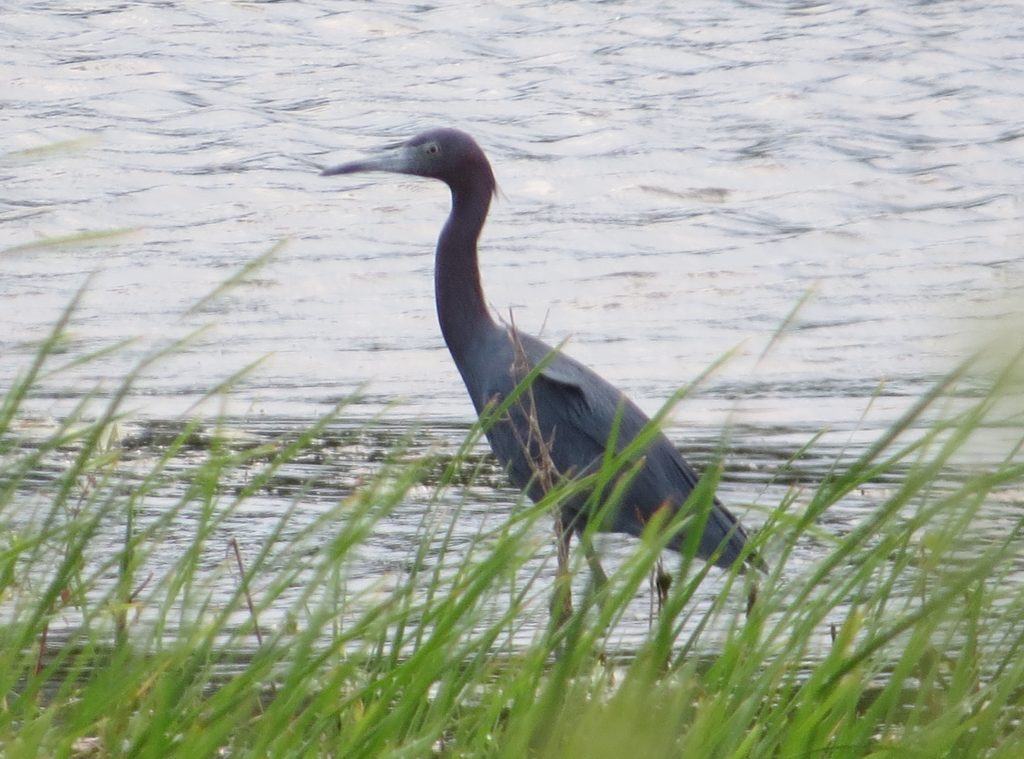 It was finally time to get to our hotel–Marin was getting antsy for a pool fix. The Heron lifer felt good, really good, but I was still bummed about the lack of Scissor-tailed Flycatchers. Then just 20 minutes from the hotel, I spied one on a fence and turned around for some looks. It was a STFL alright, but a nub-tailed one and not the big male I was hoping to see. Hopes for that, along with a few other birds, would have to be pinned on Day 3.
It was finally time to get to our hotel–Marin was getting antsy for a pool fix. The Heron lifer felt good, really good, but I was still bummed about the lack of Scissor-tailed Flycatchers. Then just 20 minutes from the hotel, I spied one on a fence and turned around for some looks. It was a STFL alright, but a nub-tailed one and not the big male I was hoping to see. Hopes for that, along with a few other birds, would have to be pinned on Day 3.
Day 3 would be an exciting one. My old friend and college roommate, Malcolm Gold, picked me up early that morning to help me find some of the birds I was looking for. Malcolm and I both got into birding long after college and have previously only birded once together back in 2013. Having lived in the KC area for a few years now, he knew where to go and was literally and figuratively in the driver’s seat for this outing. It was good to see Malcolm again and nice to be with a local who knew what he was doing. Malcolm thought we should try for a Painted Bunting right away along a brush-lined, somewhat abandoned road in an industrial area. While a PABU would be sweet to land on the life list, I knew that late August was pushing it for having this bird still be around. We never did find one, but Malcolm did point out a lifer of sorts, the Yellow-billed Cuckoo! Previously I had only ever heard one, so this was quite a treat to finally see one.
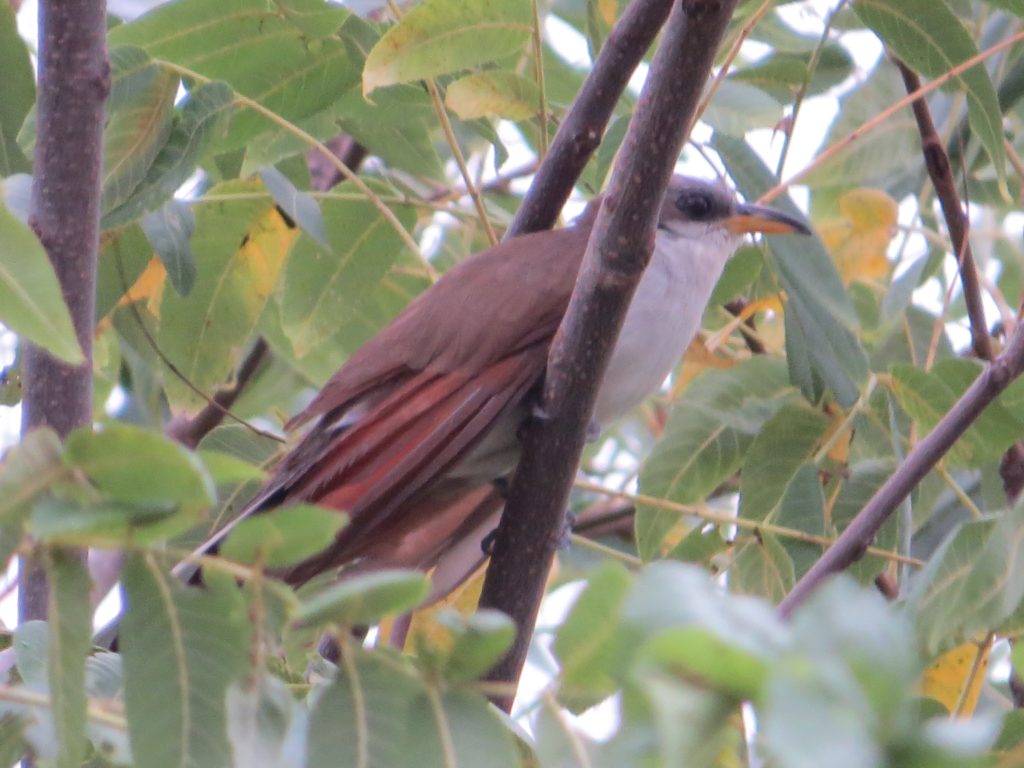
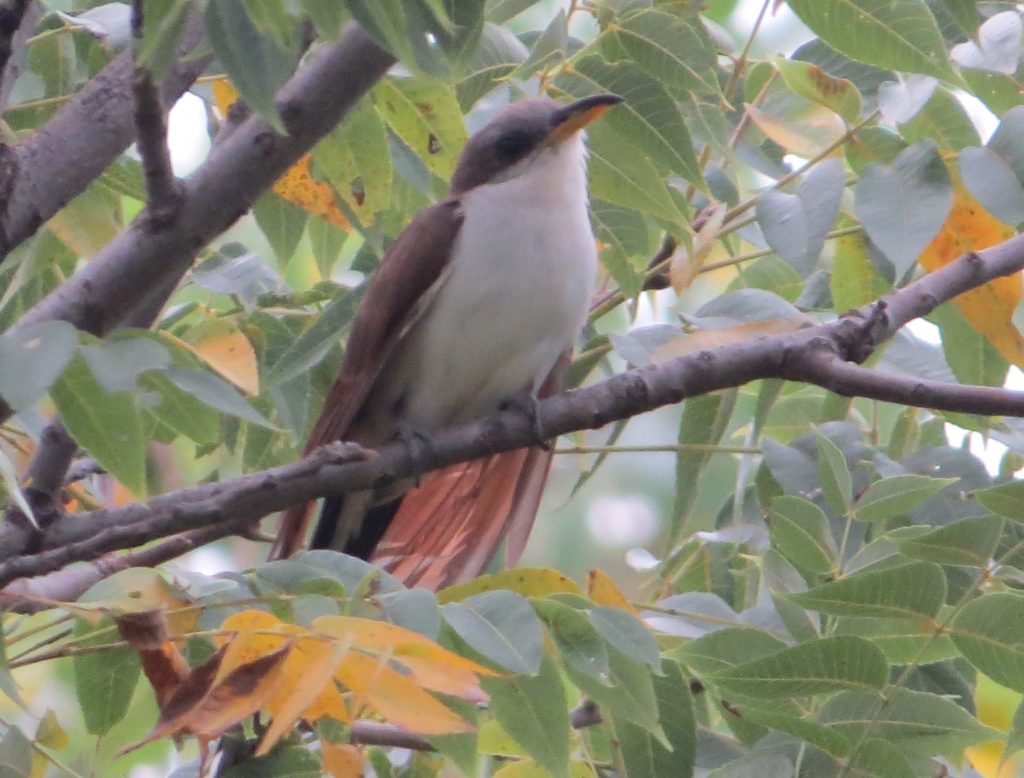 Shortly afterward we heard another hoped-for/expected lifer, the Carolina Wren. Eventually I got to see a couple of them. Their tea-kettle song is awesome.
Shortly afterward we heard another hoped-for/expected lifer, the Carolina Wren. Eventually I got to see a couple of them. Their tea-kettle song is awesome.
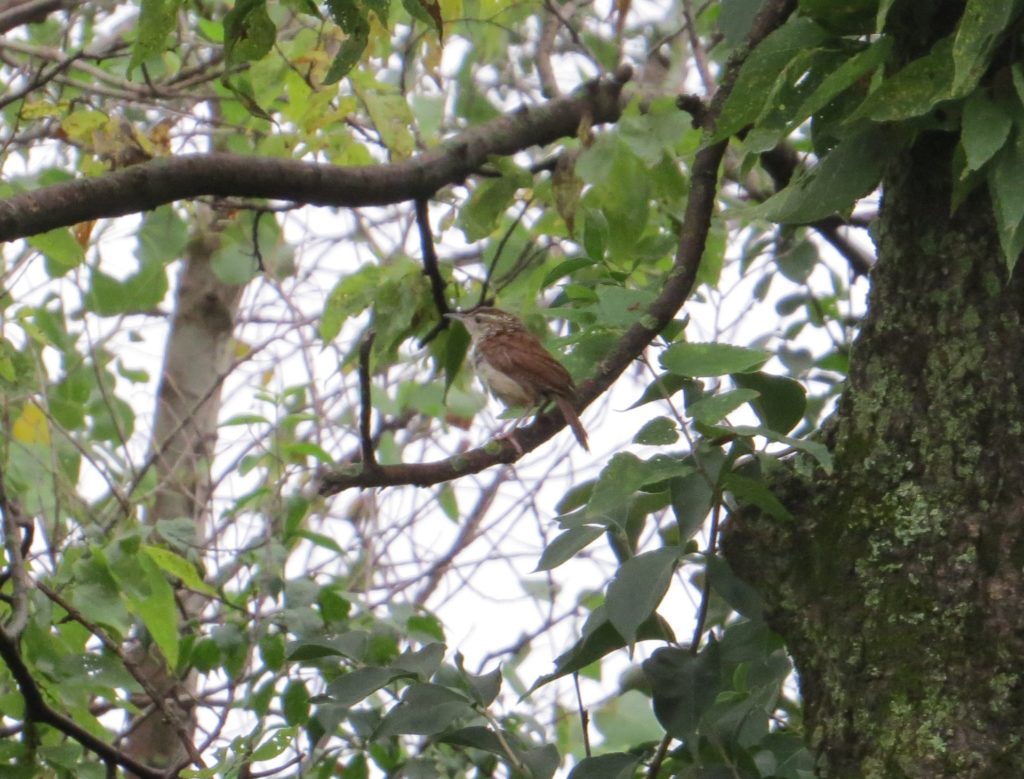 After giving up on the Painted Bunting search, we headed out into the countryside south of Kansas City. Malcolm had some ideas about where to find Scissor-tailed Flycatchers. And find them, we did.
After giving up on the Painted Bunting search, we headed out into the countryside south of Kansas City. Malcolm had some ideas about where to find Scissor-tailed Flycatchers. And find them, we did.
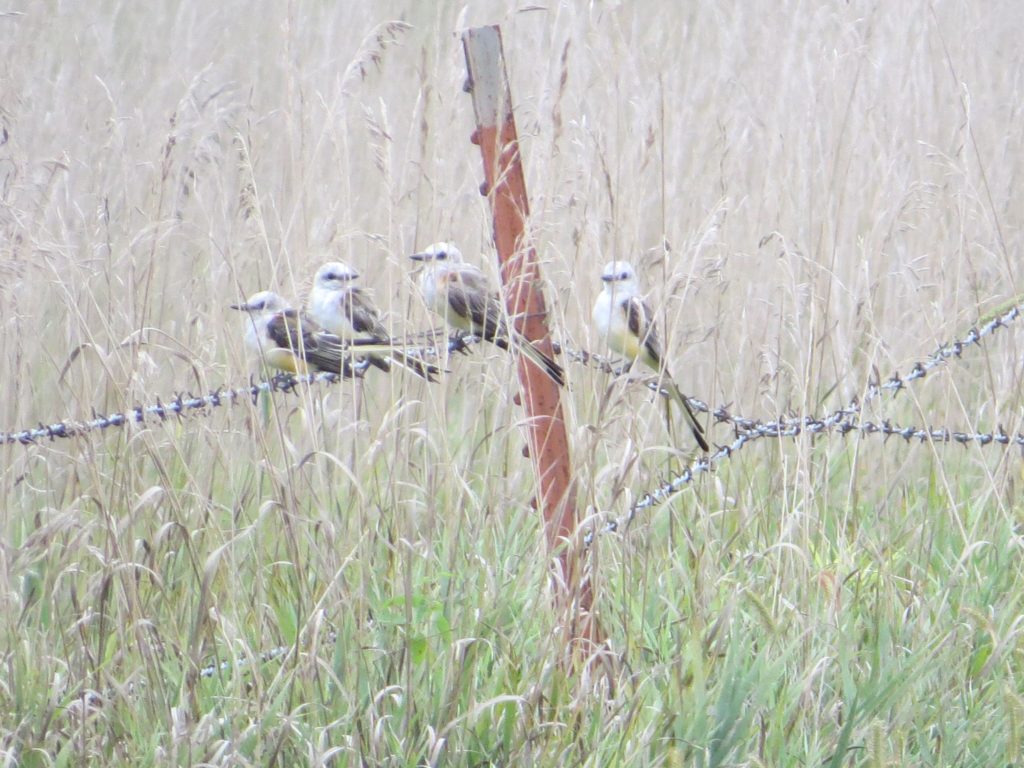 We never found any with super-long tails, but at one point we had about 30 of them all together on the wires and fences around us. It was a crazy, cool sight even if most were nubby.
We never found any with super-long tails, but at one point we had about 30 of them all together on the wires and fences around us. It was a crazy, cool sight even if most were nubby.
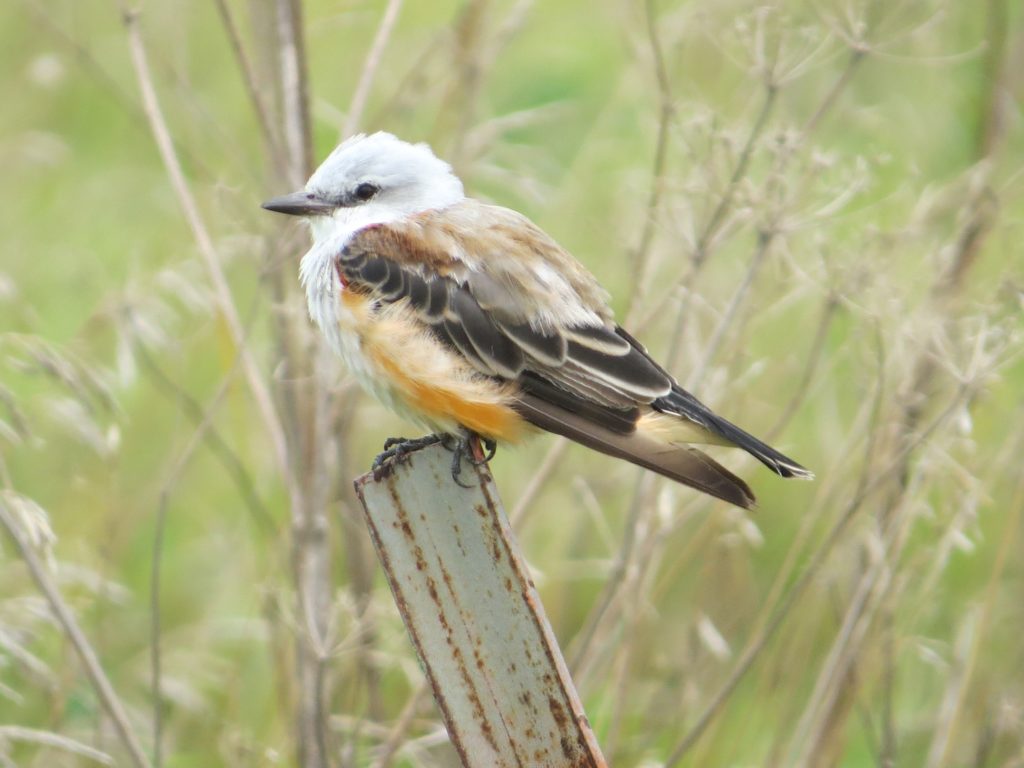 Some had tails of decent length, enough to showcase the big forked-tail when they flew.
Some had tails of decent length, enough to showcase the big forked-tail when they flew.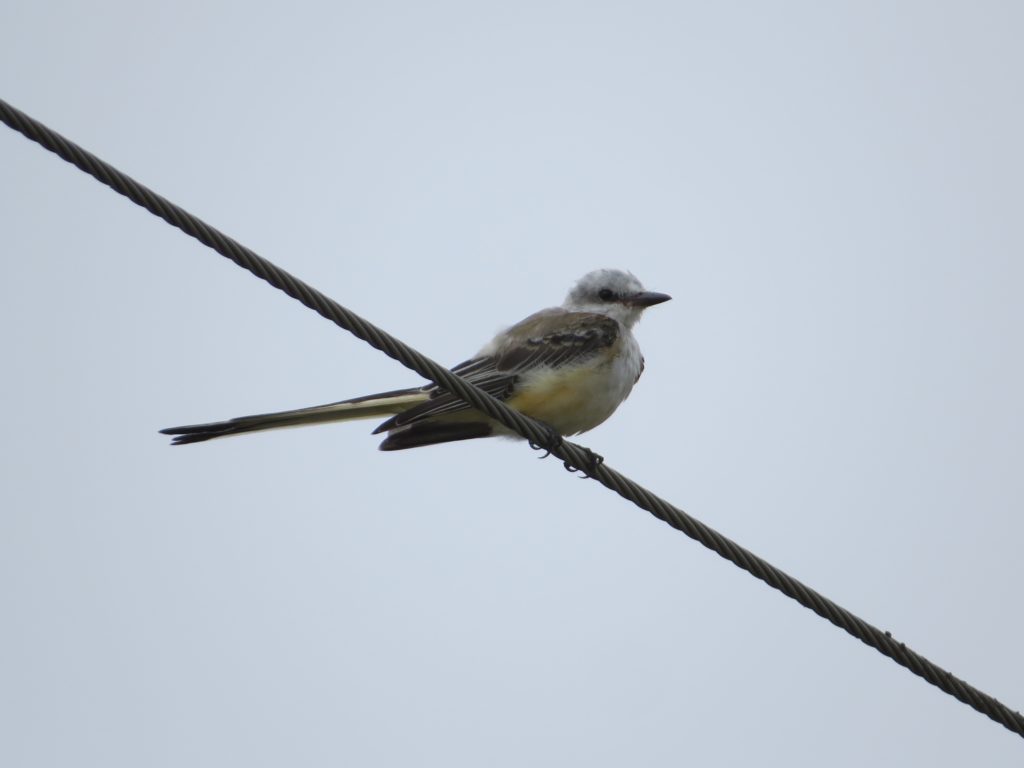
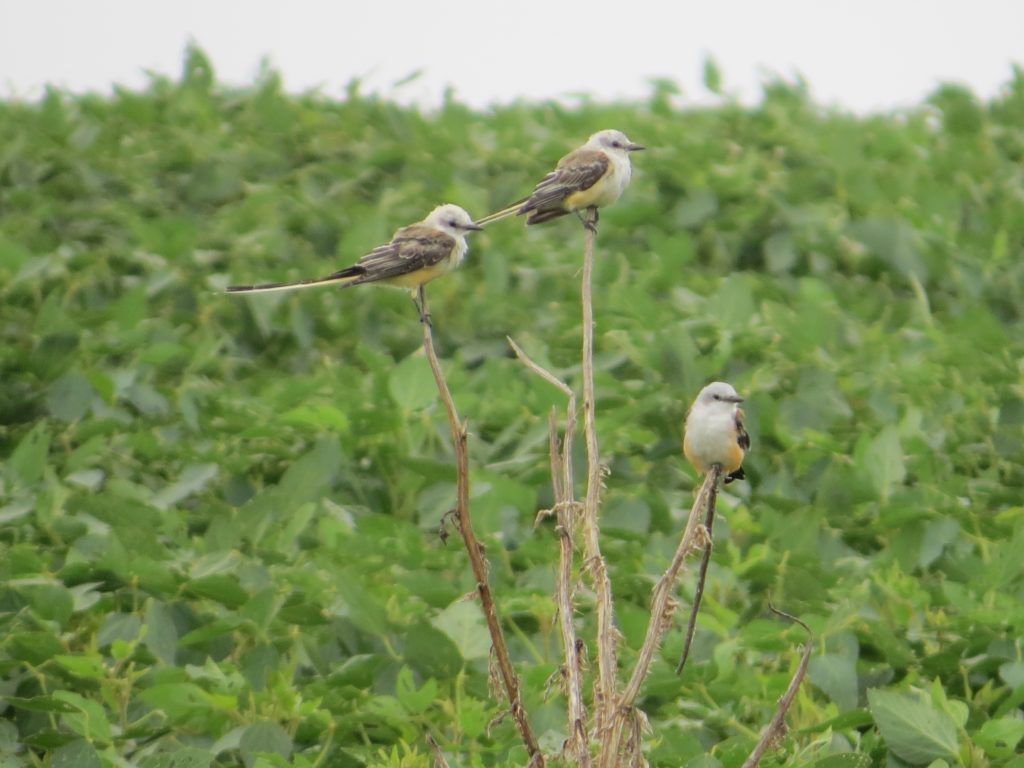 After enjoying the pile of Scissors for awhile, Malcolm took me to a spot to look/listen for Northern Bobwhite. We weren’t having any luck, so for the heck of it I tried playing a recording. Almost immediately a Northern Bobwhite called back! We never did see one, so this bird will have to enter the life list as a heard-only. I’m okay with that.
After enjoying the pile of Scissors for awhile, Malcolm took me to a spot to look/listen for Northern Bobwhite. We weren’t having any luck, so for the heck of it I tried playing a recording. Almost immediately a Northern Bobwhite called back! We never did see one, so this bird will have to enter the life list as a heard-only. I’m okay with that.
Here’s a tip for you when going on a trip like this: set aside a limited amount of time to go birding away from the family and stick to it; don’t get greedy. With just a little over an hour left to bird before I had to be back to the hotel at noon, Malcolm took me through some neighborhoods near our hotel to try to dig out a lifer Mississippi Kite. MIKI just wasn’t in the cards for us that day. Even though we were Kite-less, it was a great morning of birding with a friend. Thanks Malcolm! After he dropped me off, the agenda switched to getting some authentic KC barbecue and going to the K to see the Twins. On the way to the game I was 95% certain I saw a Mississippi Kite gliding above the freeway, but I didn’t claim it.
Day 4 was the return trip home. This time we would be taking the freeways to bust home quickly. Before we left town, though, I wanted to check along a certain street in the KC suburb of Shawnee for one last try at a Mississippi Kite. Almost right away we saw a raptor that looked odd to us lift off a pole. In fact, Evan who didn’t really know I was still looking for a Kite, piped up from the back seat, “Dad, I think I just saw a Mississippi Kite.” I thought so too, but we needed something better. After cruising up and down the street a couple times we finally had a no-doubt-about-it sighting as one flew over. After a couple more up-and-down passes on the street, we saw it again and this time it perched in someone’s backyard tree offering incredible views of our newest lifer.
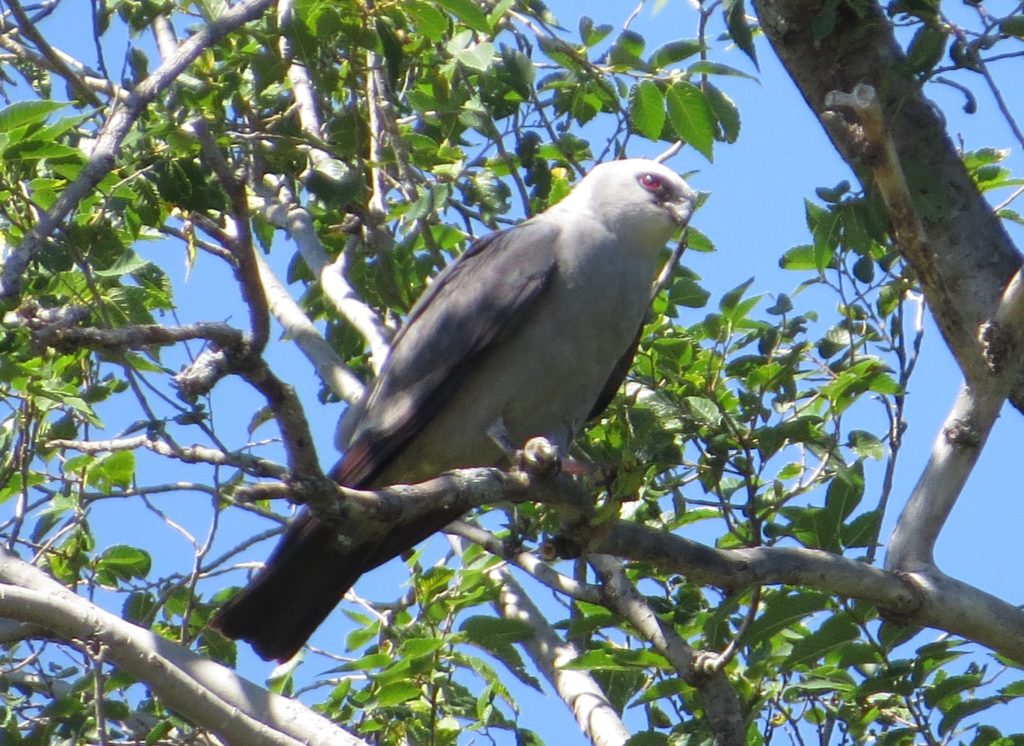 Malcolm had told me that MIKIs catch dragonflies on the wing, and that’s exactly what this one had done.
Malcolm had told me that MIKIs catch dragonflies on the wing, and that’s exactly what this one had done.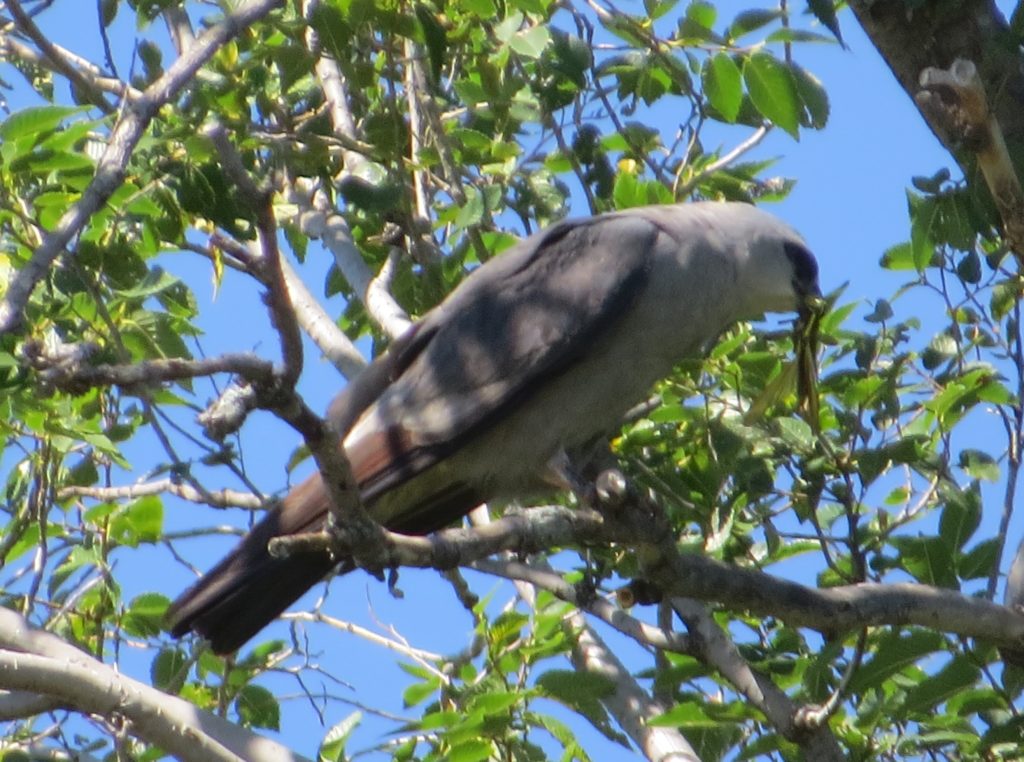 But then I noticed there was a juvenile MIKI. That dragonfly was the dinner that its mom or dad brought back for it.
But then I noticed there was a juvenile MIKI. That dragonfly was the dinner that its mom or dad brought back for it.
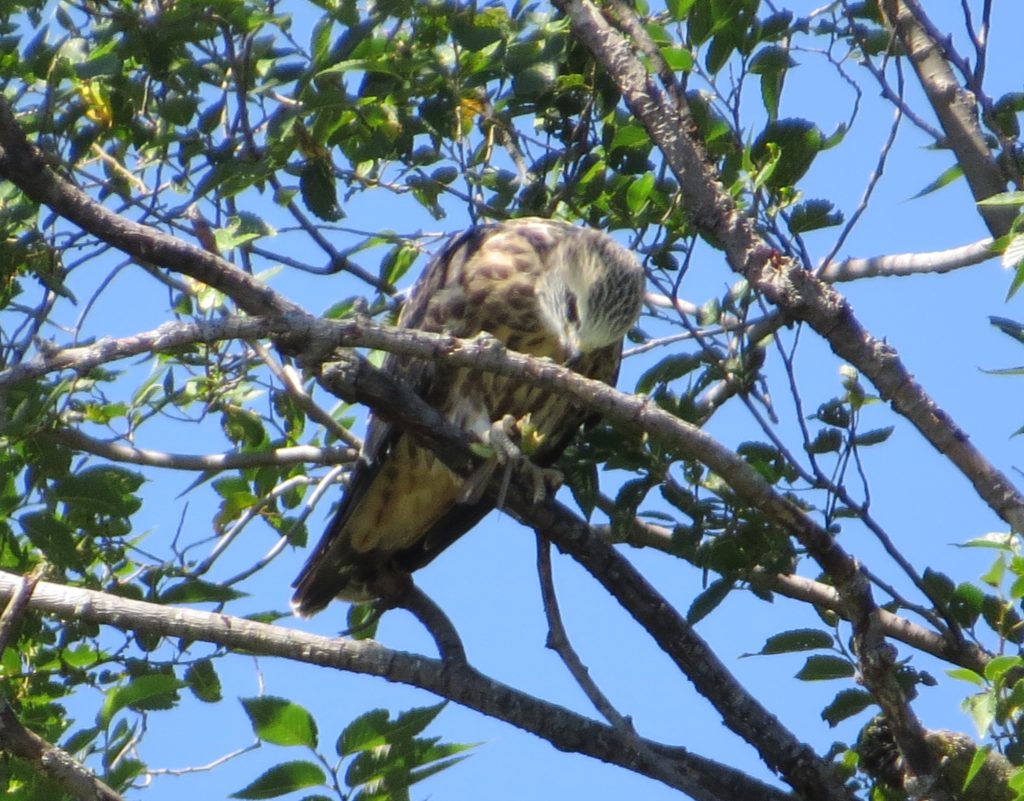
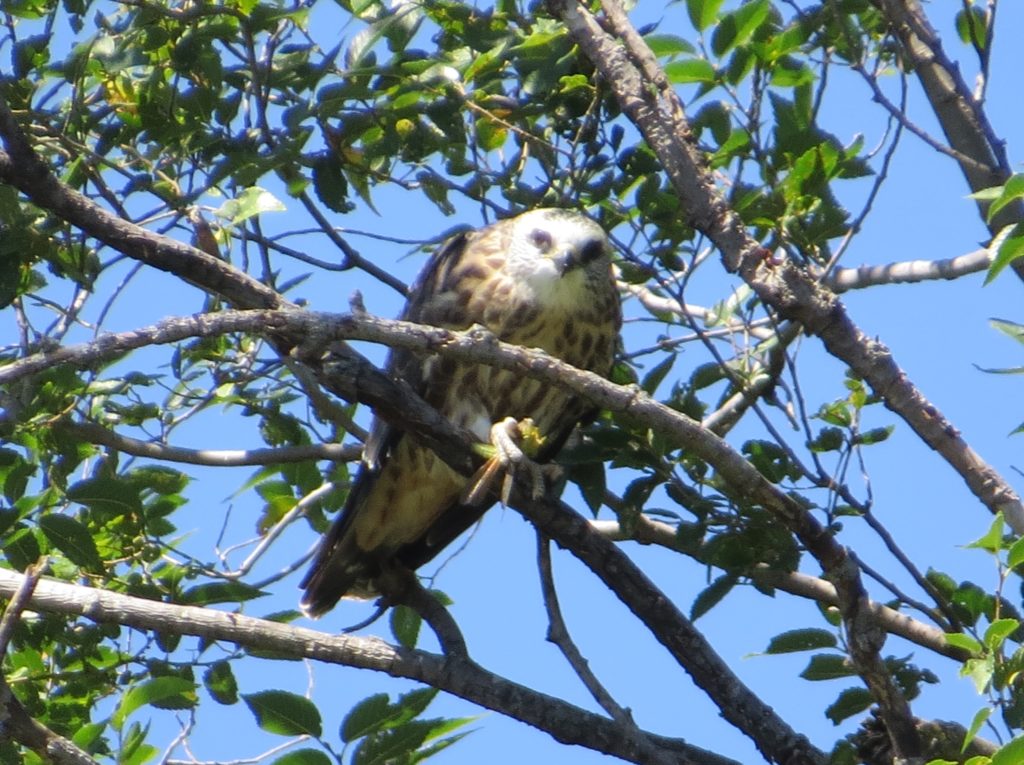 After the dragonfly transfer had been made, the adult took to the skies to find another. Seeing these birds glide around gracefully like their namesake is quite the sight.
After the dragonfly transfer had been made, the adult took to the skies to find another. Seeing these birds glide around gracefully like their namesake is quite the sight.
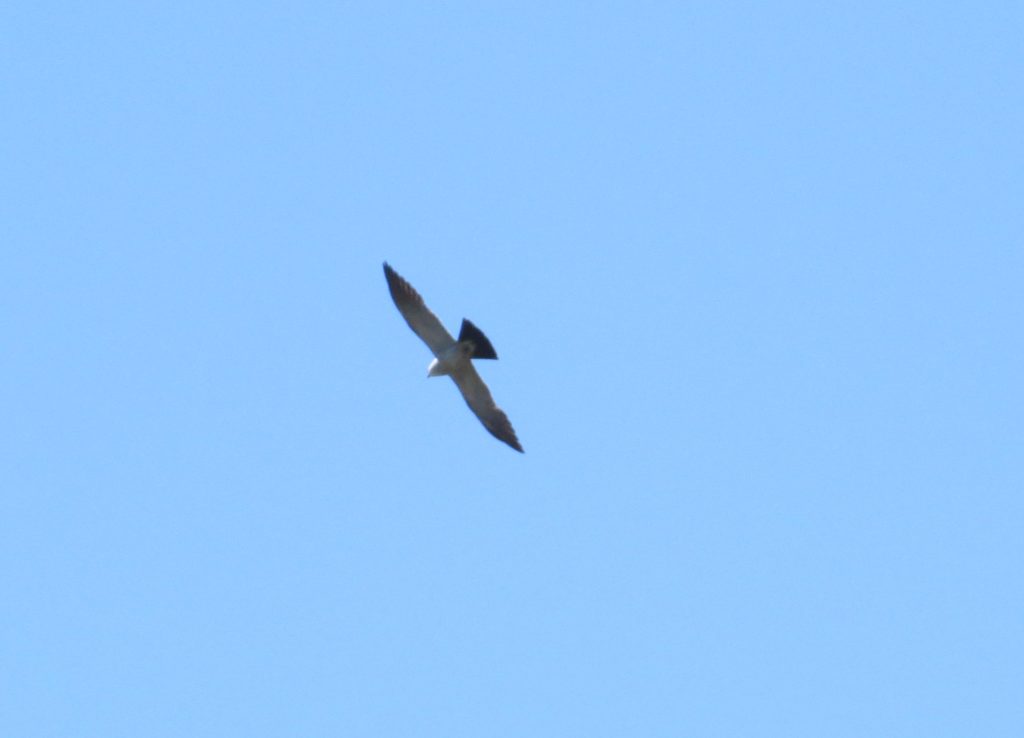
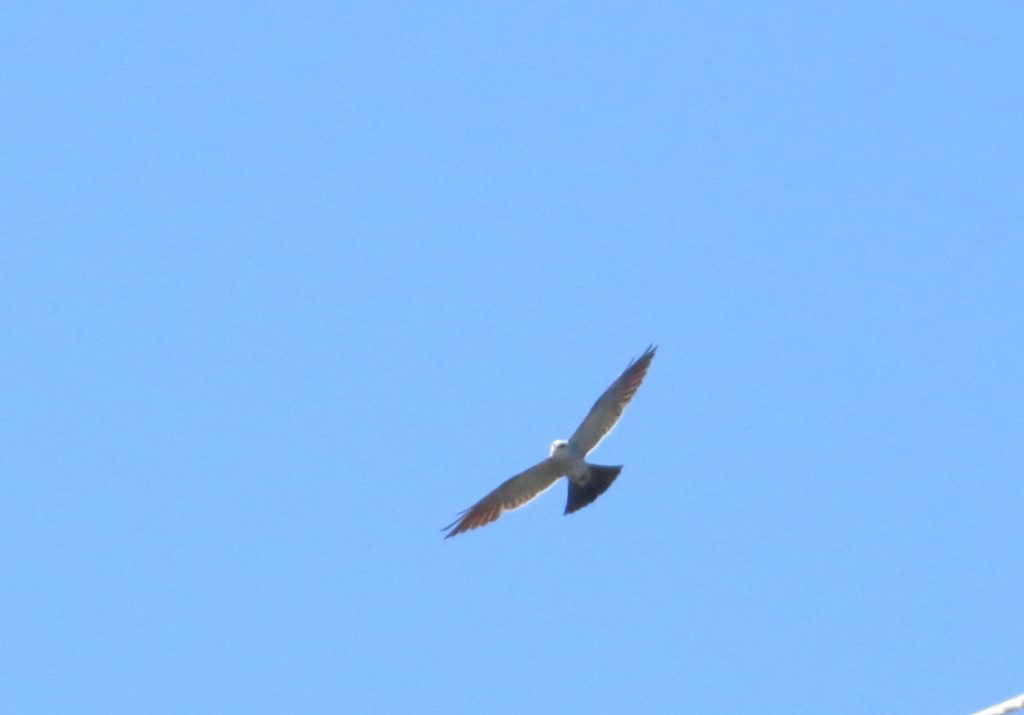 Having now seen one fly, Evan and I are certain we did see one the previous day on the way to the Twins game. This experience has also given me confidence that I would recognize this unique silhouette should I see it in the skies over Minnesota some day.
Having now seen one fly, Evan and I are certain we did see one the previous day on the way to the Twins game. This experience has also given me confidence that I would recognize this unique silhouette should I see it in the skies over Minnesota some day.
With the Mississippi Kite, I had now seen all the lifers I thought I had a chance of seeing on the KC adventure. It was a great way to finish the trip. There were six lifers in all, seven if you count the Cuckoo, and a lifer was seen on each of the four days we were gone. It was a great trip of baseball, pools, and birds. Everyone went home happy.
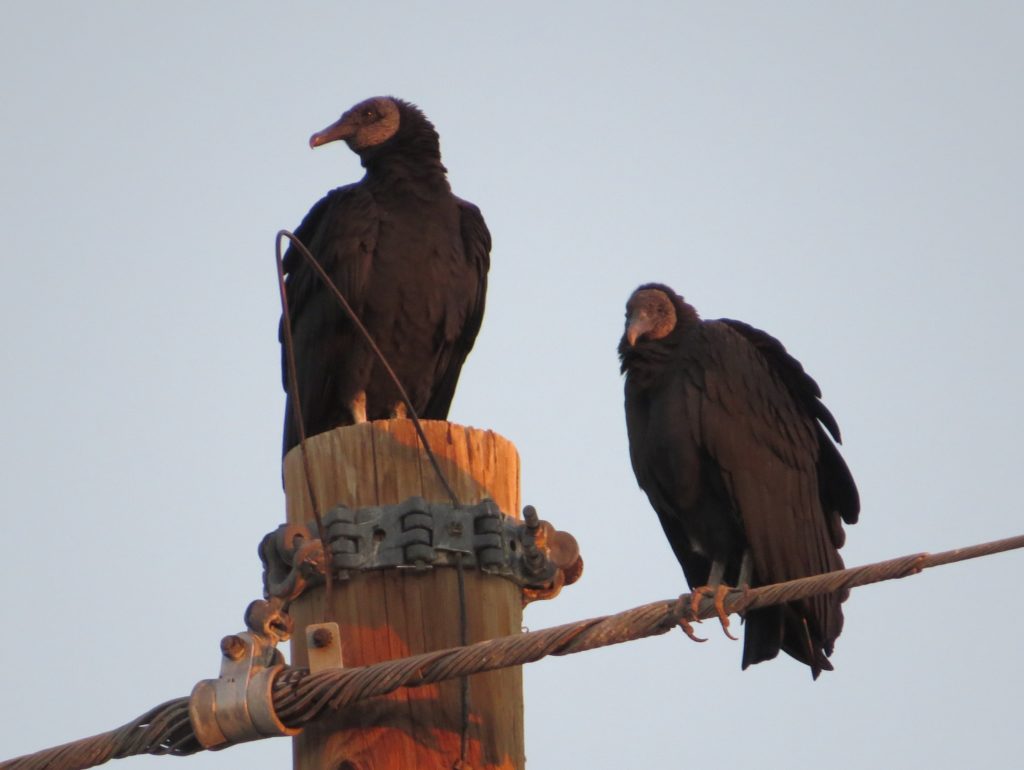
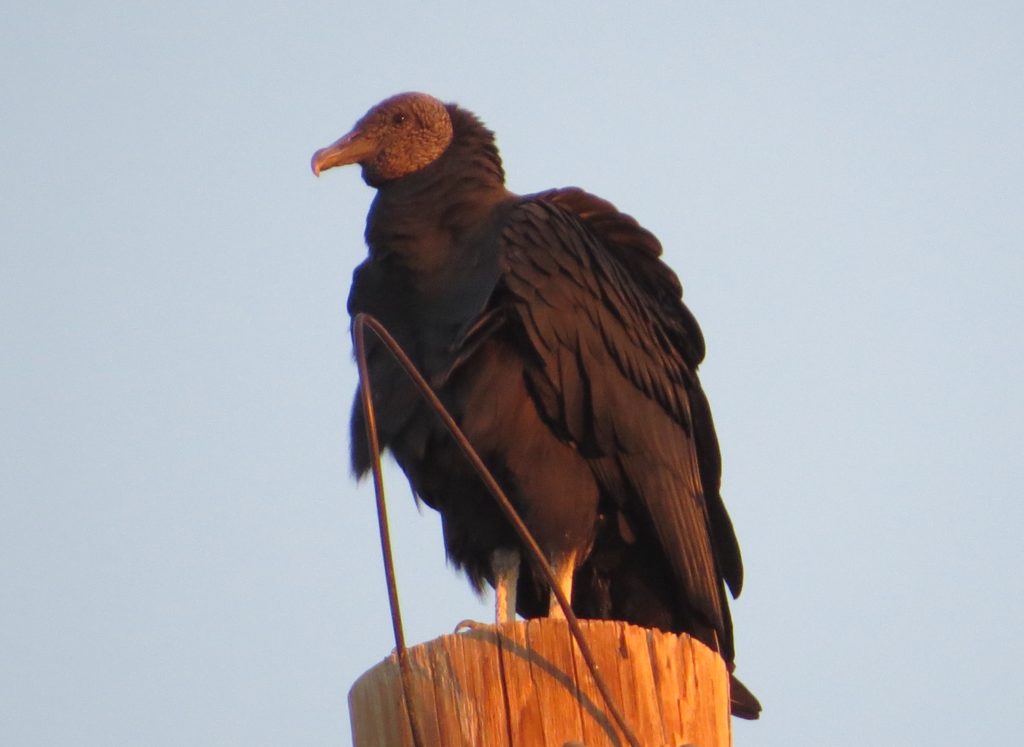 Eventually they did lift off allowing us to see the white “hands” of the underwing, but I wasn’t able to capture a photo of it. Later in the trip, though, I spied a small kettle of this new-to-me Vulture and was able to photograph them in flight.
Eventually they did lift off allowing us to see the white “hands” of the underwing, but I wasn’t able to capture a photo of it. Later in the trip, though, I spied a small kettle of this new-to-me Vulture and was able to photograph them in flight.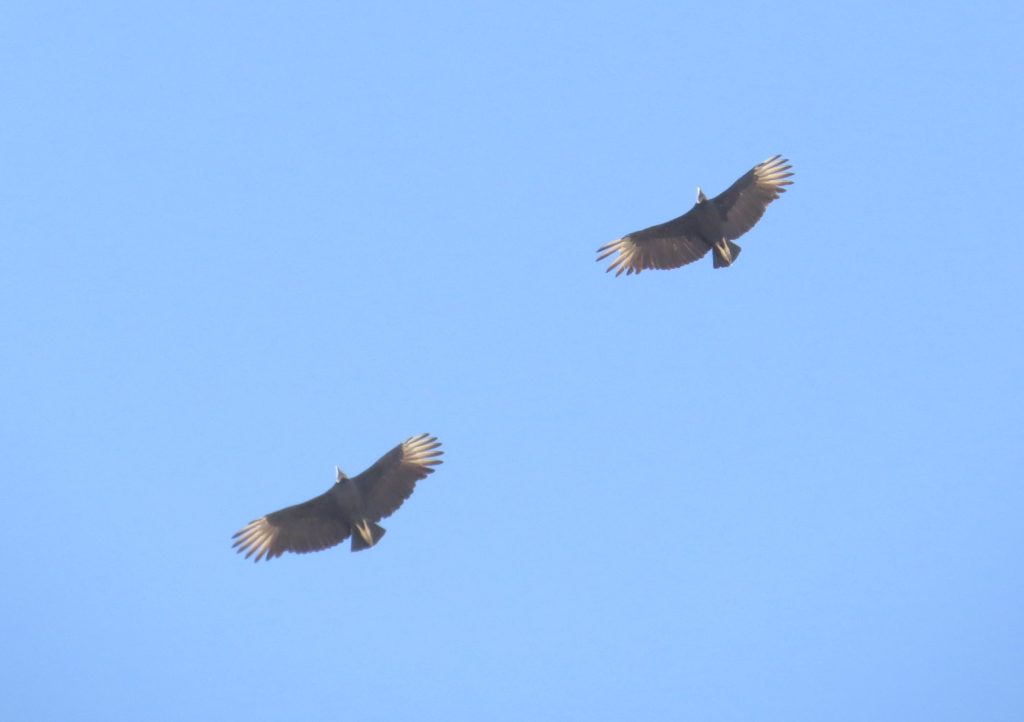 While I was Vulture-hunting with Dad and Gordon, Tommy called saying he had located the Tricolored Heron. So we headed over. Unfortunately it was distant and horribly back-lit and not providing the shocking, up-close looks a lot of birders have gotten of it recently. Tommy and I spent a lot of time trying to find a way to get closer to the bird but we were striking out. On our way out of GWR, we spotted it flying to a better location and I was able to get some photos.
While I was Vulture-hunting with Dad and Gordon, Tommy called saying he had located the Tricolored Heron. So we headed over. Unfortunately it was distant and horribly back-lit and not providing the shocking, up-close looks a lot of birders have gotten of it recently. Tommy and I spent a lot of time trying to find a way to get closer to the bird but we were striking out. On our way out of GWR, we spotted it flying to a better location and I was able to get some photos.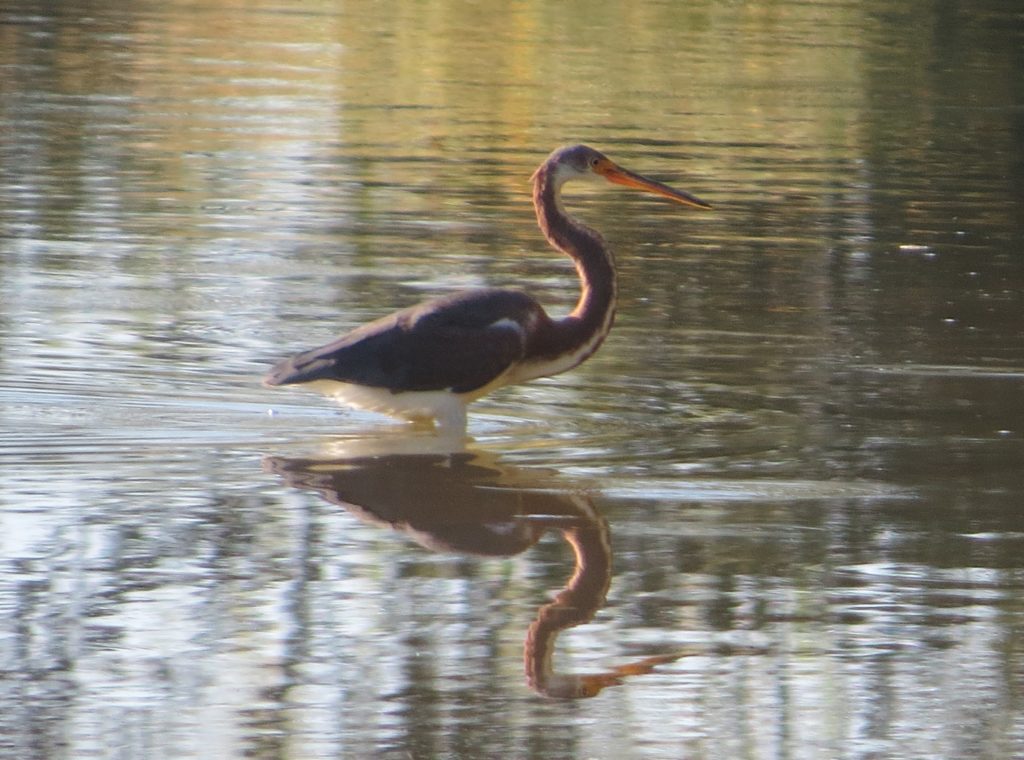 After this brief morning outing with the main objective birds secured, we parted company with Tommy and Gordon–we would all later be meeting up that evening in Madera Canyon in southern Arizona to go after the #1 bird of the trip. Once the family was all settled in our Green Valley hotel, Dad and I headed out once again to meet Tommy and Gordon at the Santa Rita Lodge. After watching a couple Magnificent Hummingbirds on the feeders, we decided to use the last half hour of daylight to try for one more lifer, a Rufous-winged Sparrow. Tommy knew just where to go, and he did not disappoint.
After this brief morning outing with the main objective birds secured, we parted company with Tommy and Gordon–we would all later be meeting up that evening in Madera Canyon in southern Arizona to go after the #1 bird of the trip. Once the family was all settled in our Green Valley hotel, Dad and I headed out once again to meet Tommy and Gordon at the Santa Rita Lodge. After watching a couple Magnificent Hummingbirds on the feeders, we decided to use the last half hour of daylight to try for one more lifer, a Rufous-winged Sparrow. Tommy knew just where to go, and he did not disappoint.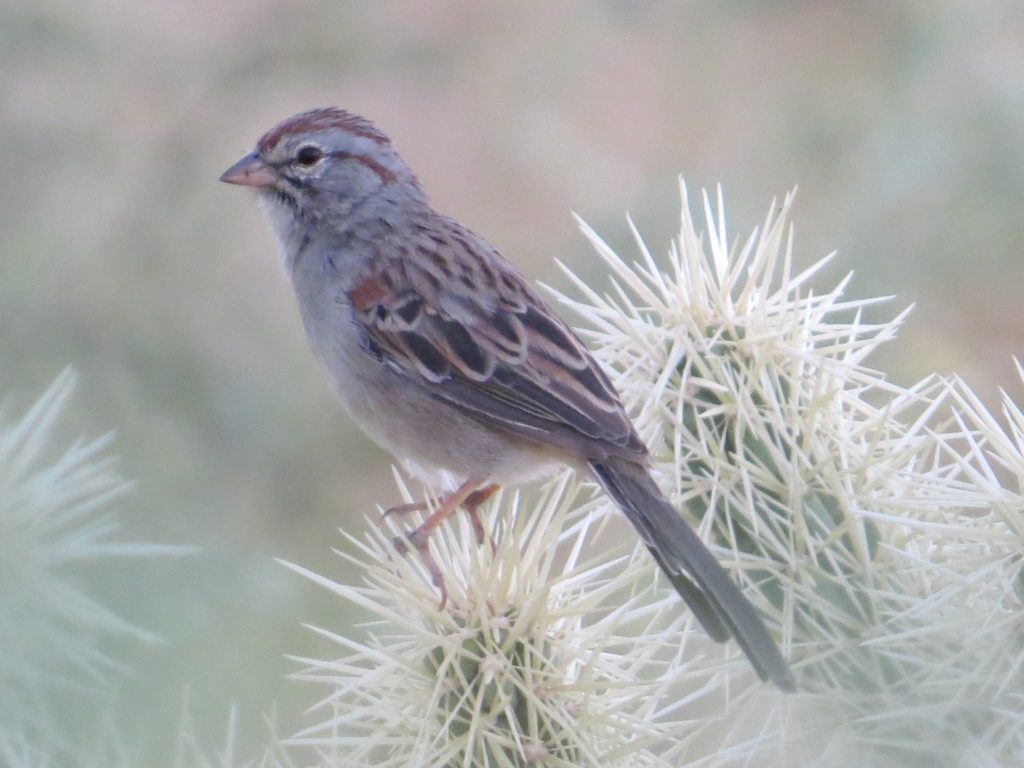
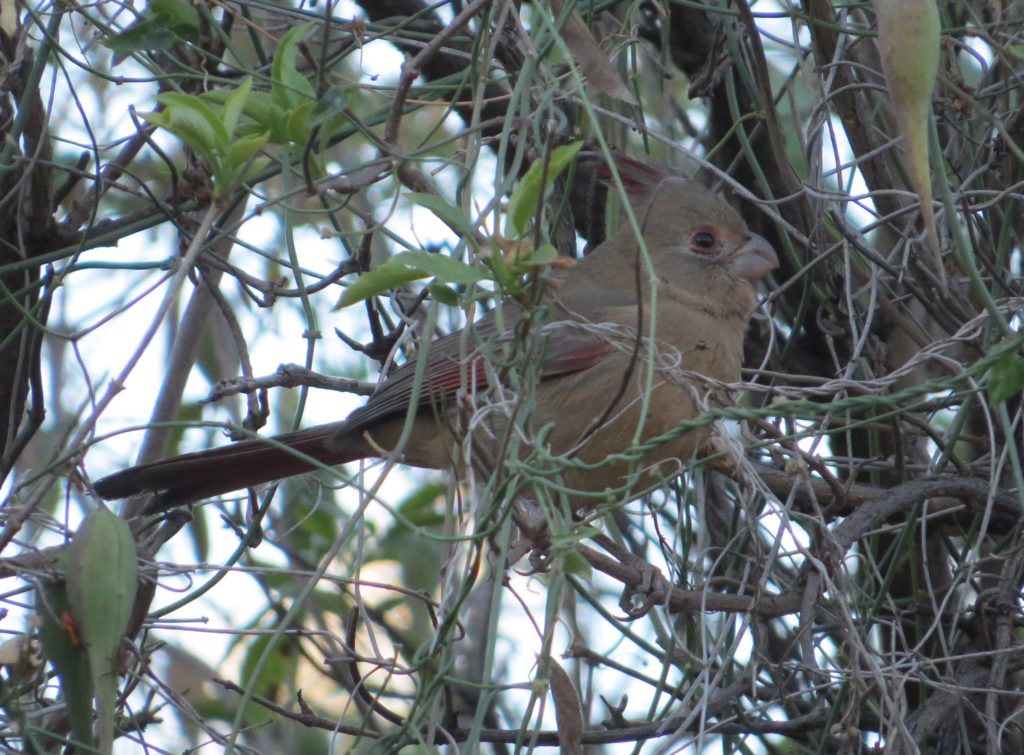 The only other lifer on this walk was a Gray Flycatcher that Tommy detected. I continue to be amazed by how much I find myself liking Empids.
The only other lifer on this walk was a Gray Flycatcher that Tommy detected. I continue to be amazed by how much I find myself liking Empids.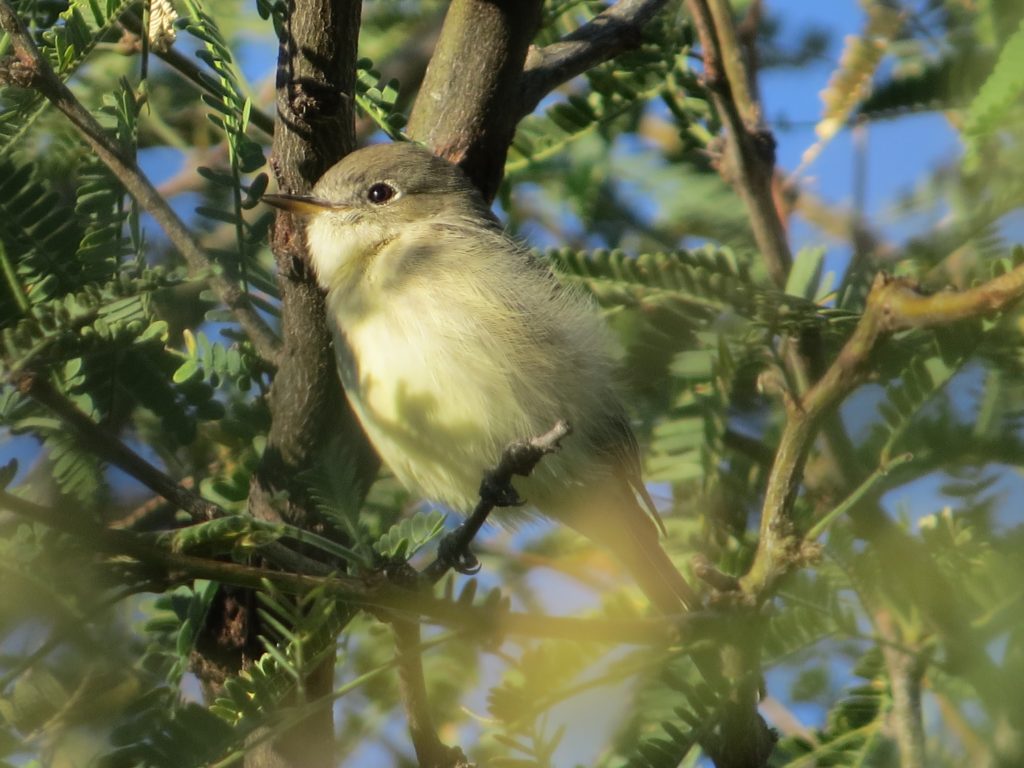 Finally, the last lifer is one I picked up in the desert scrub around the hotel. Lifering around the parking lot while waiting for the family has become sort of a tradition now. While last year I picked up Rock Wren and Cassin’s Kingbird lifers at the hotel, this year I found a cheerful little flock of Brewer’s Sparrows.
Finally, the last lifer is one I picked up in the desert scrub around the hotel. Lifering around the parking lot while waiting for the family has become sort of a tradition now. While last year I picked up Rock Wren and Cassin’s Kingbird lifers at the hotel, this year I found a cheerful little flock of Brewer’s Sparrows.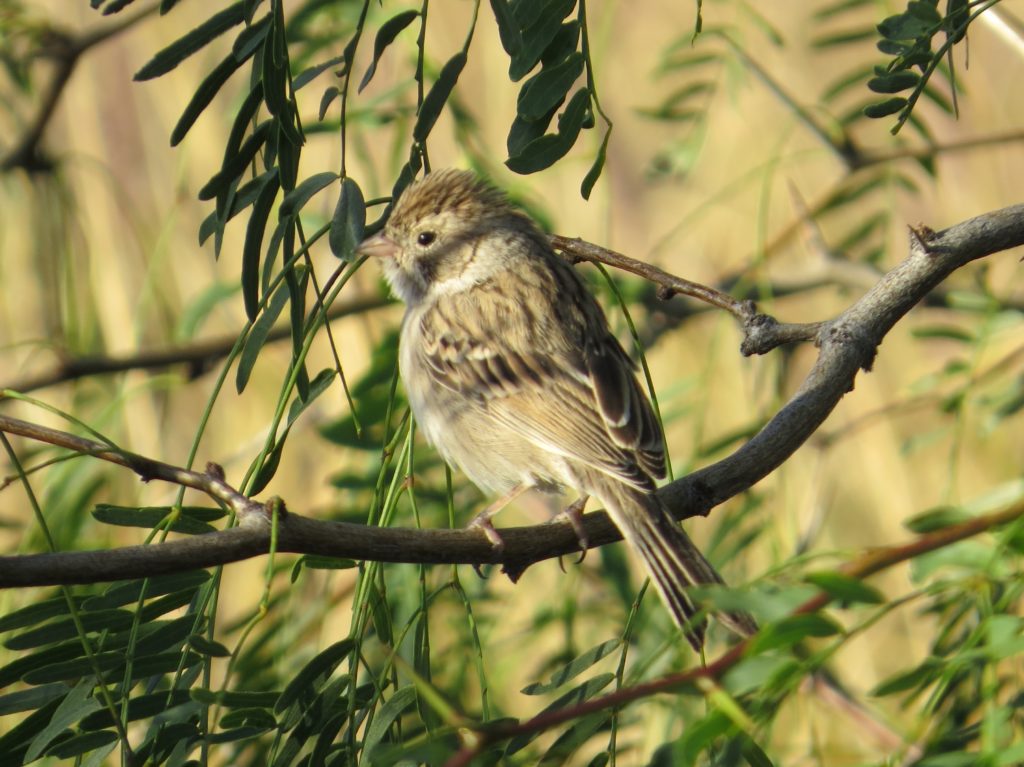 I’m saving the best for last and putting it in a post all on its own. Nightbirding usually means one thing: Owls. Coming up is a multimedia post of our successful night. Stay tuned!
I’m saving the best for last and putting it in a post all on its own. Nightbirding usually means one thing: Owls. Coming up is a multimedia post of our successful night. Stay tuned!
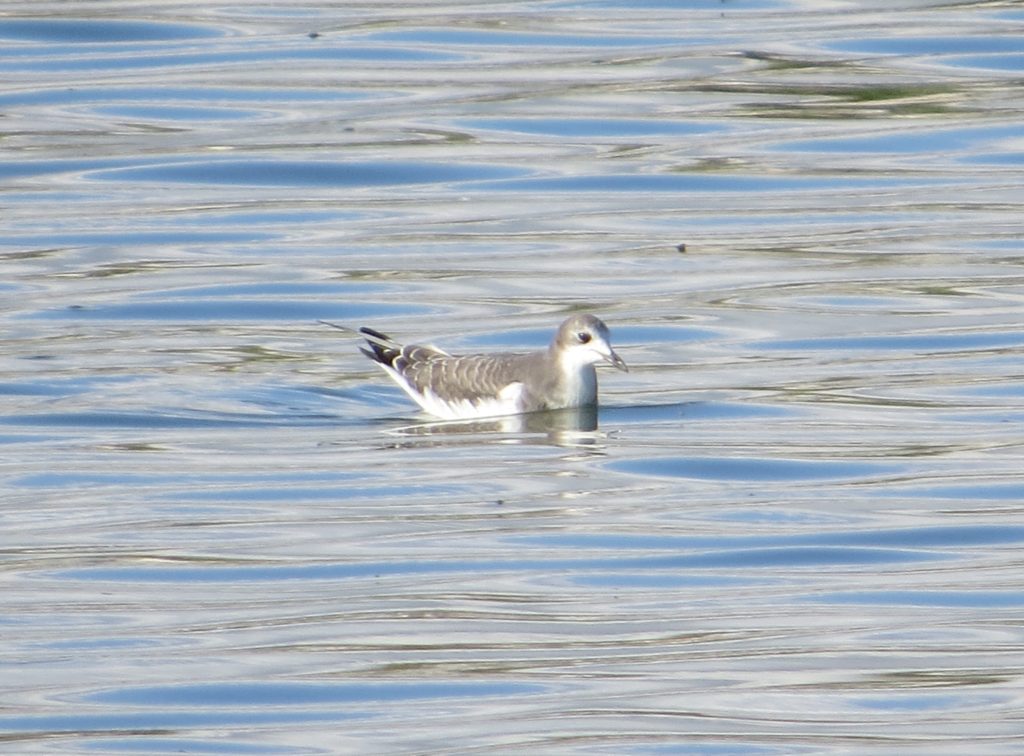
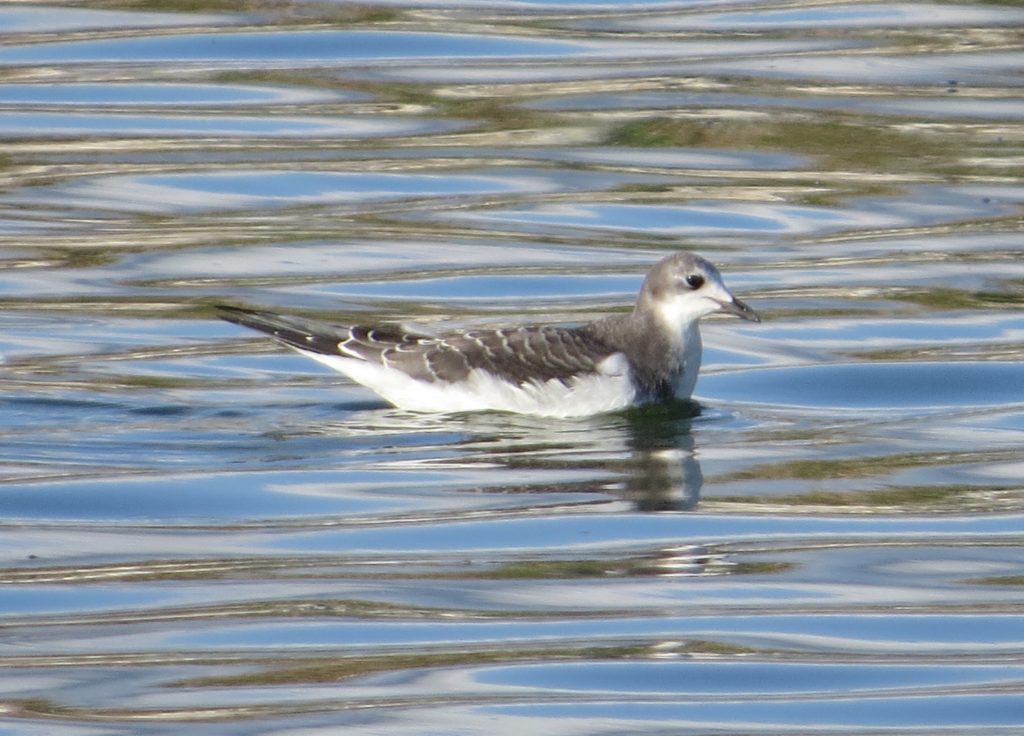 Sabine’s Gulls are a rare but expected species throughout the Minnesota during September. What wasn’t expected was a bird that turned up two weeks later in Carver County–a first state record Sharp-tailed Sandpiper, a bird from Siberia. They mostly show up in Alaska but are also seen occasionally in the lower 48 along the west coast. This find by Pete Hoeger and Bob Williams was absolutely remarkable. Consequently, Randy Frederickson and I chased this bird together after work on September 21st. The hordes were out in full force for this mega. Initially when we arrived, we and the 20 other people there couldn’t find it even though it had been spotted 10 minutes before we showed up. After a good 20 minutes filled with much internal panic everywhere, one of the birders got us on the bird. The wind, distance, and similar looking juvenile Pectoral Sandpipers made spotting and re-spotting the bird a tough task. Photography was a nightmare; I would have to settle for diagnostic photos in these conditions. But considering I never thought I would ever, ever see this bird in my life, I’m not complaining.
Sabine’s Gulls are a rare but expected species throughout the Minnesota during September. What wasn’t expected was a bird that turned up two weeks later in Carver County–a first state record Sharp-tailed Sandpiper, a bird from Siberia. They mostly show up in Alaska but are also seen occasionally in the lower 48 along the west coast. This find by Pete Hoeger and Bob Williams was absolutely remarkable. Consequently, Randy Frederickson and I chased this bird together after work on September 21st. The hordes were out in full force for this mega. Initially when we arrived, we and the 20 other people there couldn’t find it even though it had been spotted 10 minutes before we showed up. After a good 20 minutes filled with much internal panic everywhere, one of the birders got us on the bird. The wind, distance, and similar looking juvenile Pectoral Sandpipers made spotting and re-spotting the bird a tough task. Photography was a nightmare; I would have to settle for diagnostic photos in these conditions. But considering I never thought I would ever, ever see this bird in my life, I’m not complaining.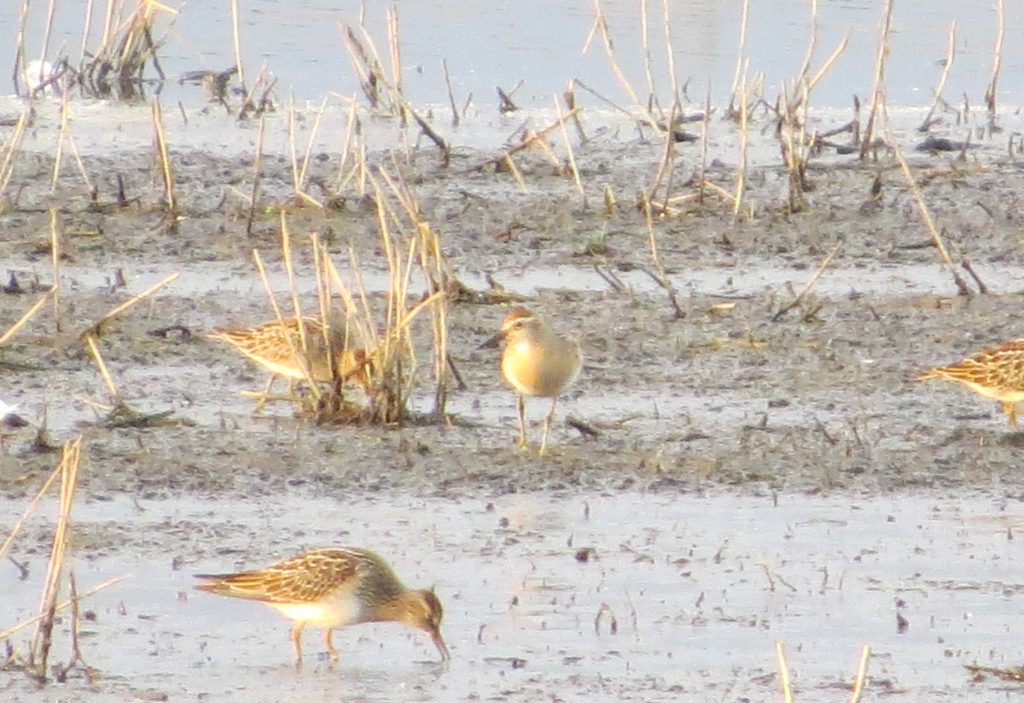
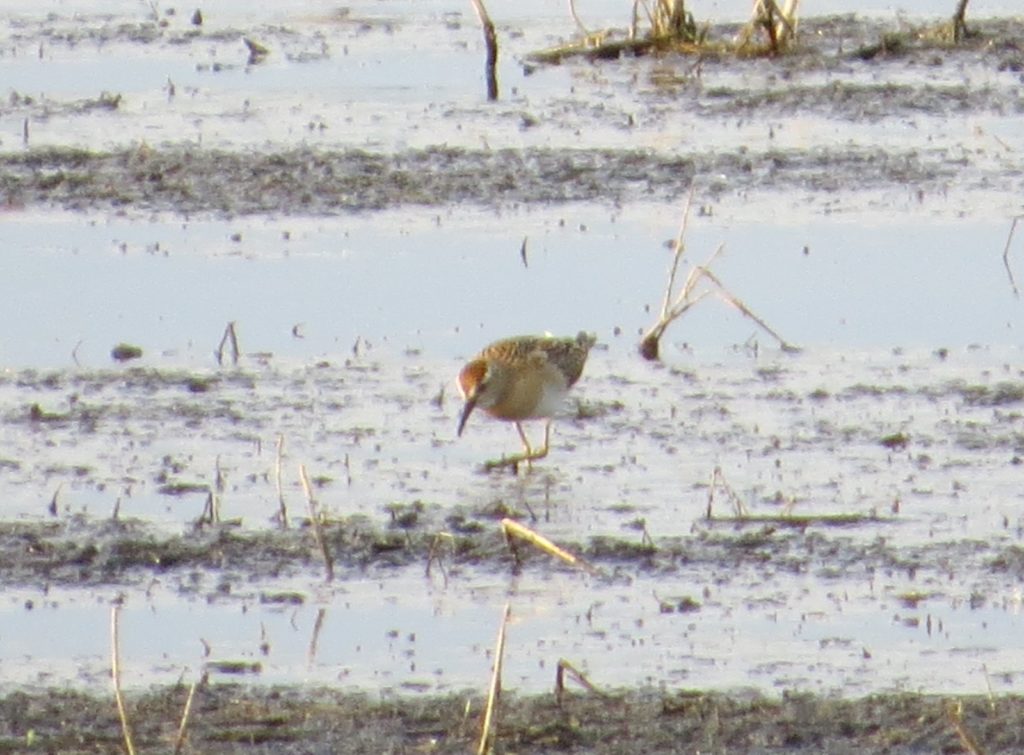 By birding standards I’ve actually been celebrating Birth Quarter instead of just Birth Month. The great birds have continued long past September. I’ve been to Arizona and back already, so there will be more stories of lifering and night-owling with the famous Tommy DeBardeleben of TOBY fame. There have also been good birds back home, including a new county record that I found. Lots of excitement coming at you on the blog in due time…
By birding standards I’ve actually been celebrating Birth Quarter instead of just Birth Month. The great birds have continued long past September. I’ve been to Arizona and back already, so there will be more stories of lifering and night-owling with the famous Tommy DeBardeleben of TOBY fame. There have also been good birds back home, including a new county record that I found. Lots of excitement coming at you on the blog in due time…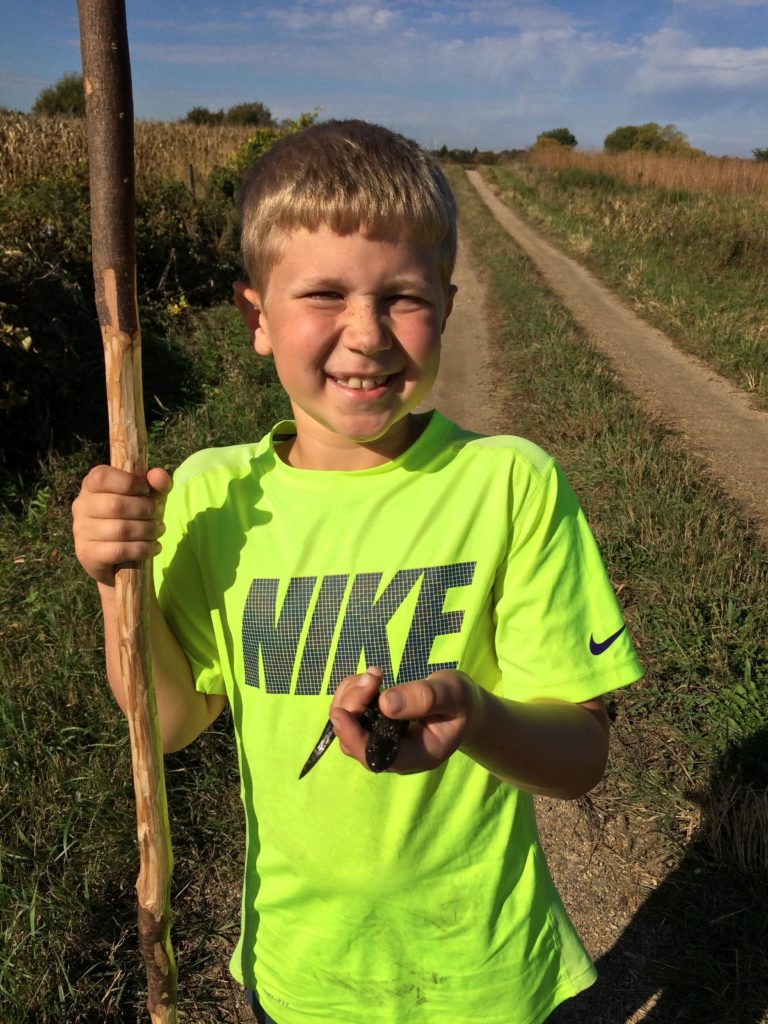 Evan was quite pleased to get his lifer Tiger Salamander. The Le Conte’s was just not a big deal to him. In fact, when I noticed a promising-looking patch of prairie that butted up to a cattail slough, he declined to walk it with me, opting instead to stand in one spot observing, whittling, etc. It was on this solo walk-about where the magical moment finally happened: I flushed a Sparrow from the prairie hillside toward the cattail slough in front of me. I advanced, somewhat hopeful, and stopped about 15 feet short of where it landed. I gave a little pish, and a yellowish bird popped up to investigate. I knew what it was before I even pulled up the binoculars. Then, with the sun at my back, I looked through the binoculars and finally saw this striking lifer. What a thrill–and to experience it so close to home made it even better. Not only did I finally get this lifer, but a little more pishing allowed me to get some photographs before it disappeared into the cattails forever.
Evan was quite pleased to get his lifer Tiger Salamander. The Le Conte’s was just not a big deal to him. In fact, when I noticed a promising-looking patch of prairie that butted up to a cattail slough, he declined to walk it with me, opting instead to stand in one spot observing, whittling, etc. It was on this solo walk-about where the magical moment finally happened: I flushed a Sparrow from the prairie hillside toward the cattail slough in front of me. I advanced, somewhat hopeful, and stopped about 15 feet short of where it landed. I gave a little pish, and a yellowish bird popped up to investigate. I knew what it was before I even pulled up the binoculars. Then, with the sun at my back, I looked through the binoculars and finally saw this striking lifer. What a thrill–and to experience it so close to home made it even better. Not only did I finally get this lifer, but a little more pishing allowed me to get some photographs before it disappeared into the cattails forever.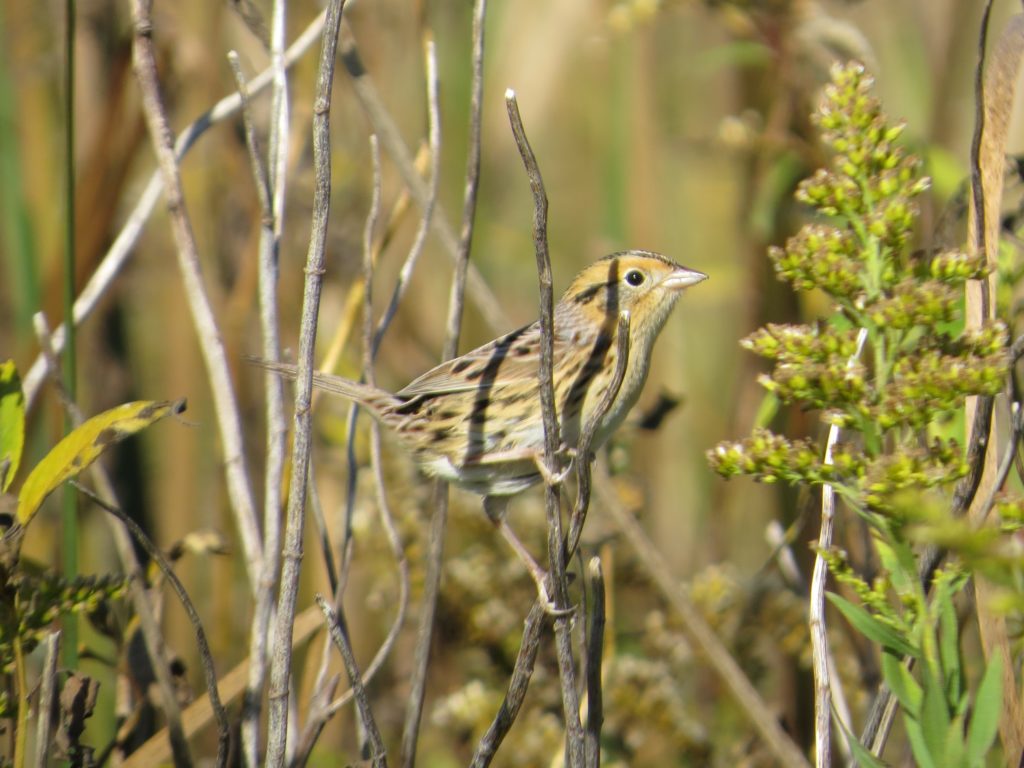
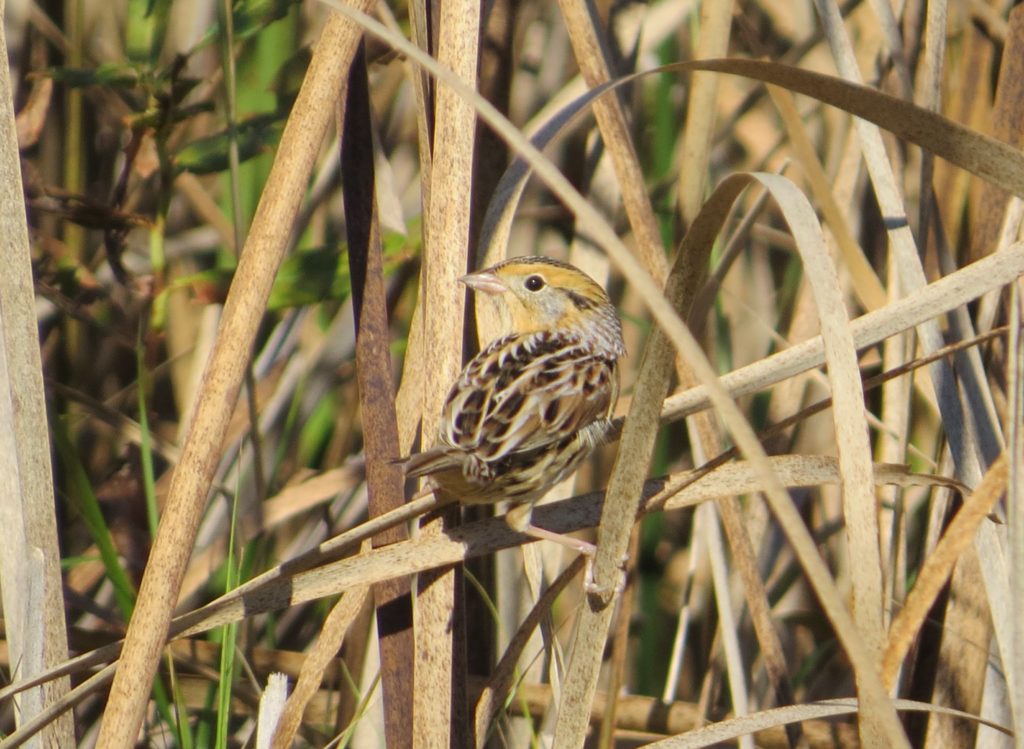 And with that I met back up with Evan and went home. It was perfect. Finding the last regular lifer I can possibly get in the county on such a beautiful day was bittersweet. I don’t know how many more lifers, if any, I will get in the county, but it doesn’t matter. This was a day to remember.
And with that I met back up with Evan and went home. It was perfect. Finding the last regular lifer I can possibly get in the county on such a beautiful day was bittersweet. I don’t know how many more lifers, if any, I will get in the county, but it doesn’t matter. This was a day to remember. That pretty much sealed the deal for them, but for added insurance I got seats which put Evan in a position of high probability to check off a major bucket-list item. It worked.
That pretty much sealed the deal for them, but for added insurance I got seats which put Evan in a position of high probability to check off a major bucket-list item. It worked. Having the entire family on the jumbo-tron and on TV was the icing.
Having the entire family on the jumbo-tron and on TV was the icing.
 I mean, seriously, an indoor/outdoor pool where you can actually swim under the freaking wall of the hotel–how cool is that? This is the kind of thing that blows kids’ minds.
I mean, seriously, an indoor/outdoor pool where you can actually swim under the freaking wall of the hotel–how cool is that? This is the kind of thing that blows kids’ minds. So what about the birds? Let’s get on with it then. I had a number of targets of regular breeders in this central part of the country. The first one I targeted is one that has caused me heartache on a couple of occasions in Minnesota, the Least Tern. Since this bird breeds in shallow rivers with sandbars, Omaha is a great place to go after them because of the nearby Platte River. Unfortunately, though, it was getting late in the year to find any, and my chances were slim. Regardless, we were going to give it a try, checking out a couple of spots on the way to our Omaha hotel. The first stop was a place I’d been watching on eBird for months and was eager to see, a sandpit lake in Fremont, Nebraska.
So what about the birds? Let’s get on with it then. I had a number of targets of regular breeders in this central part of the country. The first one I targeted is one that has caused me heartache on a couple of occasions in Minnesota, the Least Tern. Since this bird breeds in shallow rivers with sandbars, Omaha is a great place to go after them because of the nearby Platte River. Unfortunately, though, it was getting late in the year to find any, and my chances were slim. Regardless, we were going to give it a try, checking out a couple of spots on the way to our Omaha hotel. The first stop was a place I’d been watching on eBird for months and was eager to see, a sandpit lake in Fremont, Nebraska.
 I’ve been yearning to see that bright yellow-bill for awhile. My family waiting in the car probably didn’t even notice the fist-pumping going on outside over this lifer.
I’ve been yearning to see that bright yellow-bill for awhile. My family waiting in the car probably didn’t even notice the fist-pumping going on outside over this lifer. Getting a lifer at the first stop for that species keeps the non-birding family happy. And even better (for them) was that this bird only stuck around for 10 minutes before flying off forever.
Getting a lifer at the first stop for that species keeps the non-birding family happy. And even better (for them) was that this bird only stuck around for 10 minutes before flying off forever.

 It was finally time to get to our hotel–Marin was getting antsy for a pool fix. The Heron lifer felt good, really good, but I was still bummed about the lack of Scissor-tailed Flycatchers. Then just 20 minutes from the hotel, I spied one on a fence and turned around for some looks. It was a STFL alright, but a nub-tailed one and not the big male I was hoping to see. Hopes for that, along with a few other birds, would have to be pinned on Day 3.
It was finally time to get to our hotel–Marin was getting antsy for a pool fix. The Heron lifer felt good, really good, but I was still bummed about the lack of Scissor-tailed Flycatchers. Then just 20 minutes from the hotel, I spied one on a fence and turned around for some looks. It was a STFL alright, but a nub-tailed one and not the big male I was hoping to see. Hopes for that, along with a few other birds, would have to be pinned on Day 3.
 Shortly afterward we heard another hoped-for/expected lifer, the Carolina Wren. Eventually I got to see a couple of them. Their tea-kettle song is awesome.
Shortly afterward we heard another hoped-for/expected lifer, the Carolina Wren. Eventually I got to see a couple of them. Their tea-kettle song is awesome. After giving up on the Painted Bunting search, we headed out into the countryside south of Kansas City. Malcolm had some ideas about where to find Scissor-tailed Flycatchers. And find them, we did.
After giving up on the Painted Bunting search, we headed out into the countryside south of Kansas City. Malcolm had some ideas about where to find Scissor-tailed Flycatchers. And find them, we did. We never found any with super-long tails, but at one point we had about 30 of them all together on the wires and fences around us. It was a crazy, cool sight even if most were nubby.
We never found any with super-long tails, but at one point we had about 30 of them all together on the wires and fences around us. It was a crazy, cool sight even if most were nubby. Some had tails of decent length, enough to showcase the big forked-tail when they flew.
Some had tails of decent length, enough to showcase the big forked-tail when they flew.
 After enjoying the pile of Scissors for awhile, Malcolm took me to a spot to look/listen for Northern Bobwhite. We weren’t having any luck, so for the heck of it I tried playing a recording. Almost immediately a Northern Bobwhite called back! We never did see one, so this bird will have to enter the life list as a heard-only. I’m okay with that.
After enjoying the pile of Scissors for awhile, Malcolm took me to a spot to look/listen for Northern Bobwhite. We weren’t having any luck, so for the heck of it I tried playing a recording. Almost immediately a Northern Bobwhite called back! We never did see one, so this bird will have to enter the life list as a heard-only. I’m okay with that. Malcolm had told me that MIKIs catch dragonflies on the wing, and that’s exactly what this one had done.
Malcolm had told me that MIKIs catch dragonflies on the wing, and that’s exactly what this one had done. But then I noticed there was a juvenile MIKI. That dragonfly was the dinner that its mom or dad brought back for it.
But then I noticed there was a juvenile MIKI. That dragonfly was the dinner that its mom or dad brought back for it.
 After the dragonfly transfer had been made, the adult took to the skies to find another. Seeing these birds glide around gracefully like their namesake is quite the sight.
After the dragonfly transfer had been made, the adult took to the skies to find another. Seeing these birds glide around gracefully like their namesake is quite the sight.
 Having now seen one fly, Evan and I are certain we did see one the previous day on the way to the Twins game. This experience has also given me confidence that I would recognize this unique silhouette should I see it in the skies over Minnesota some day.
Having now seen one fly, Evan and I are certain we did see one the previous day on the way to the Twins game. This experience has also given me confidence that I would recognize this unique silhouette should I see it in the skies over Minnesota some day.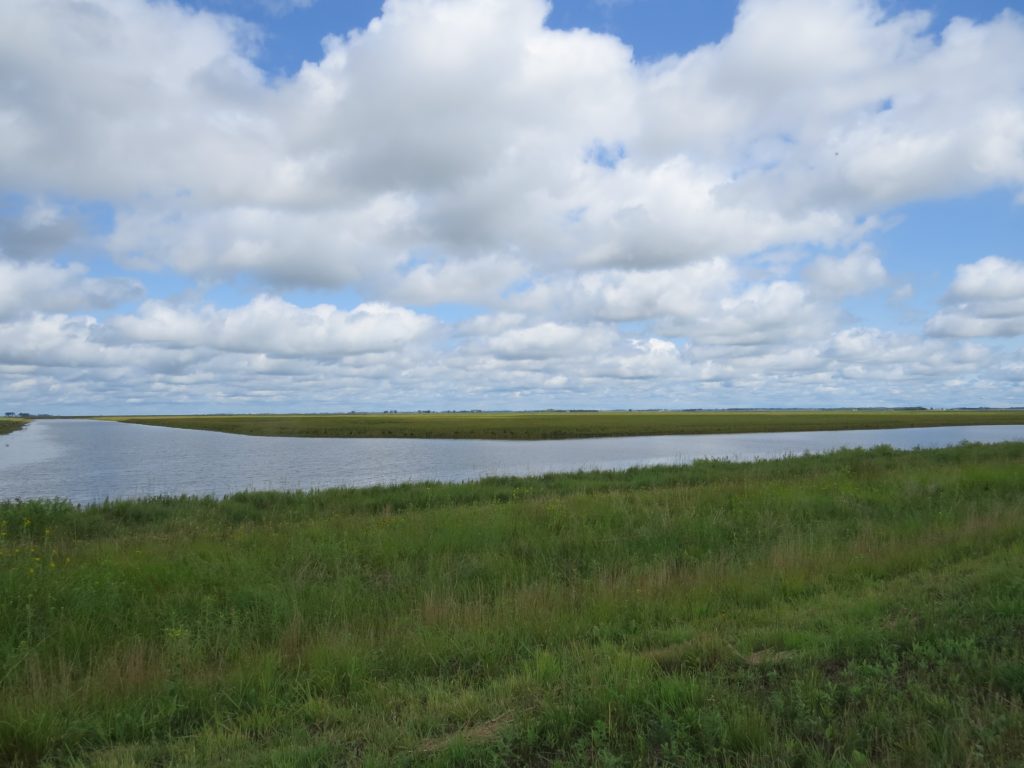 It was fun to return to this area. Two years prior, Randy Frederickson, Evan, and I came up here for a tidy haul of good birds in one trip: White-winged Dove, Cattle Egrets, Black-necked Stilts, and Loggerhead Shrike. This time I was looking for another great gift from Grant, and luckily, I found it.
It was fun to return to this area. Two years prior, Randy Frederickson, Evan, and I came up here for a tidy haul of good birds in one trip: White-winged Dove, Cattle Egrets, Black-necked Stilts, and Loggerhead Shrike. This time I was looking for another great gift from Grant, and luckily, I found it.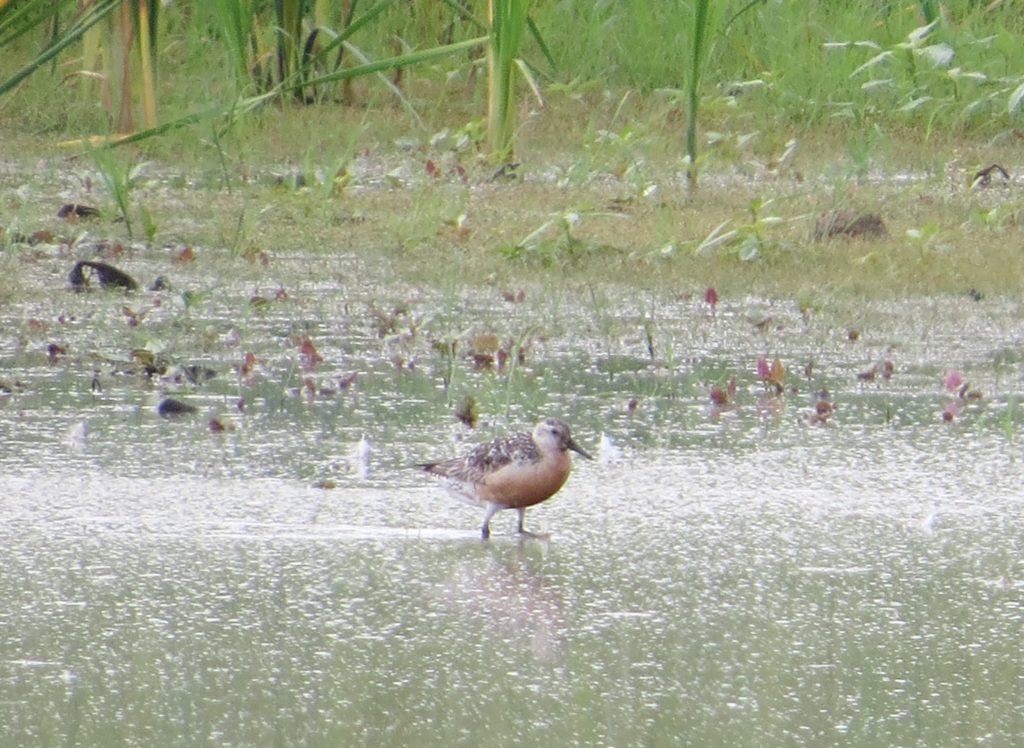 Initially I couldn’t find it and panicked since Joel Schmidt had just been there before me and assured me it was still there. It took me a good ten minutes to finally spot it, and I may or may not have been crabby and short with the kids during those tense first few minutes as they loudly pestered one another in the backseat to fight off the boredom. But with the chubby red bird now officially in sight, I was much more at ease and took things in stride.
Initially I couldn’t find it and panicked since Joel Schmidt had just been there before me and assured me it was still there. It took me a good ten minutes to finally spot it, and I may or may not have been crabby and short with the kids during those tense first few minutes as they loudly pestered one another in the backseat to fight off the boredom. But with the chubby red bird now officially in sight, I was much more at ease and took things in stride.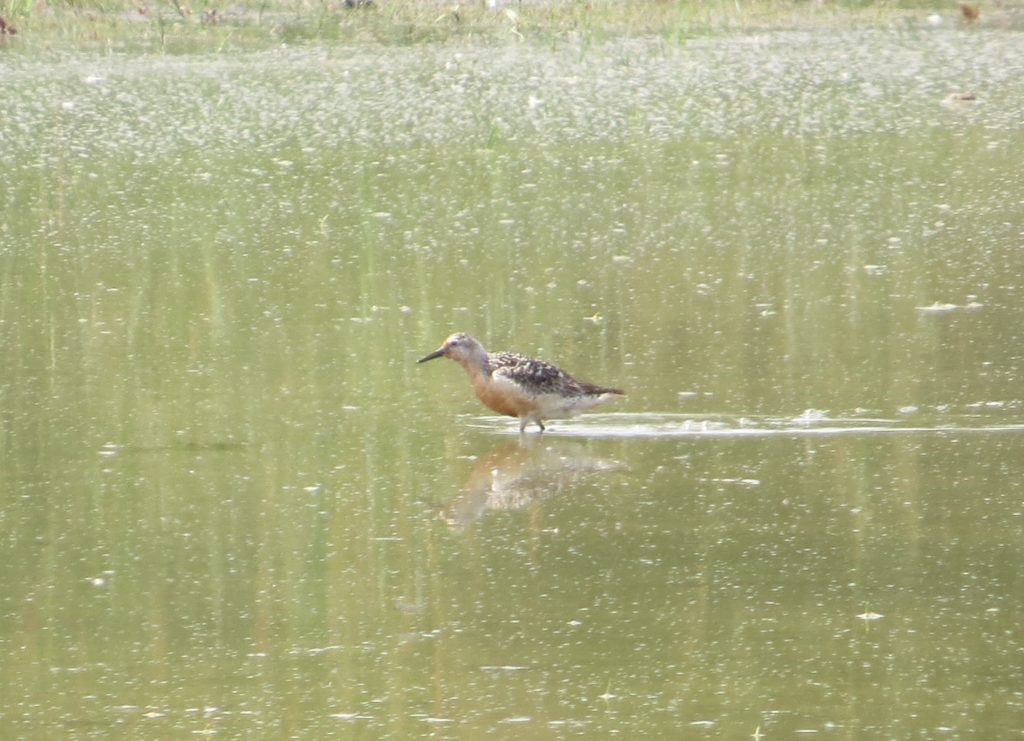
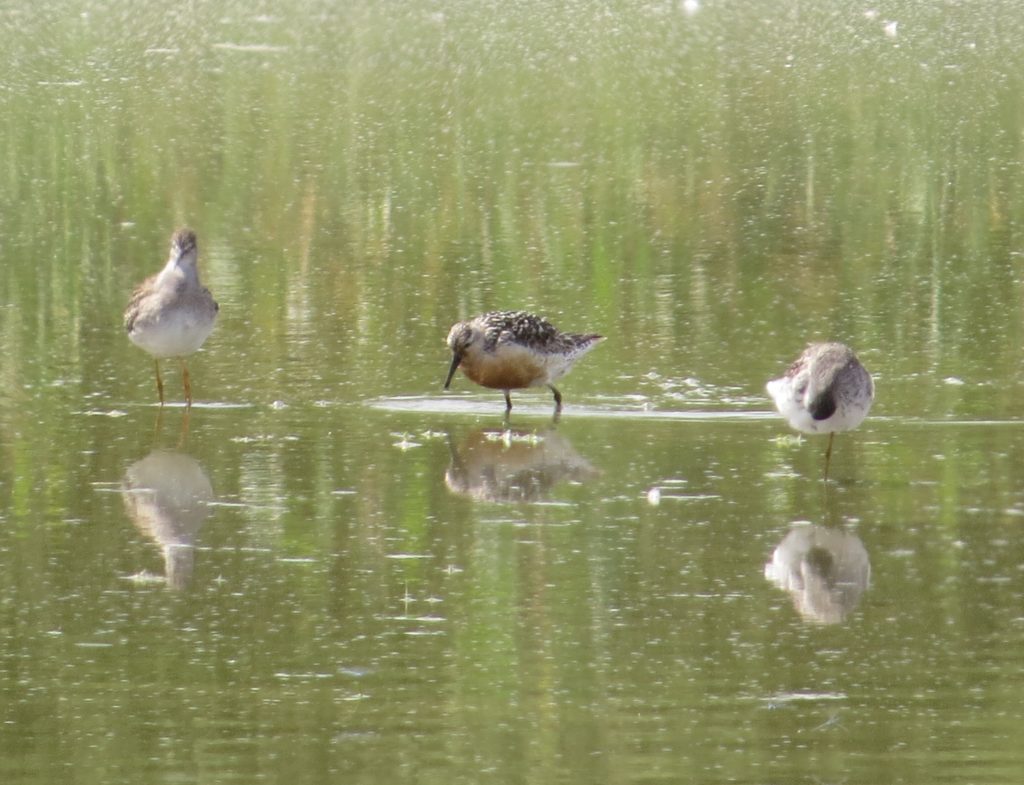
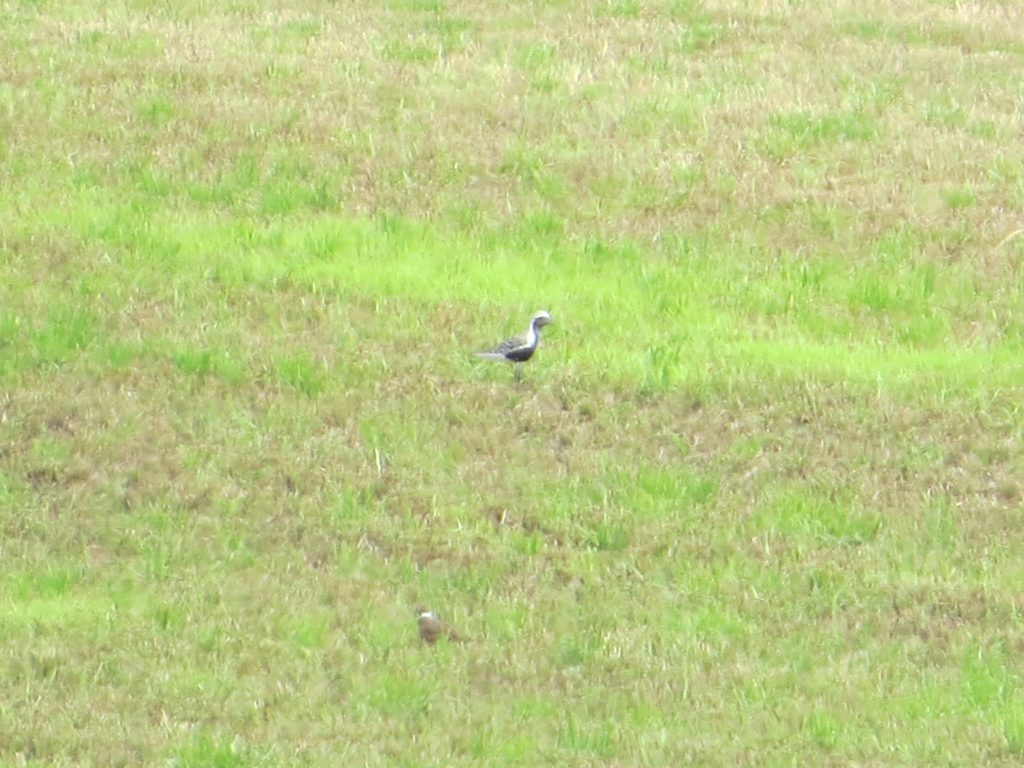 Eventually Joel and I found the Buff-breasteds and eventually I did get those kids home. After all, we had a lot of things to do at home, like get ready for out-of-state birding trip to grab some lifers and do some other fun things. That story is coming next.
Eventually Joel and I found the Buff-breasteds and eventually I did get those kids home. After all, we had a lot of things to do at home, like get ready for out-of-state birding trip to grab some lifers and do some other fun things. That story is coming next.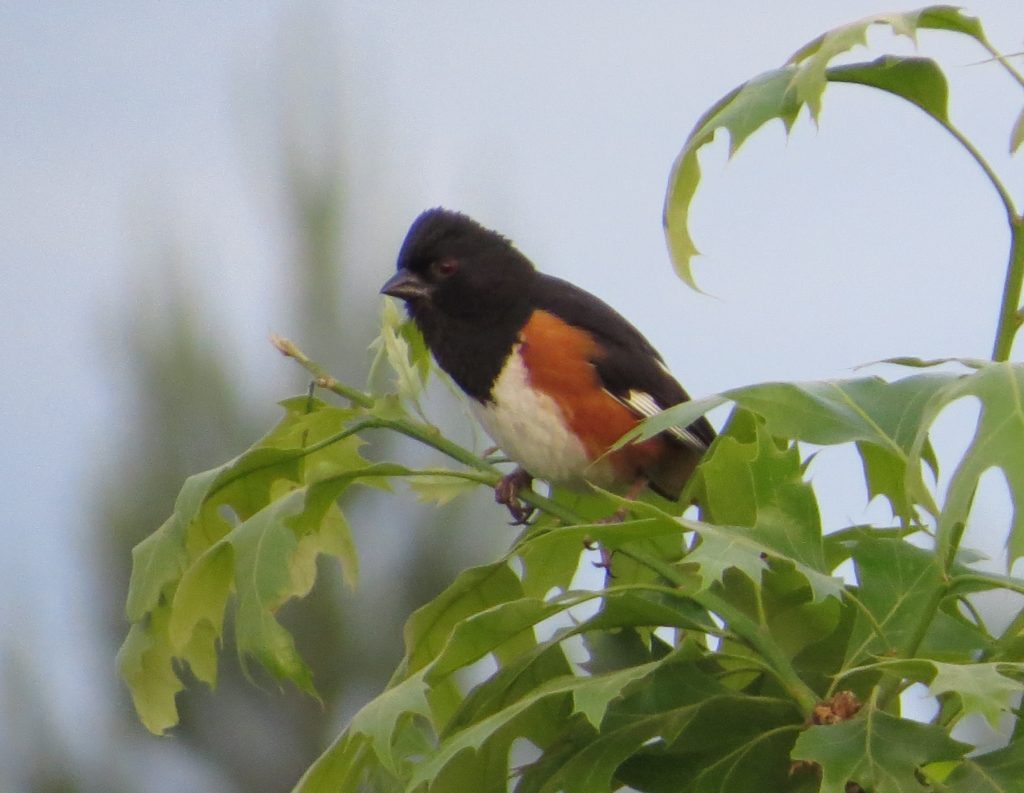
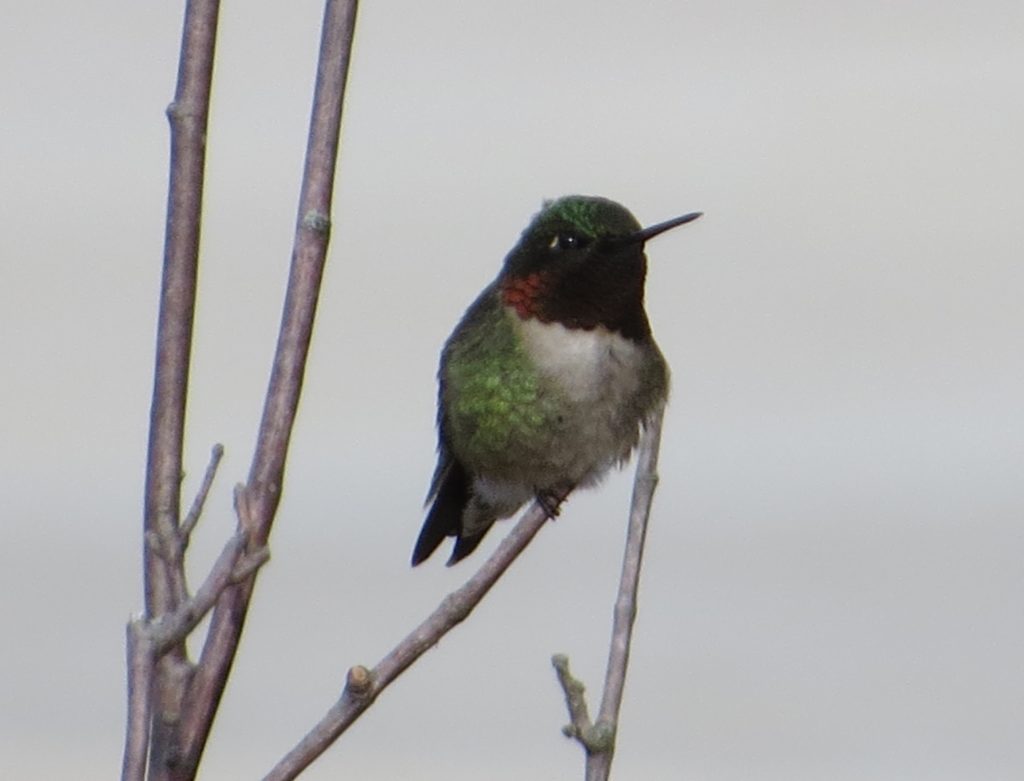
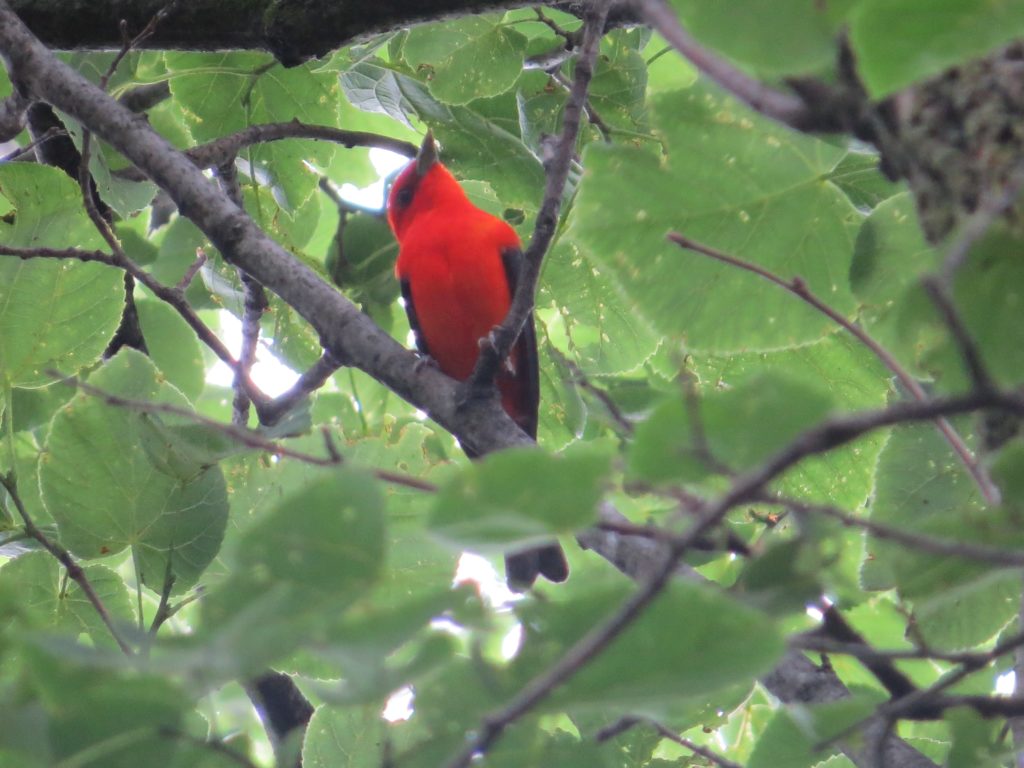 The other highlight was when Tommy picked out the sound of a calling Yellow-billed Cuckoo, a county bird for me! Once again, Tommy gives back! So in three successive days, this bird went from life bird to state bird to county bird. But it still was a no show. Someday.
The other highlight was when Tommy picked out the sound of a calling Yellow-billed Cuckoo, a county bird for me! Once again, Tommy gives back! So in three successive days, this bird went from life bird to state bird to county bird. But it still was a no show. Someday.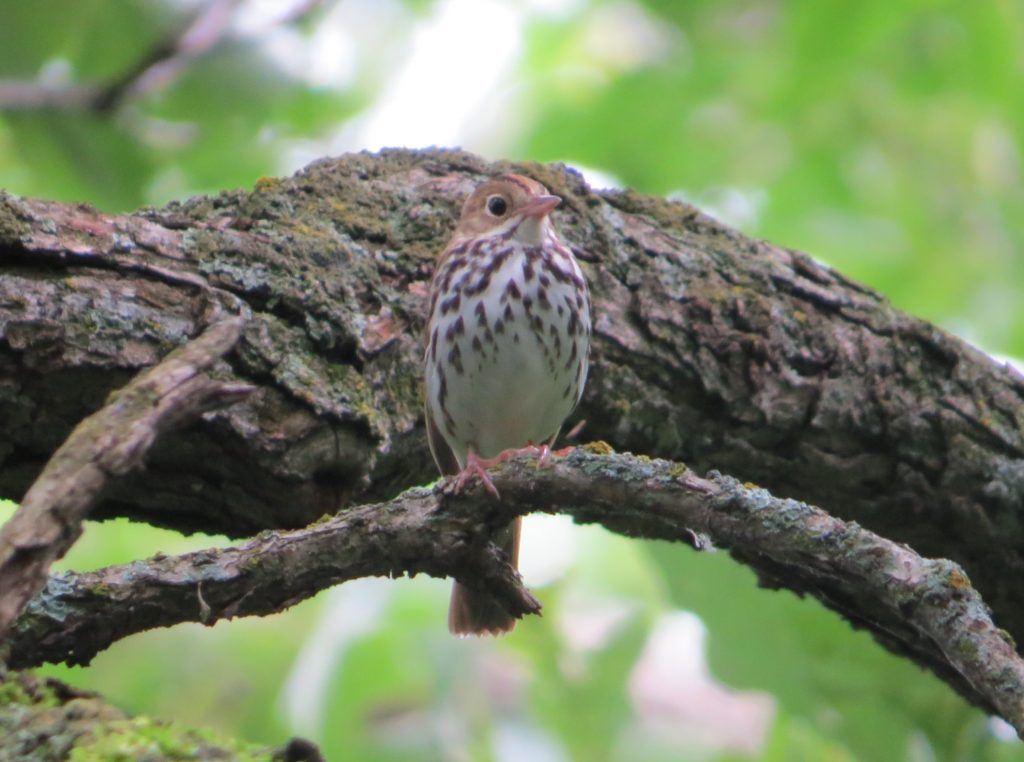
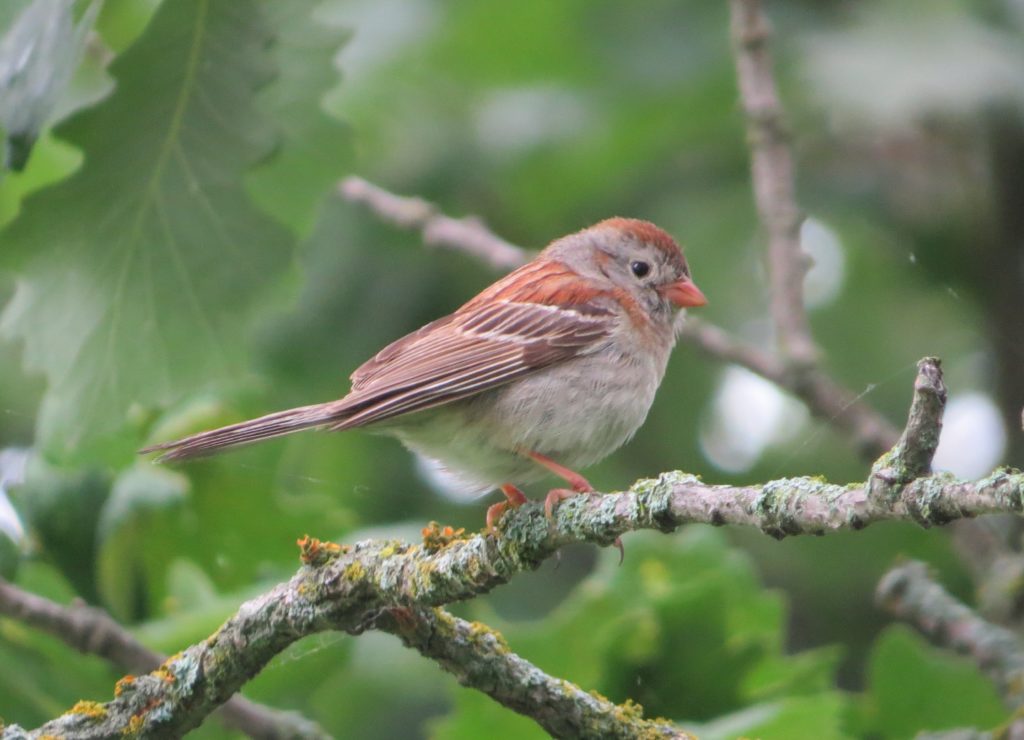
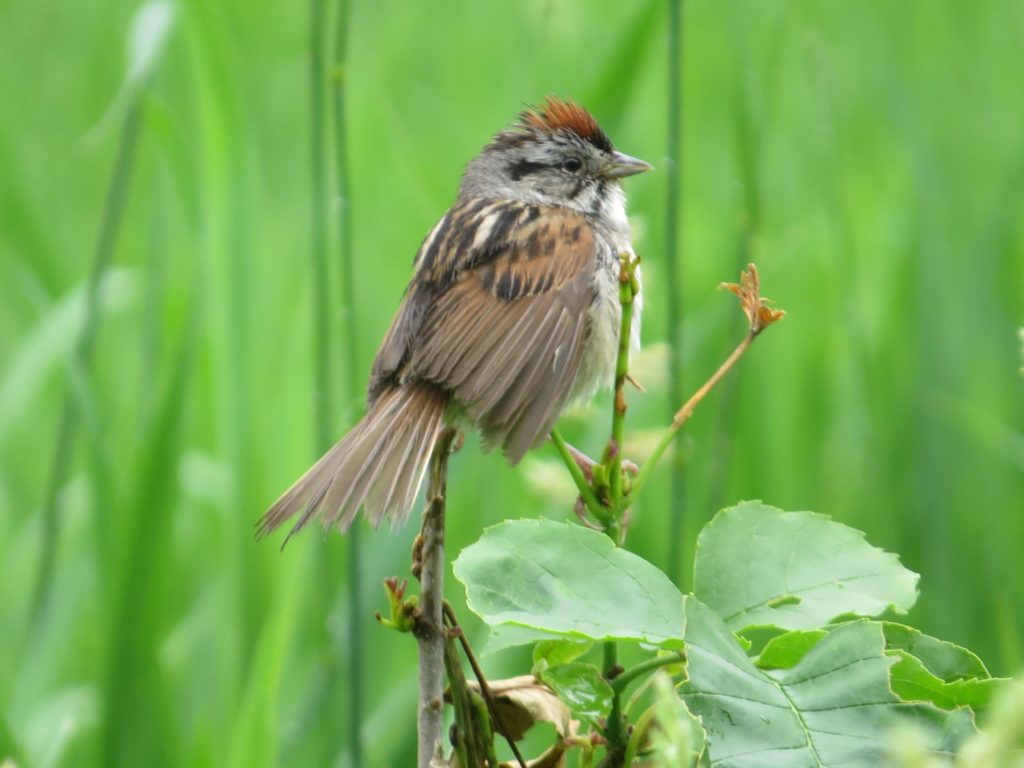
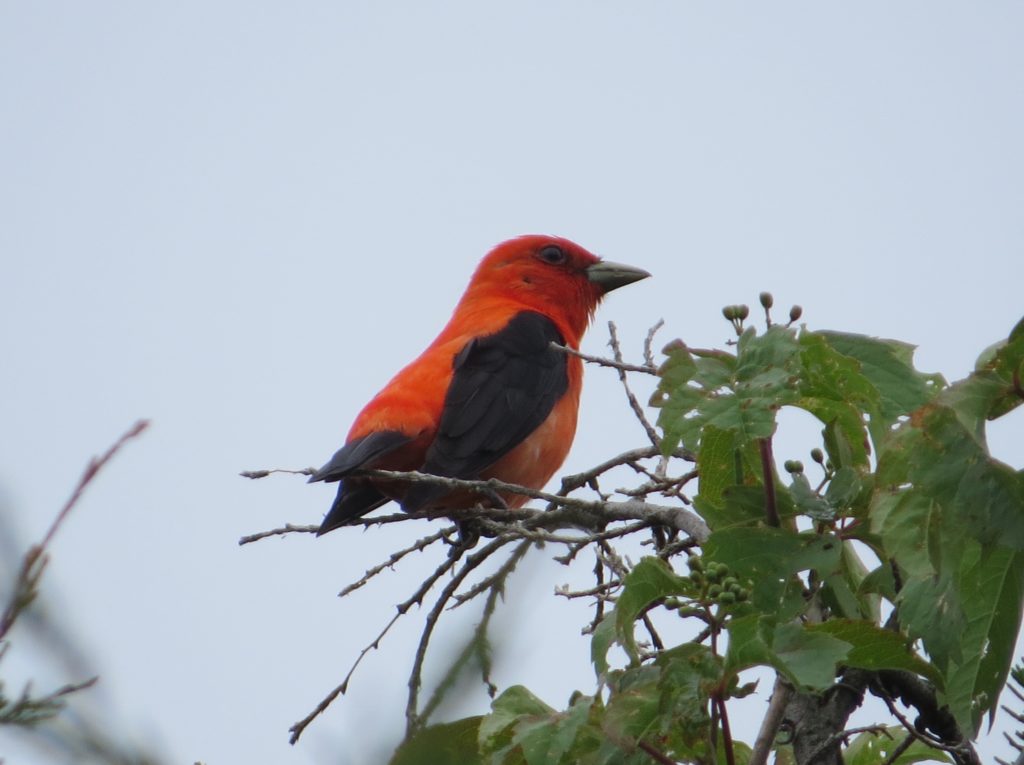 …and two Blue-winged Warblers, a very good bird for central Minnesota.
…and two Blue-winged Warblers, a very good bird for central Minnesota.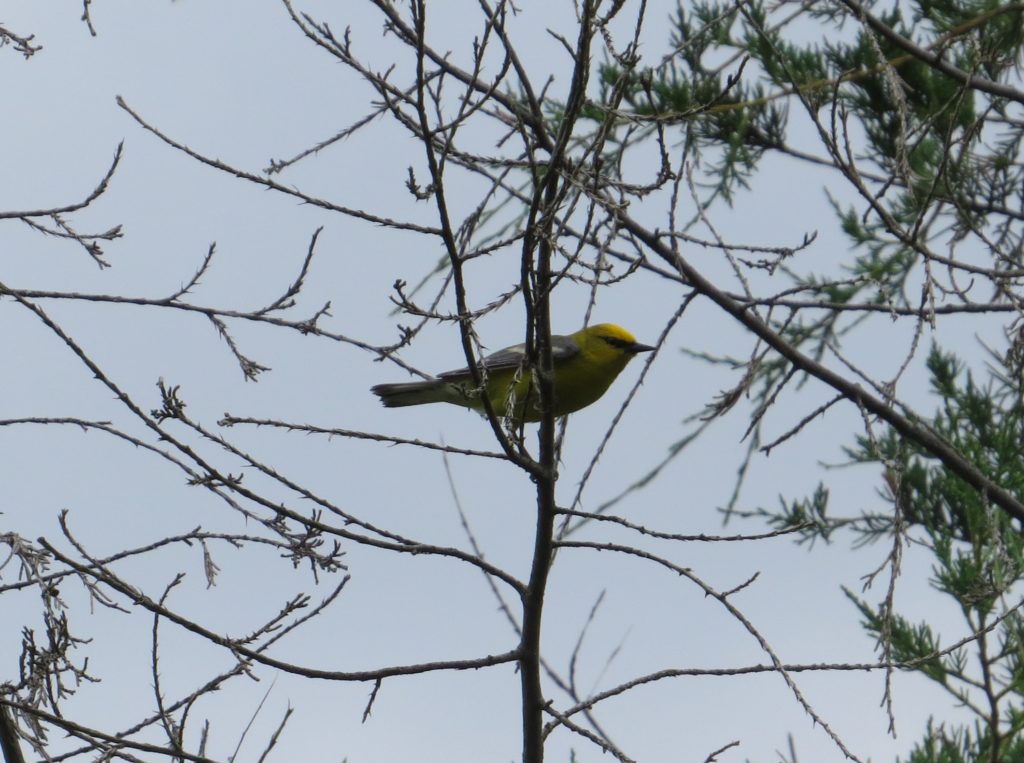
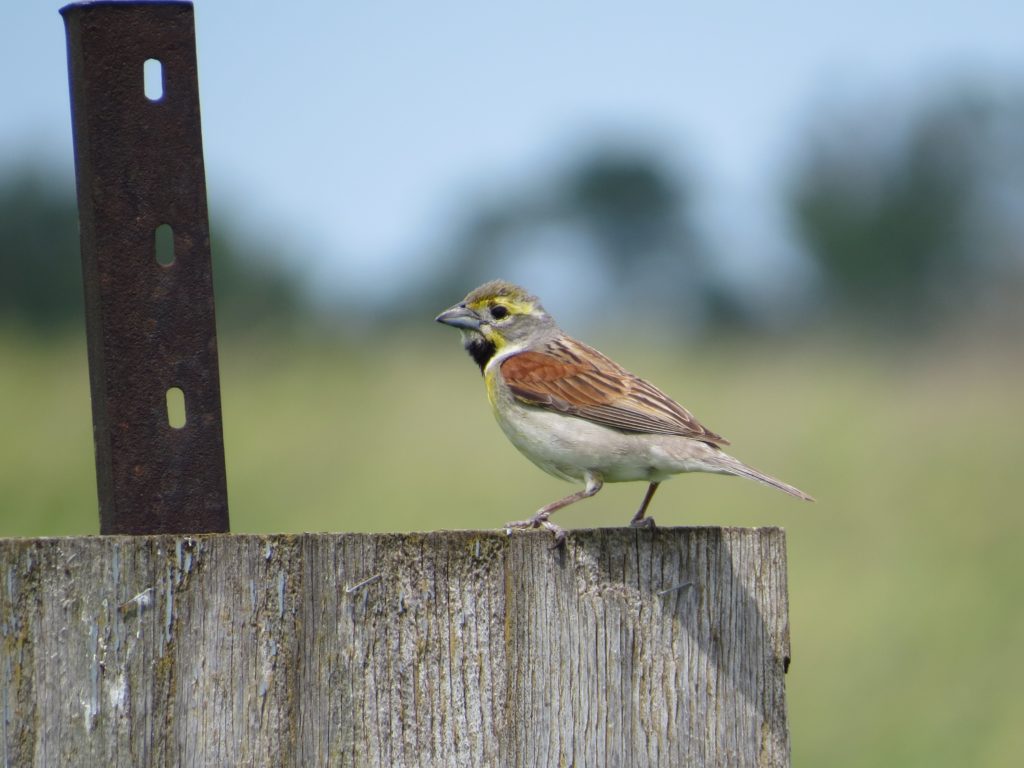 Another fun find I had one evening when I went out to a local wildlife management area was a completely unexpected county Least Bittern. Though I had a killer look at one flying toward me, I wasn’t able to get any photos but did record two Least Bitterns giving their “chuckling” call. You may have to turn up the volume.
Another fun find I had one evening when I went out to a local wildlife management area was a completely unexpected county Least Bittern. Though I had a killer look at one flying toward me, I wasn’t able to get any photos but did record two Least Bitterns giving their “chuckling” call. You may have to turn up the volume.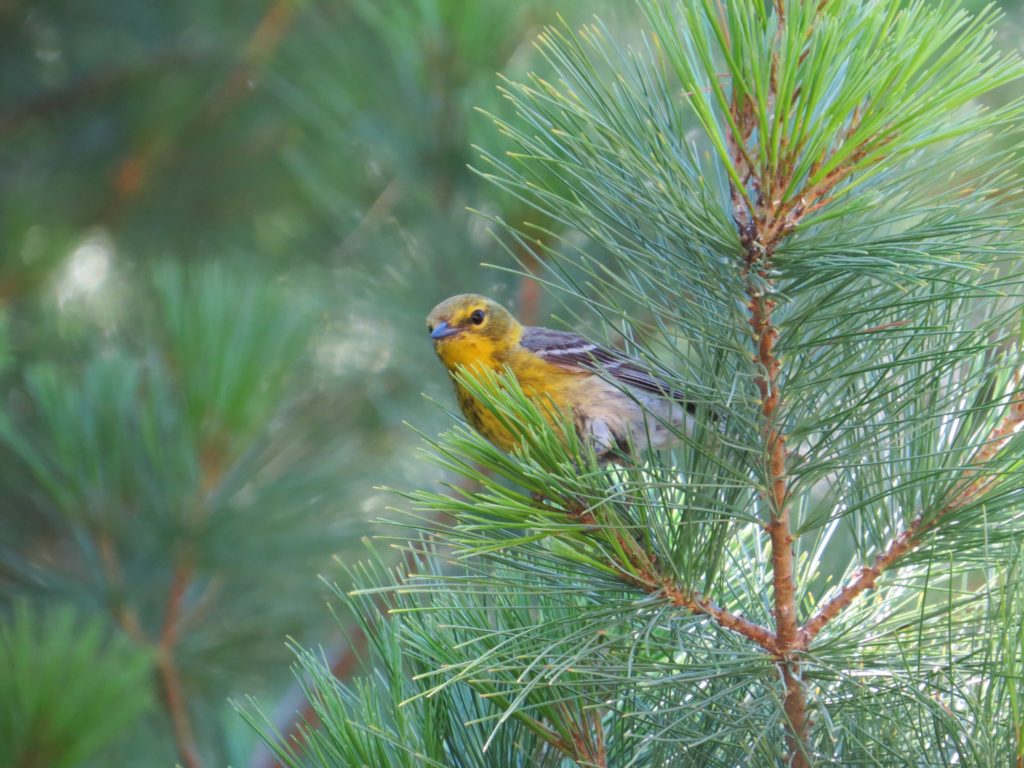
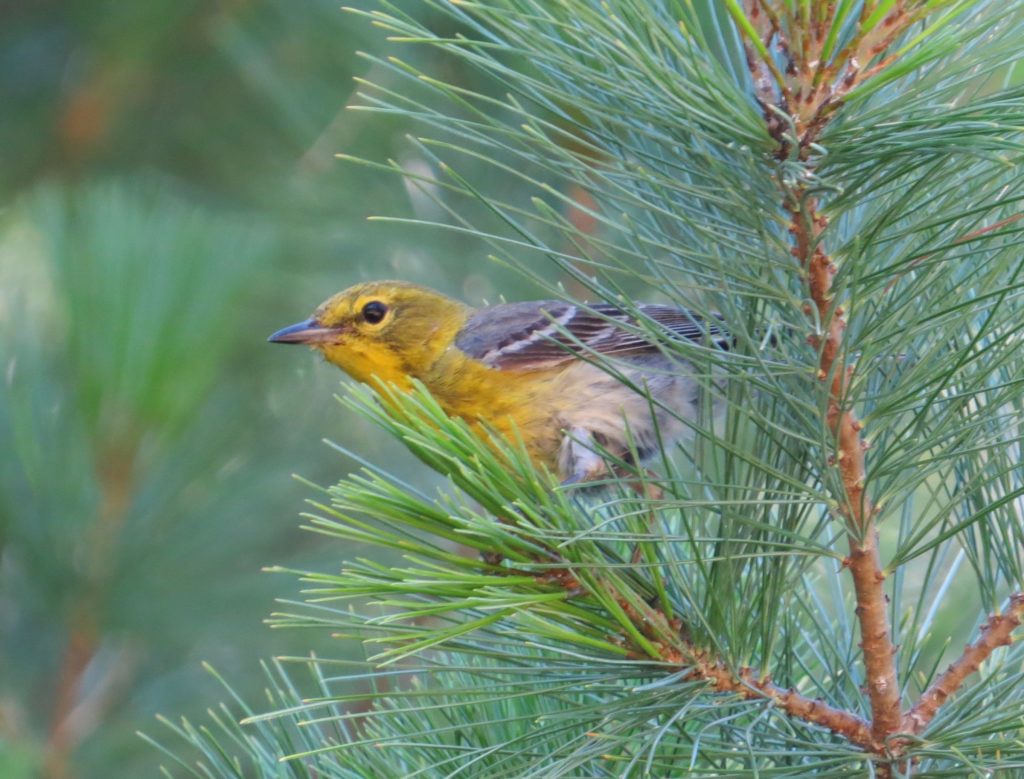
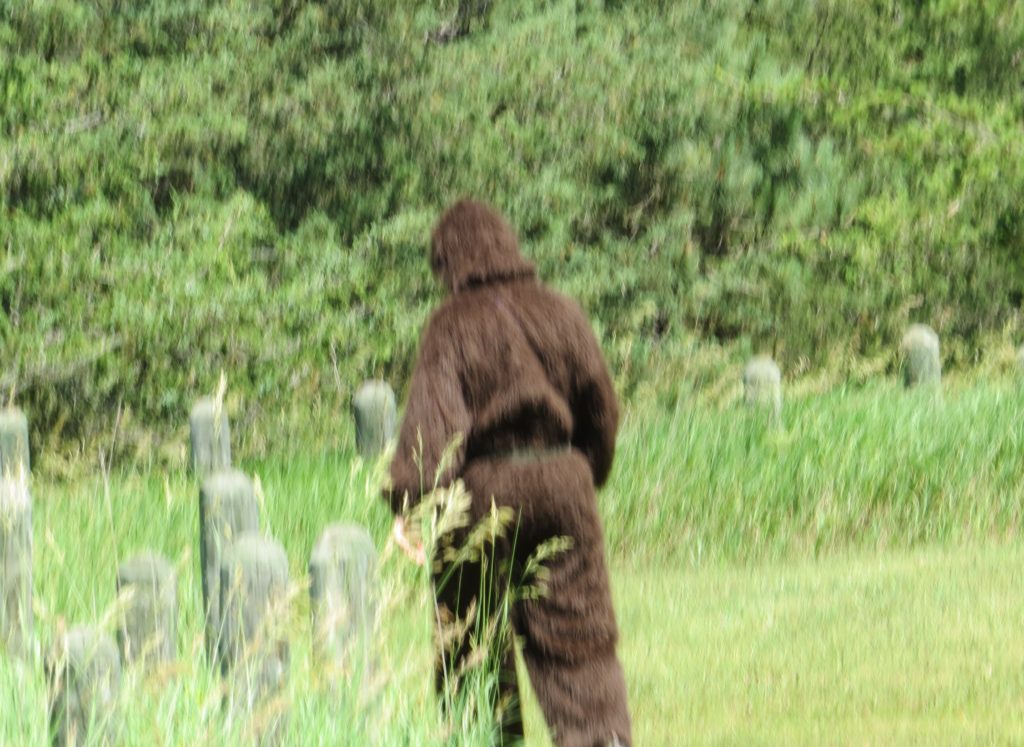
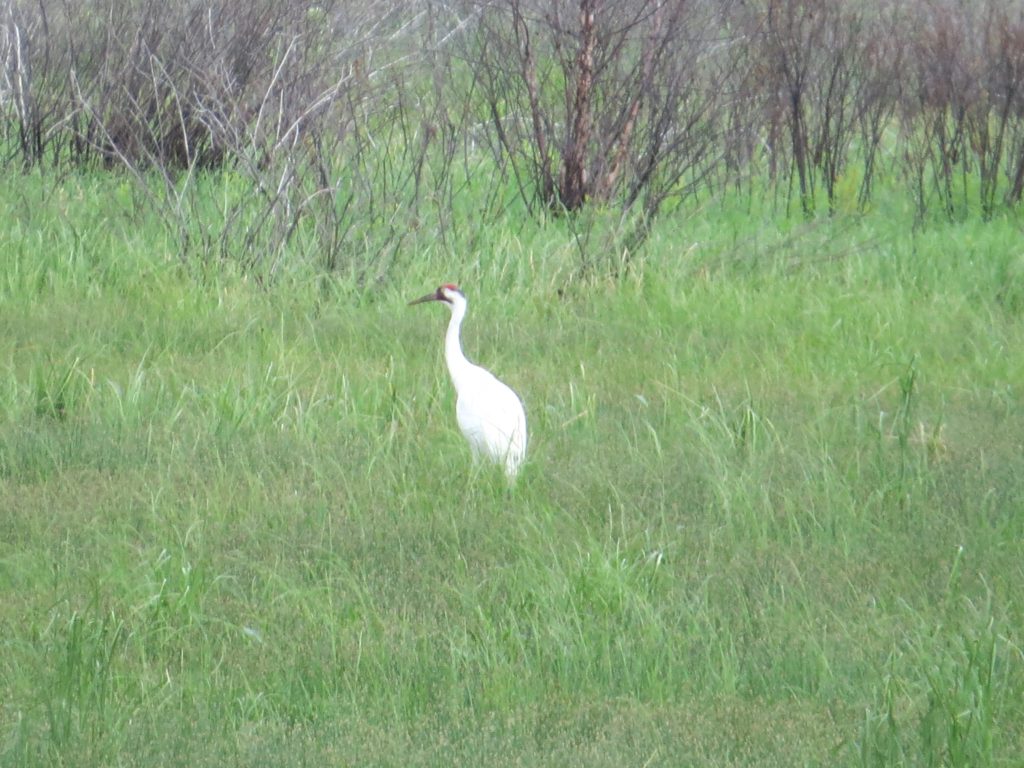 The three of us got out of the car to enjoy this easy lifer. Then I looked back toward the vehicle and spied a second bird in a waterway that had been hidden by some trees. This one was much closer to the road and gave us some great photo ops.
The three of us got out of the car to enjoy this easy lifer. Then I looked back toward the vehicle and spied a second bird in a waterway that had been hidden by some trees. This one was much closer to the road and gave us some great photo ops.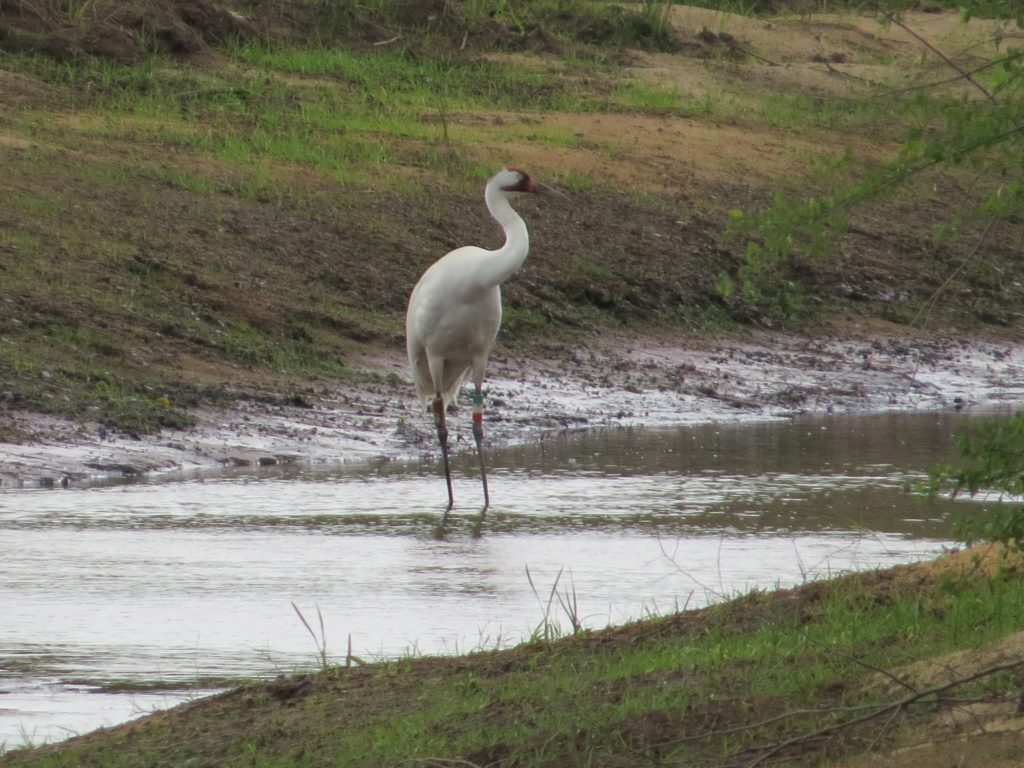
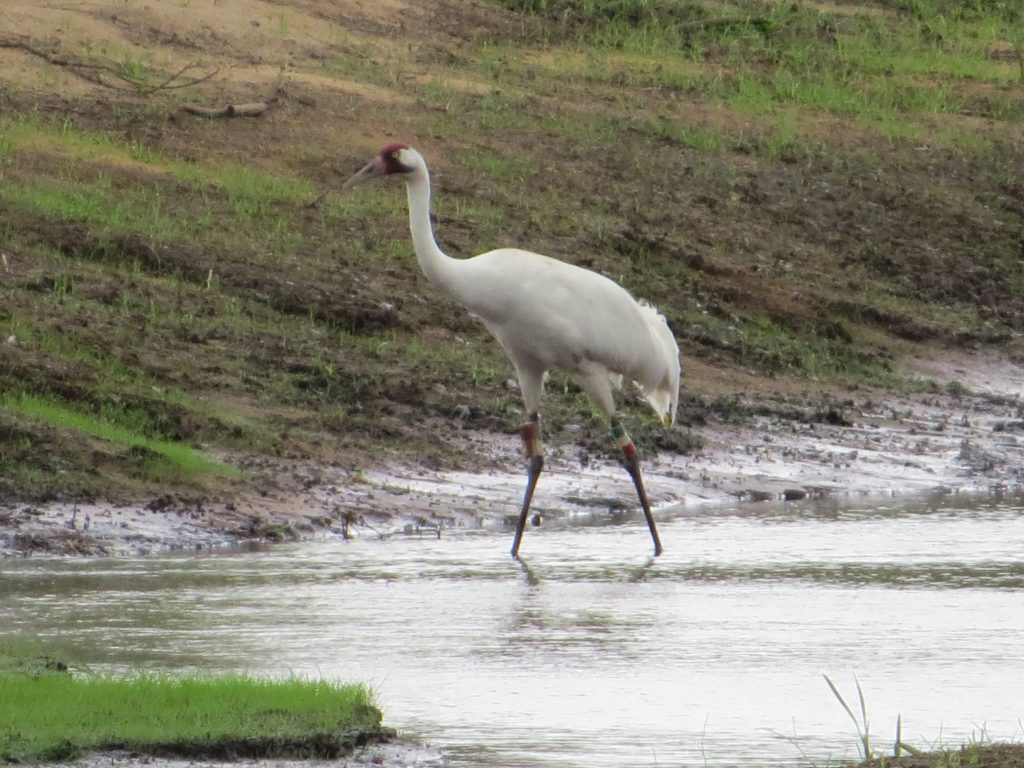
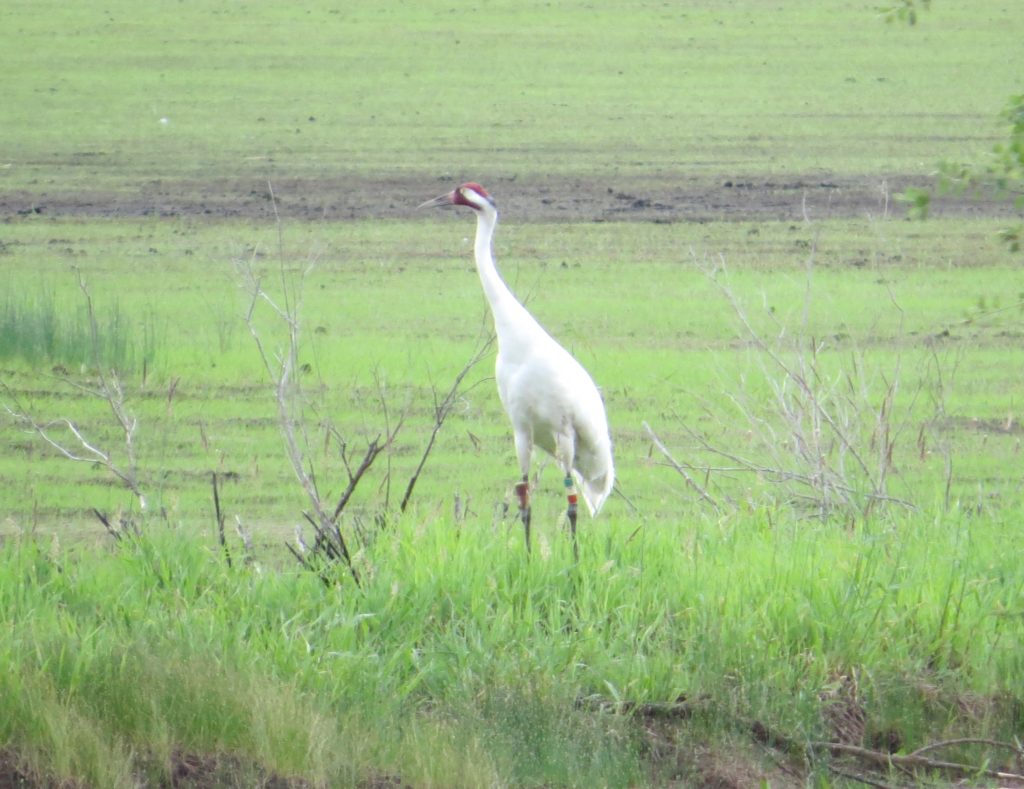 As we watched this Crane, something special happened. This one threw back its head and bugled for us! It was the loudest and coolest thing I’ve ever heard come out of a bird. It sounded kind of like a Trumpeter Swan, only much more impressive. Speaking of impressive, this bird stands at 52″ tall before it does this. That’s roughly the same height as Evan.
As we watched this Crane, something special happened. This one threw back its head and bugled for us! It was the loudest and coolest thing I’ve ever heard come out of a bird. It sounded kind of like a Trumpeter Swan, only much more impressive. Speaking of impressive, this bird stands at 52″ tall before it does this. That’s roughly the same height as Evan.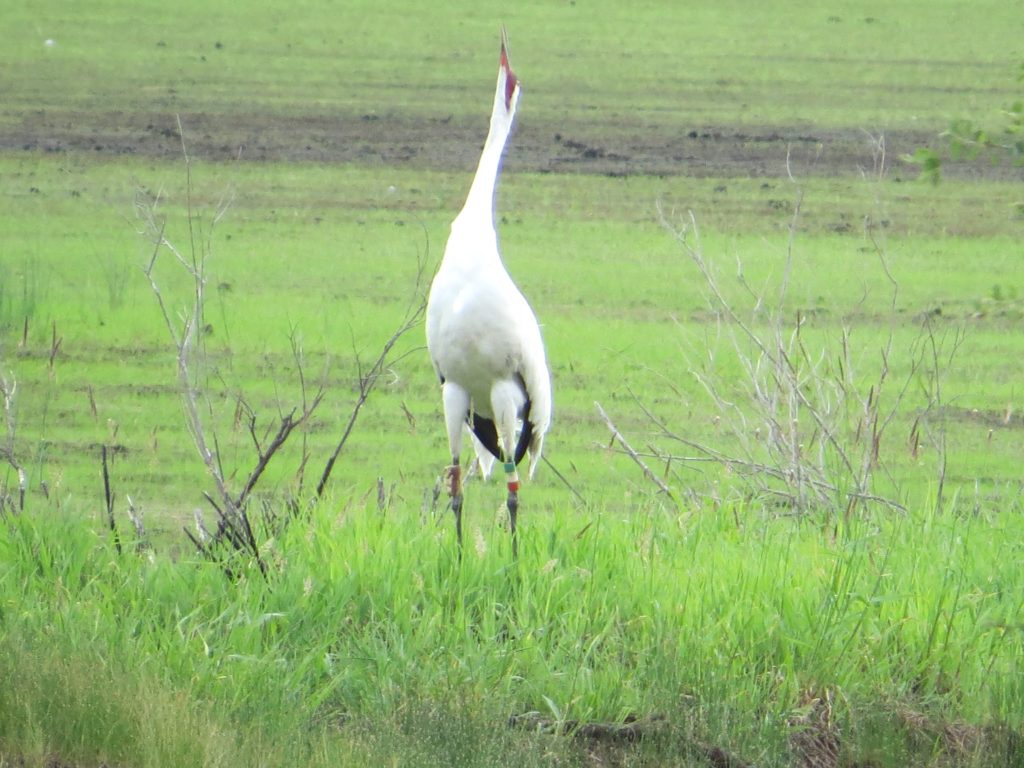
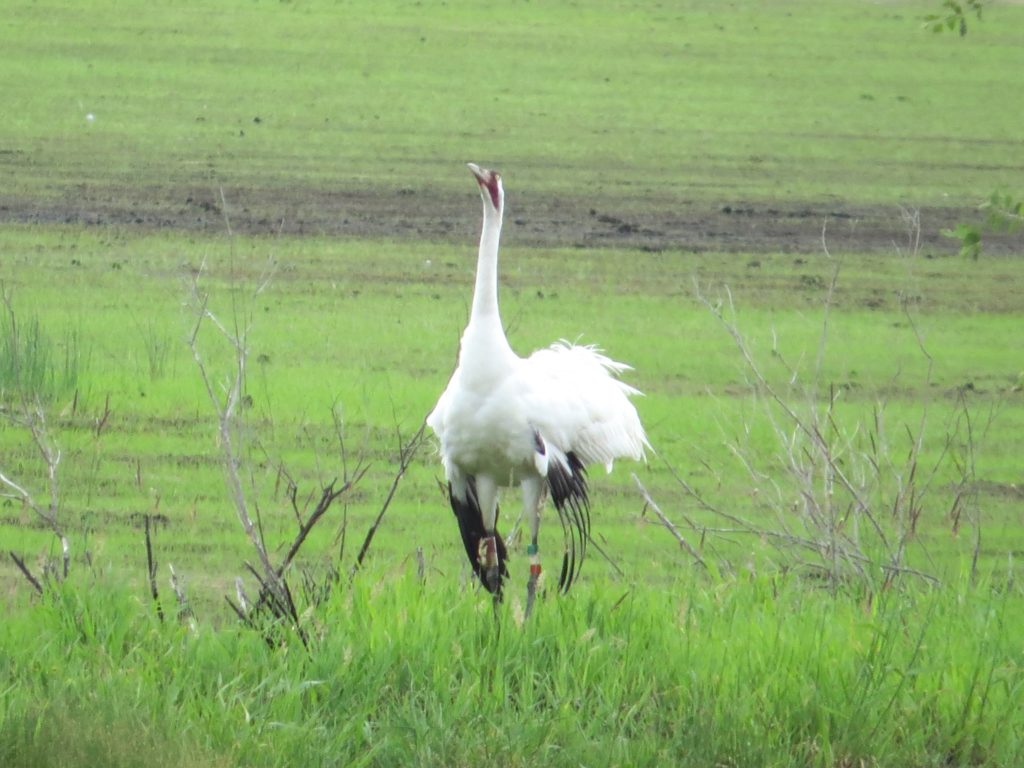 The three of us really enjoyed watching these birds.
The three of us really enjoyed watching these birds.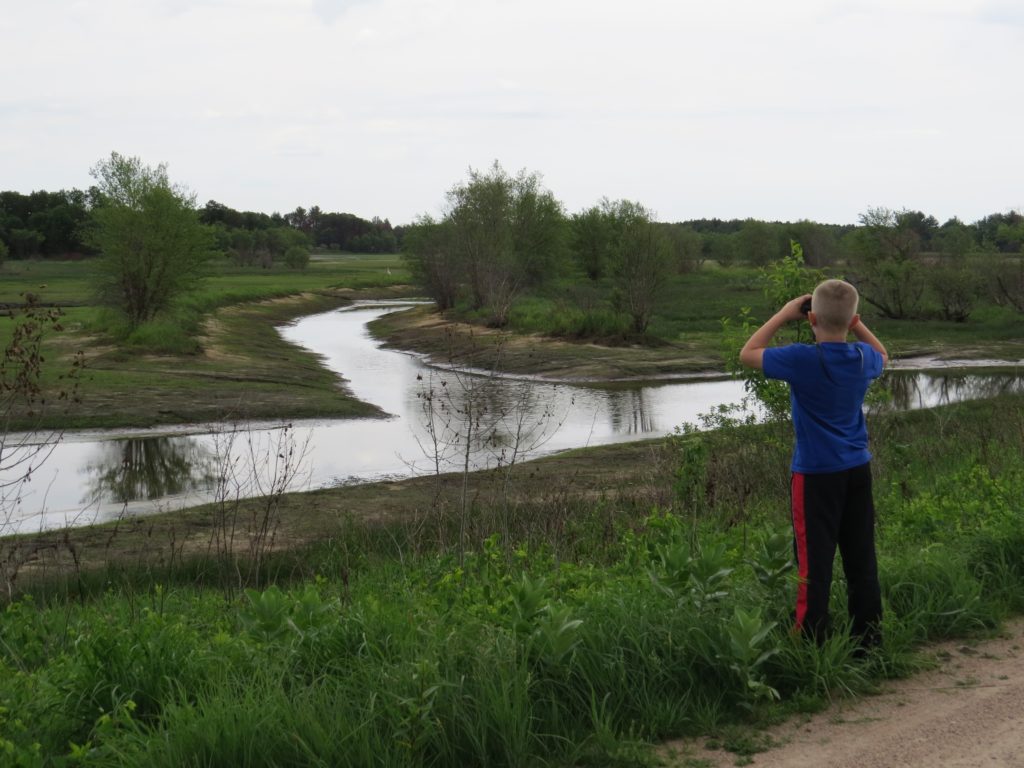 Here are Evan and Tommy each observing a different Crane. The one Tommy is looking at is visible in the photo. Evan is looking at the first one we found.
Here are Evan and Tommy each observing a different Crane. The one Tommy is looking at is visible in the photo. Evan is looking at the first one we found.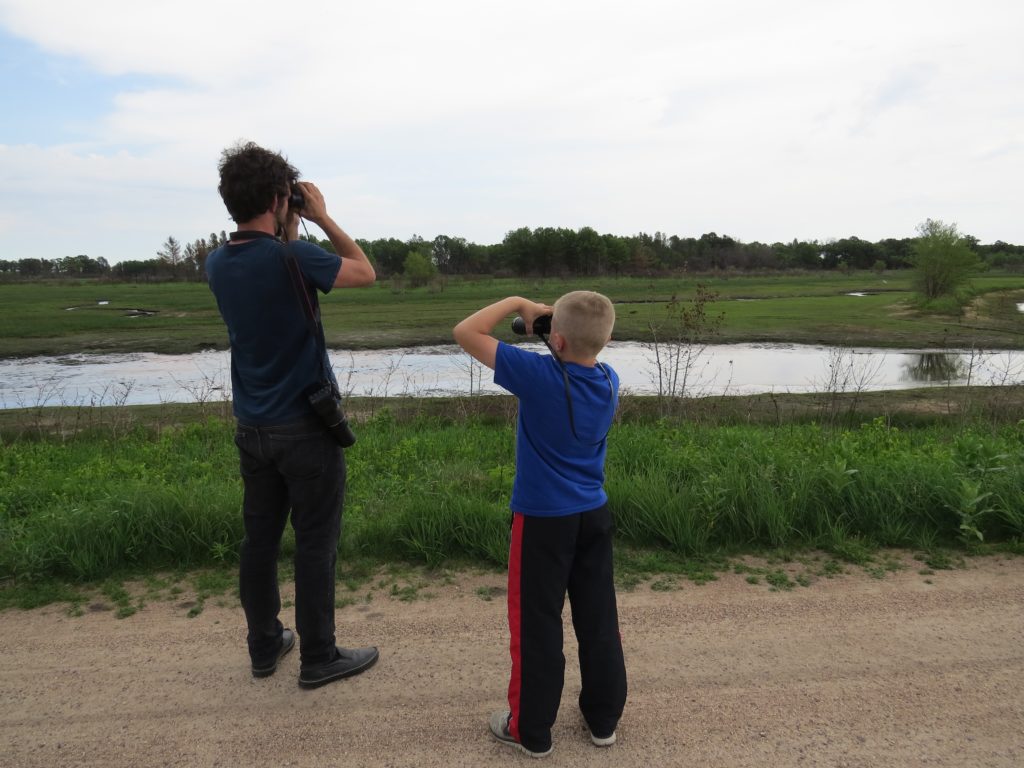
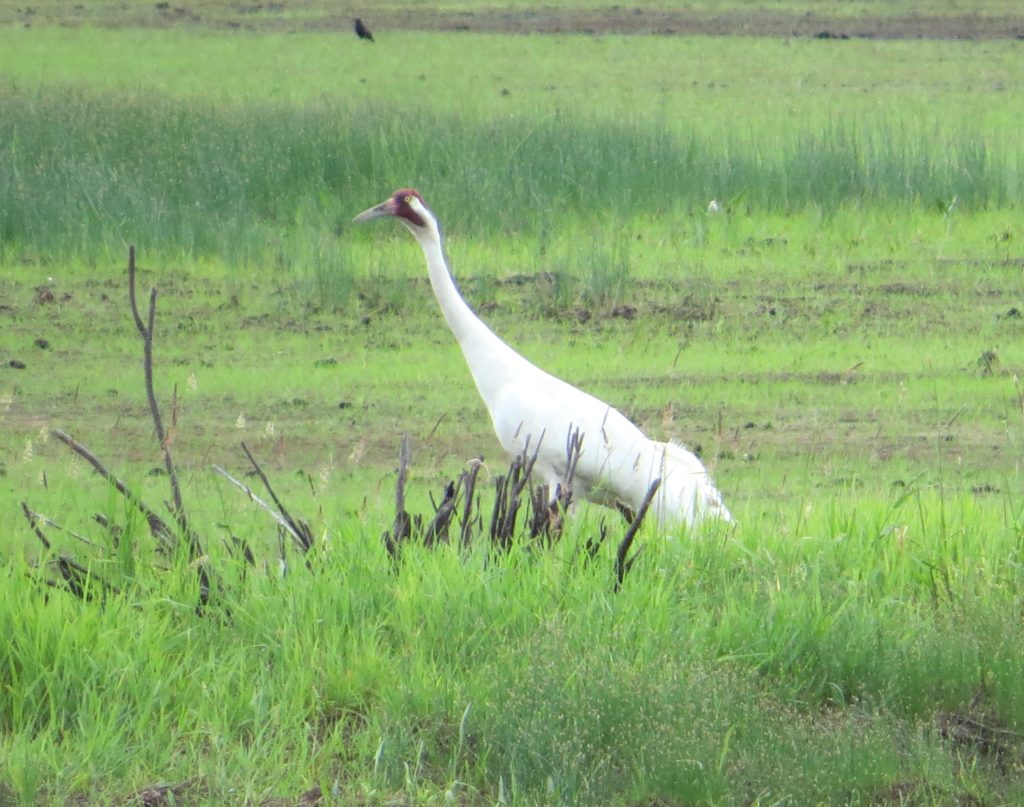 The Whooping Crane is one massive bird:
The Whooping Crane is one massive bird: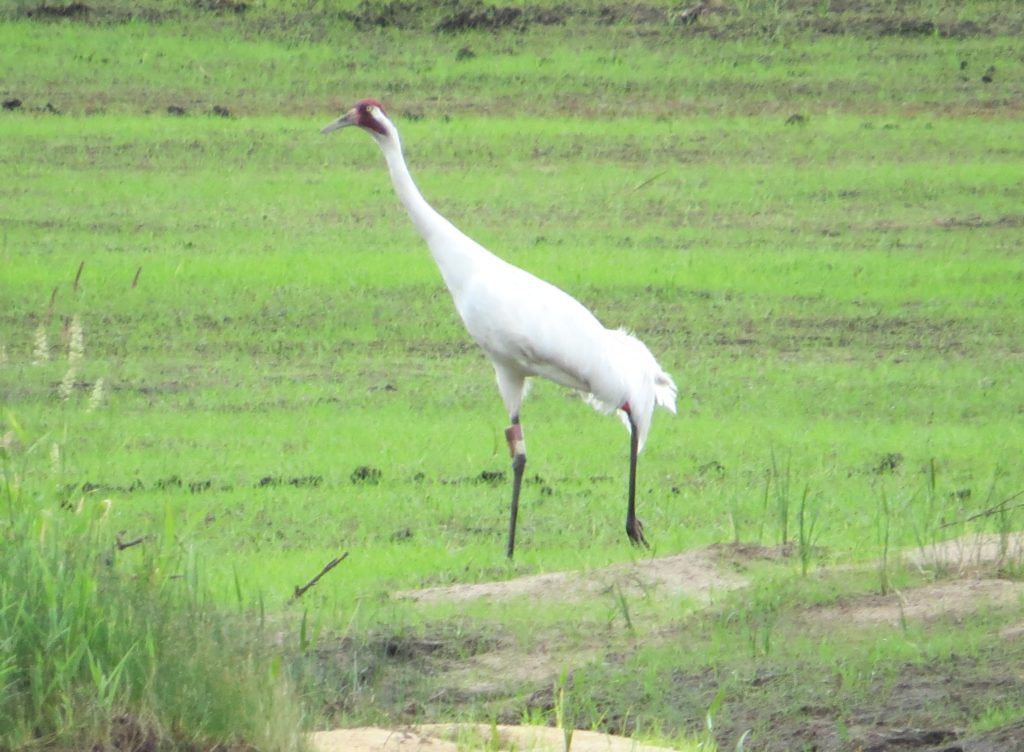 This cooperative bird eventually flew off and joined the much more distant Whooper. So the three of us decided to keep exploring Necedah. Necedah ended up being a phenomenal birding spot, so much so that I will save the rest for a different post and just focus on the Cranes from there in this post. I’ll just say that Necedah plays host to some other beautiful birds, who are also struggling in numbers.
This cooperative bird eventually flew off and joined the much more distant Whooper. So the three of us decided to keep exploring Necedah. Necedah ended up being a phenomenal birding spot, so much so that I will save the rest for a different post and just focus on the Cranes from there in this post. I’ll just say that Necedah plays host to some other beautiful birds, who are also struggling in numbers.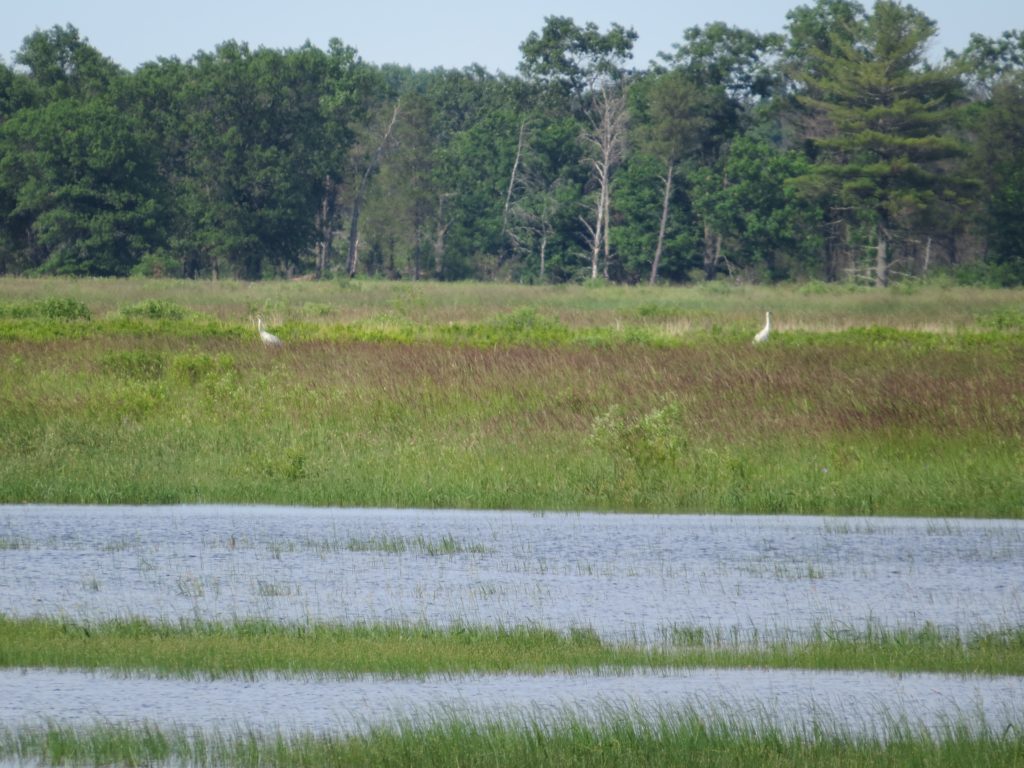 The Visitors Center also allowed us a humorous reprieve from the serious birding with some clowning around and a photo op.
The Visitors Center also allowed us a humorous reprieve from the serious birding with some clowning around and a photo op.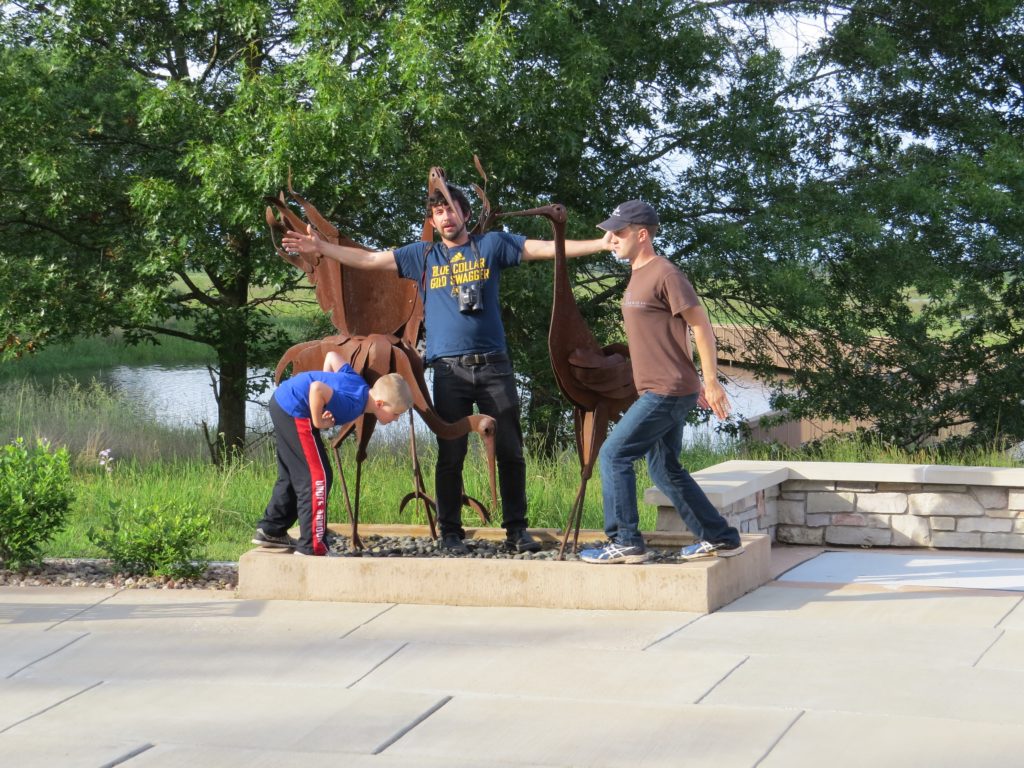 As I was monkeying with the settings for the self-timer on my camera, I ended up getting this gem on accident.
As I was monkeying with the settings for the self-timer on my camera, I ended up getting this gem on accident.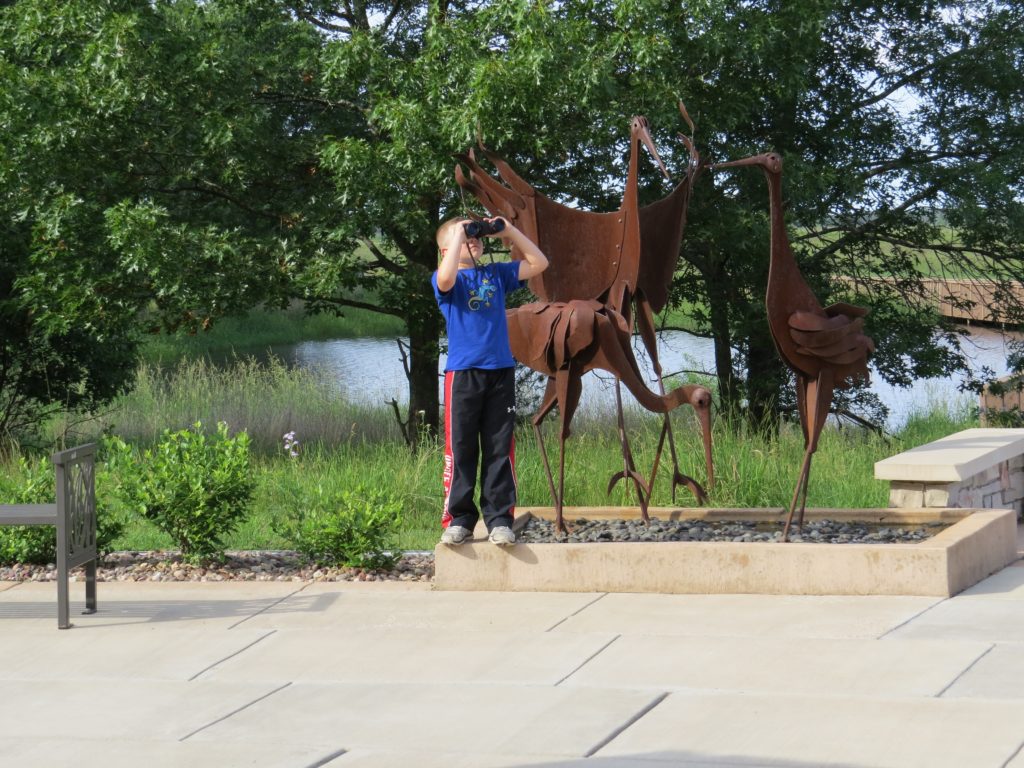
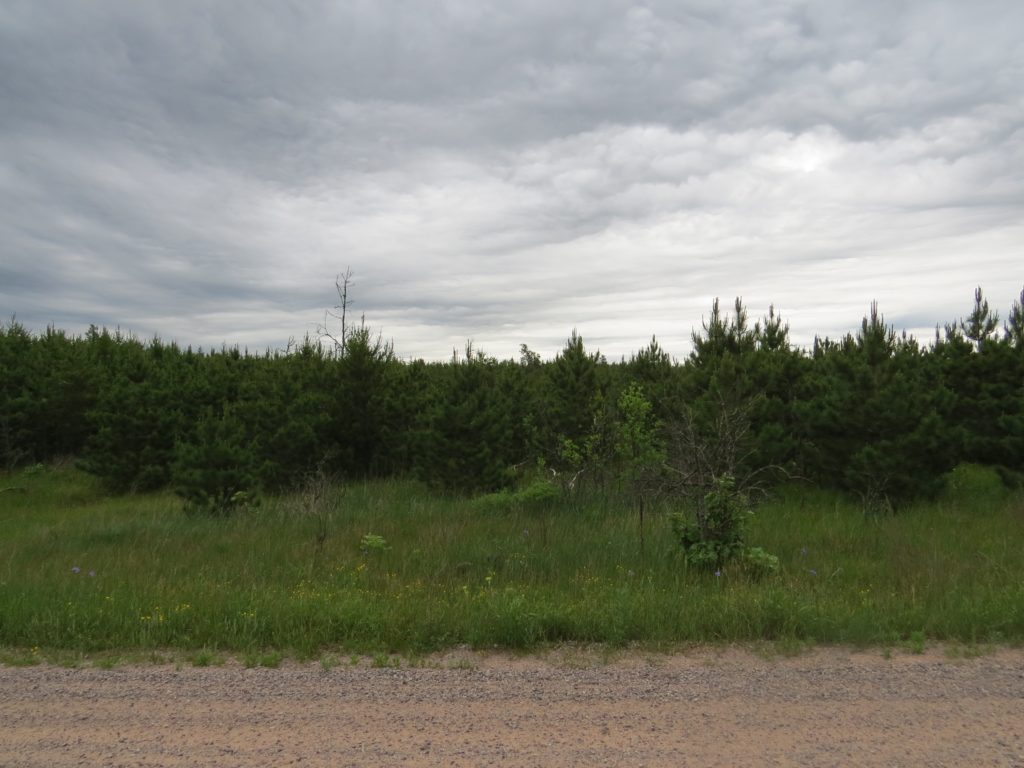
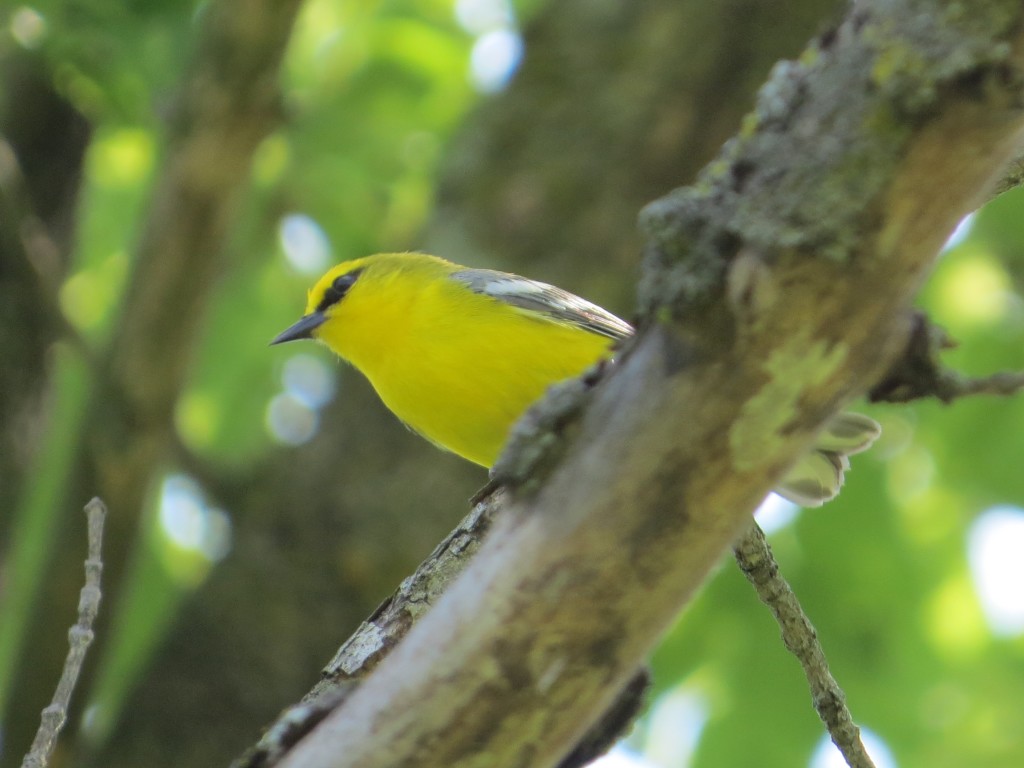 Once we hiked through the prairie habitat and into the woods, we walked along a trail on glacial ridge where the slopes quickly became quite steep on each side of the trail. Thanks to some great insights from Washington County birding guru, Pete Nichols, we cut down one of these slopes on a goat path of sorts to reach the creek in the ravine below. This was the promised land for BOTH the Louisiana Waterthrush and the Acadian Flycatcher. It did not take long for us to hear the sharp “Pit-se!” call of our shared Acadian lifer. Arriving at the creek bottom, Tommy instantly pointed out the chip note of the Louisiana Waterthrush, which had the honor of being my 400th life bird. The bird showed well for us but would not sit still. Its song was beautiful as it rang through the ravine.
Once we hiked through the prairie habitat and into the woods, we walked along a trail on glacial ridge where the slopes quickly became quite steep on each side of the trail. Thanks to some great insights from Washington County birding guru, Pete Nichols, we cut down one of these slopes on a goat path of sorts to reach the creek in the ravine below. This was the promised land for BOTH the Louisiana Waterthrush and the Acadian Flycatcher. It did not take long for us to hear the sharp “Pit-se!” call of our shared Acadian lifer. Arriving at the creek bottom, Tommy instantly pointed out the chip note of the Louisiana Waterthrush, which had the honor of being my 400th life bird. The bird showed well for us but would not sit still. Its song was beautiful as it rang through the ravine.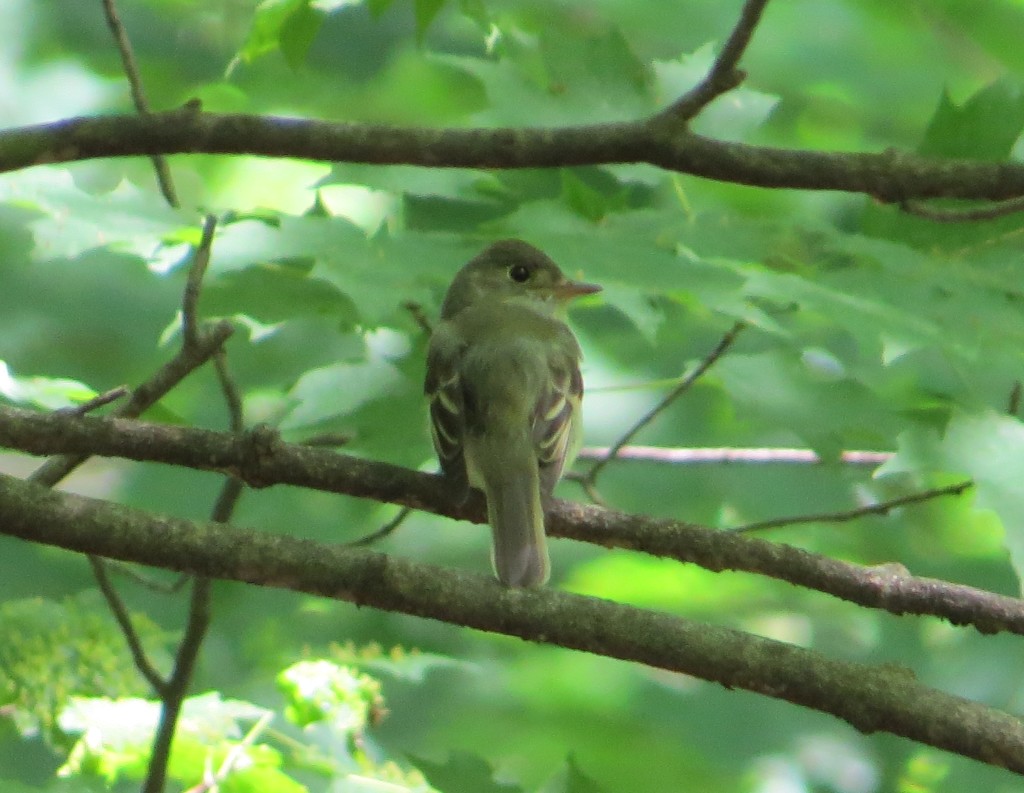 Confession: I’m starting to really like the Empids, at least the eastern ones. Though the five are difficult to differentiate visually, their unique habitat choices and equally unique songs make identification a lot easier than I once thought. Hearing this Acadian Flycatcher was much more fun than just seeing it.
Confession: I’m starting to really like the Empids, at least the eastern ones. Though the five are difficult to differentiate visually, their unique habitat choices and equally unique songs make identification a lot easier than I once thought. Hearing this Acadian Flycatcher was much more fun than just seeing it.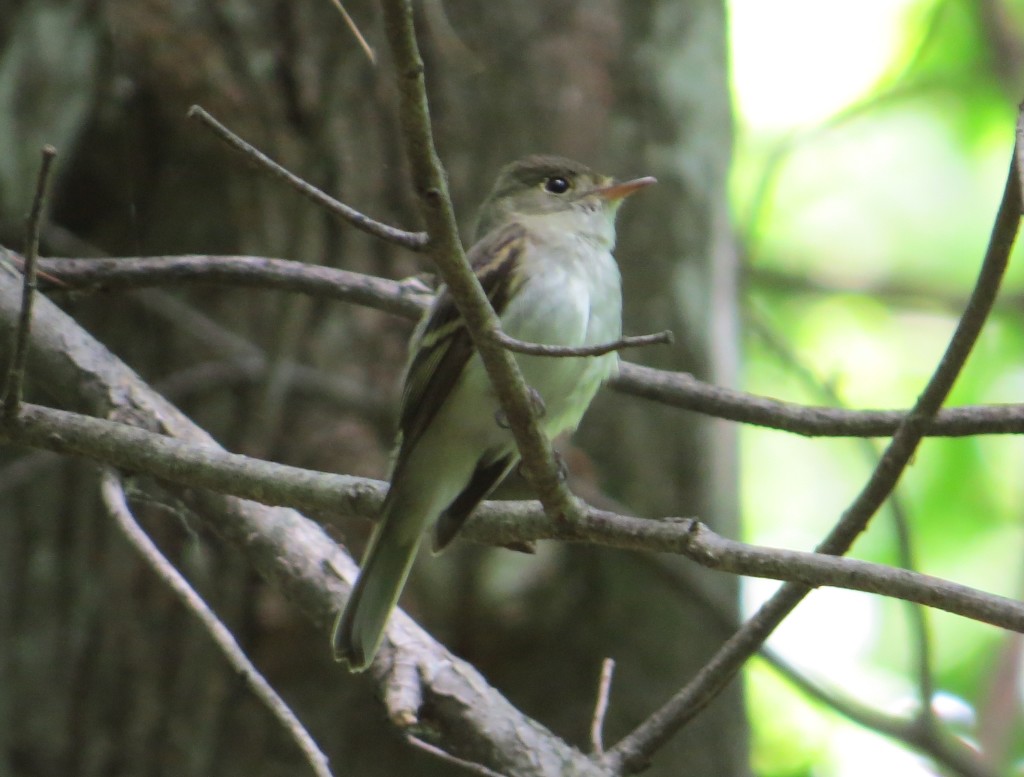 An equal auditory delight was the Louisiana Waterthrush. It was loud. We had at least two different birds. This one below put on an impressive spinning and tail-bobbing display on this log right in front of us.
An equal auditory delight was the Louisiana Waterthrush. It was loud. We had at least two different birds. This one below put on an impressive spinning and tail-bobbing display on this log right in front of us.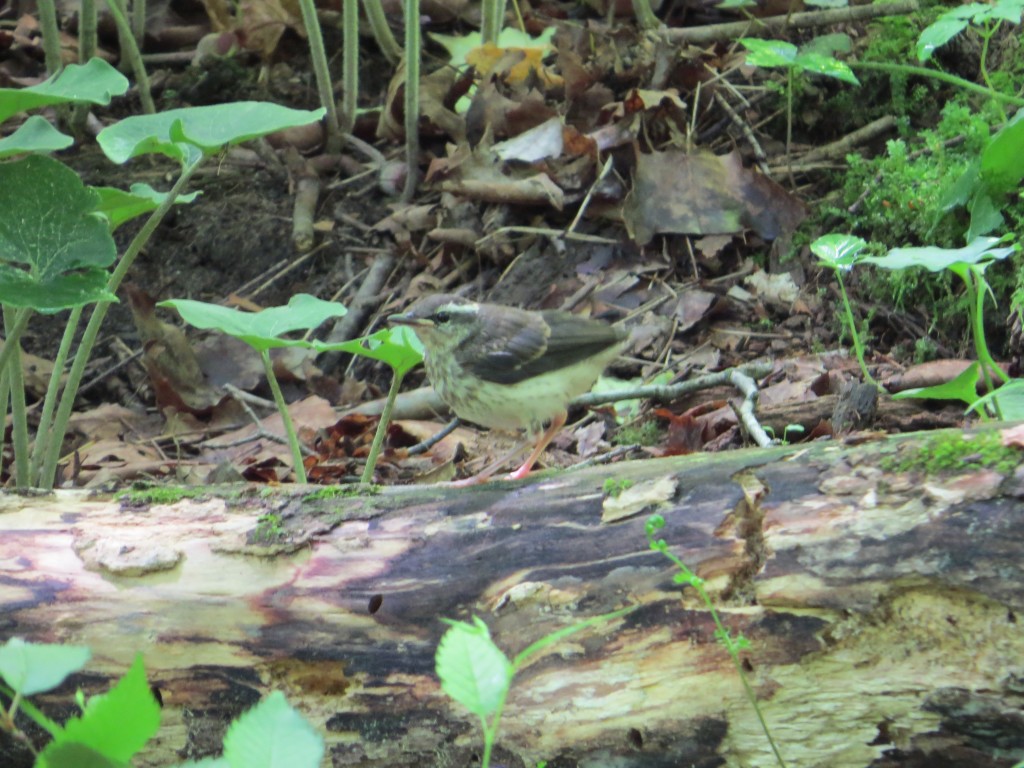
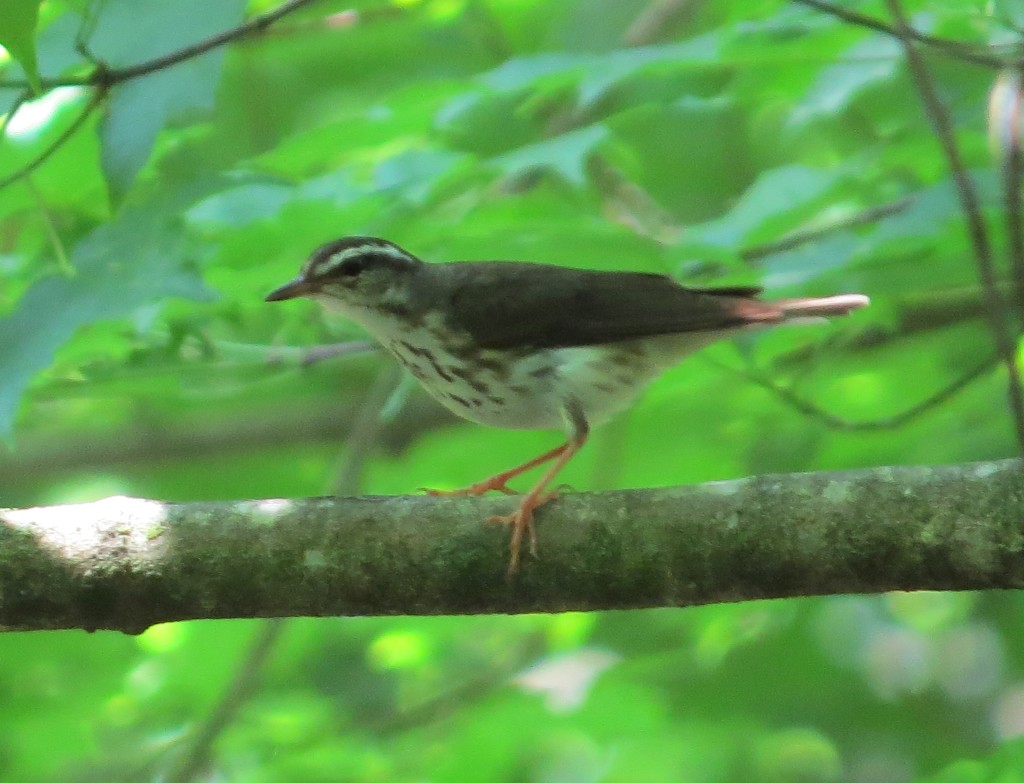 Tommy and I became absorbed in our separate pursuits spending more time than we anticipated in our searches. Is that a Scarlet Tanager? Nope, just a super content Evan who kept busy the entire time playing in the creek. Good thing he wore his water boots.
Tommy and I became absorbed in our separate pursuits spending more time than we anticipated in our searches. Is that a Scarlet Tanager? Nope, just a super content Evan who kept busy the entire time playing in the creek. Good thing he wore his water boots.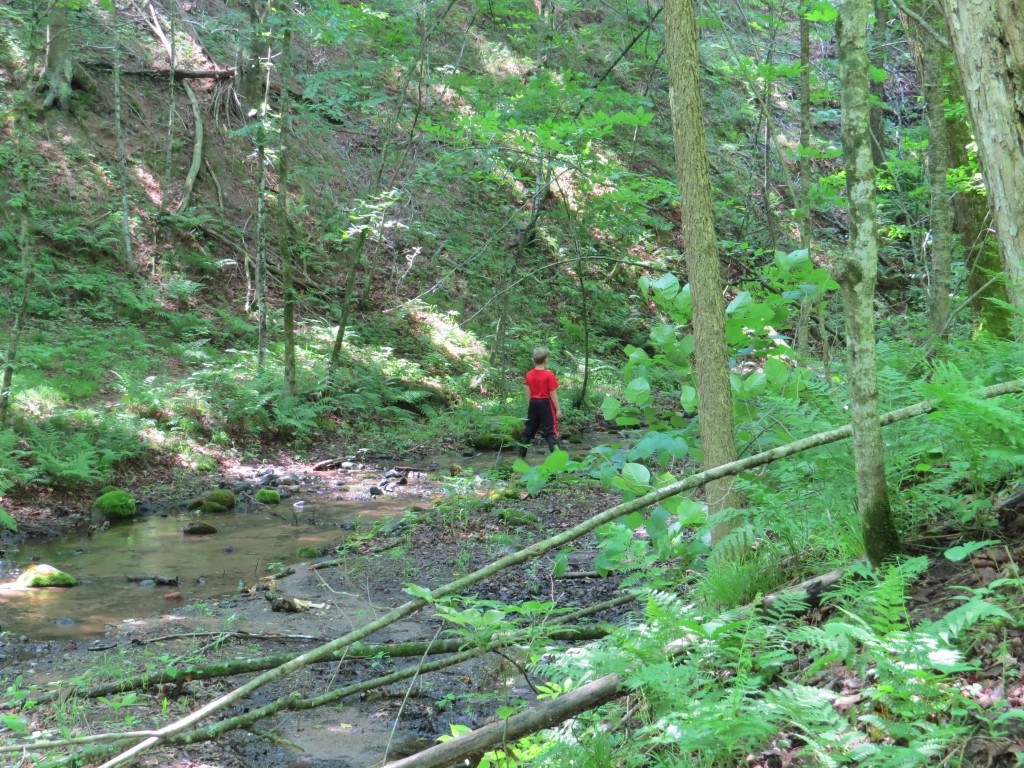
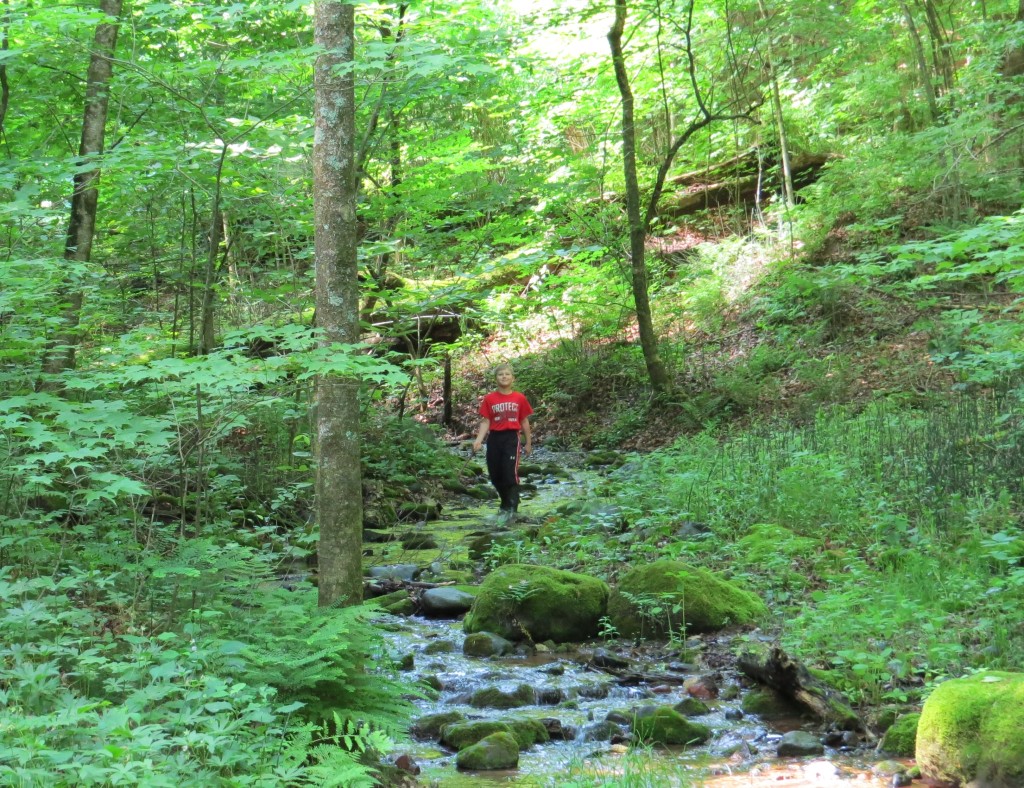 Another lifer for Tommy that we both enjoyed up close was the Veery.
Another lifer for Tommy that we both enjoyed up close was the Veery.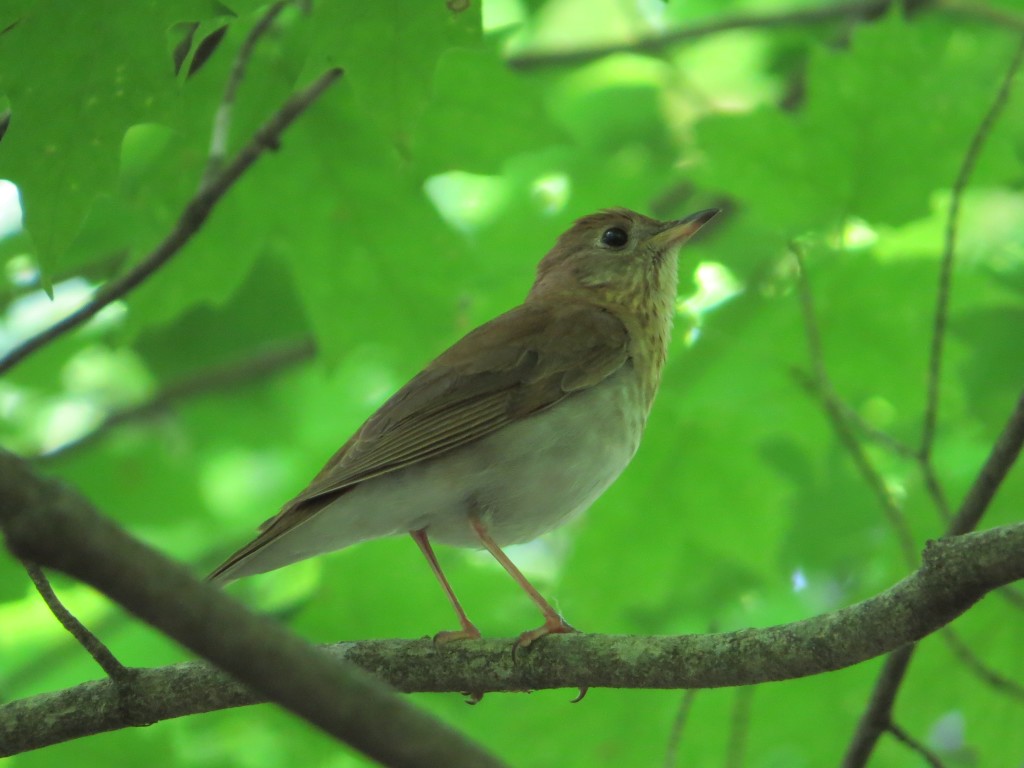 The Veery’s song is the best. It’s unmistakable song can often be heard throughout the deciduous woods of Minnesota. Never before I had I actually seen one sing.
The Veery’s song is the best. It’s unmistakable song can often be heard throughout the deciduous woods of Minnesota. Never before I had I actually seen one sing.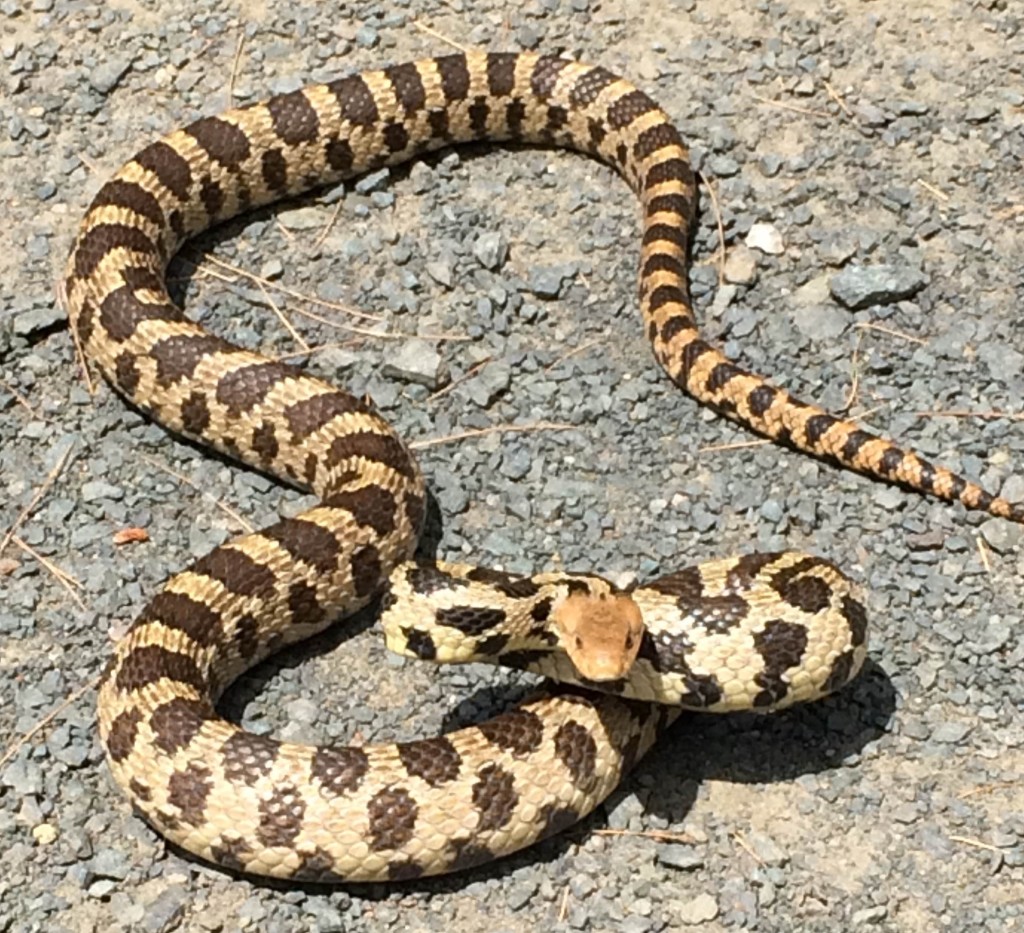 Coming up is one more Minnesota post with Tommy about a rare Warbler we went after for Tommy’s life list. And then we will cover our side trip to Wisconsin to search for two endangered species. Stay tuned.
Coming up is one more Minnesota post with Tommy about a rare Warbler we went after for Tommy’s life list. And then we will cover our side trip to Wisconsin to search for two endangered species. Stay tuned.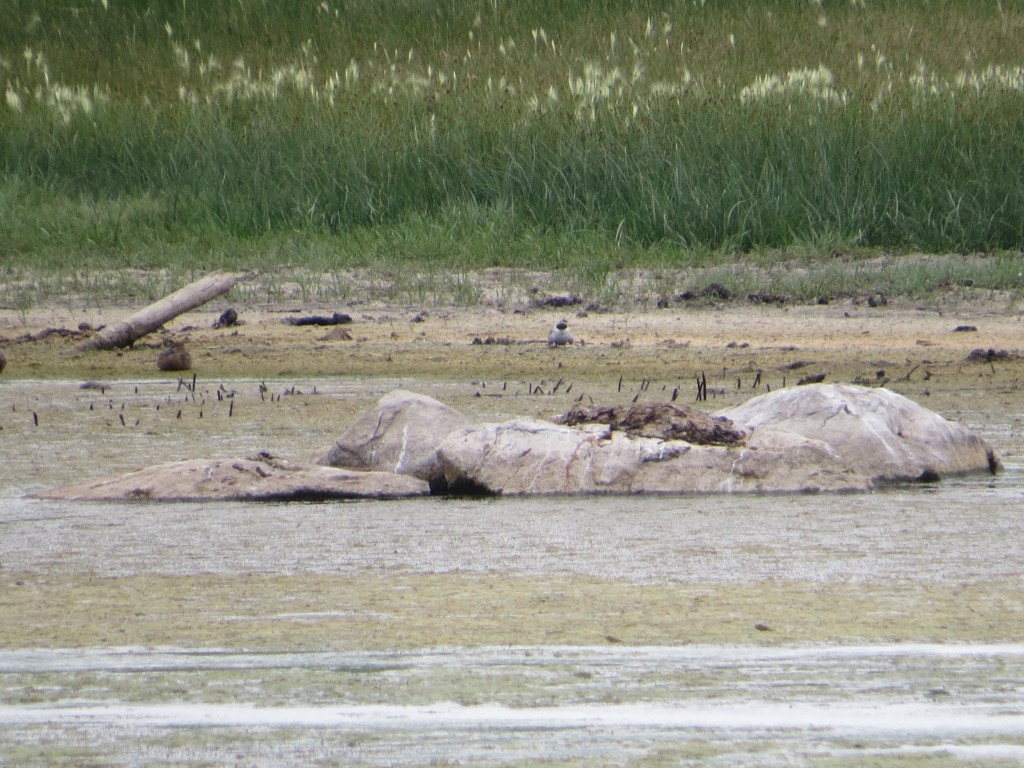 Arctic Tern is casual in Minnesota with most records showing up in Duluth. I never really expected to add this to my life list because A) I’d have to be in Duluth at the right time and B) I’d have to be standing next to an expert birder who could help me differentiate this species from the Common Tern while it flew in the distance.
Arctic Tern is casual in Minnesota with most records showing up in Duluth. I never really expected to add this to my life list because A) I’d have to be in Duluth at the right time and B) I’d have to be standing next to an expert birder who could help me differentiate this species from the Common Tern while it flew in the distance.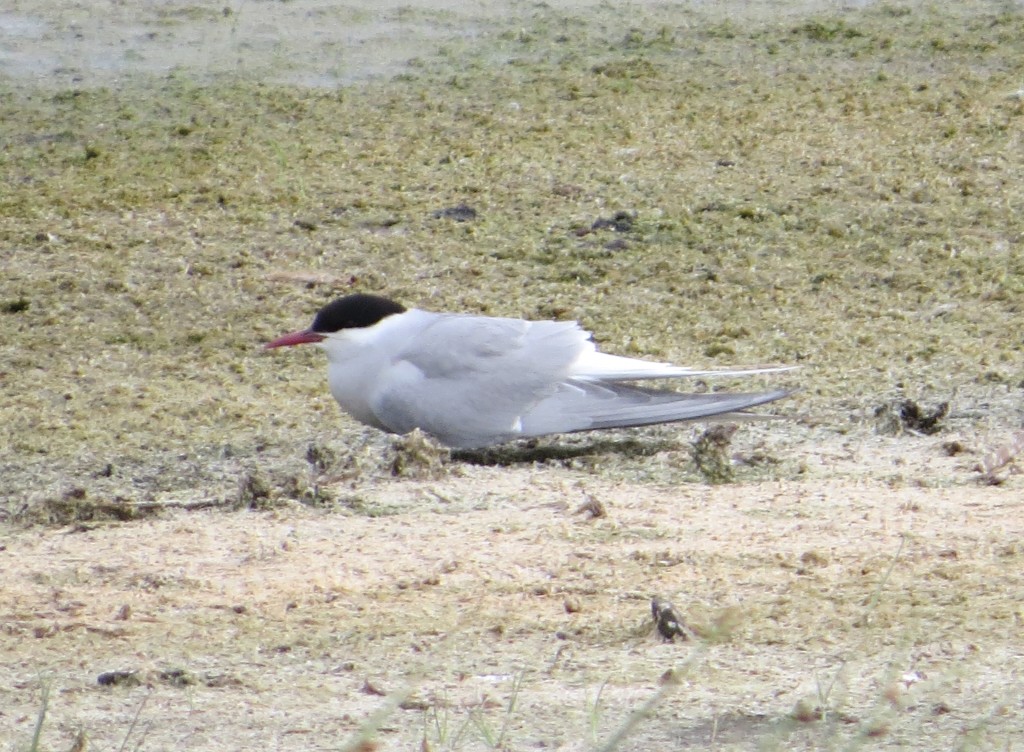 I had thought the Tern was resting on its belly, but I guess its legs are just that short that it only appeared that way. I was hoping to catch the Tern in flight to see the diagnostic dark trailing edge of the primaries. I didn’t get to see it fly, but some other birders did see it fly and captured that field mark in photos. The bird appeared quite lethargic to me, understandable considering the Arctic Tern is famous for its migration from the Antarctic to the Arctic breeding grounds and back each year, a minimum of 24,000 round-trip miles as the crow flies. And we all know Terns don’t fly like Crows. Research with tracking this species has shown that they typically put on 44,000 miles a year. This bird was probably quite wore out and chose the most random of stops to rest.
I had thought the Tern was resting on its belly, but I guess its legs are just that short that it only appeared that way. I was hoping to catch the Tern in flight to see the diagnostic dark trailing edge of the primaries. I didn’t get to see it fly, but some other birders did see it fly and captured that field mark in photos. The bird appeared quite lethargic to me, understandable considering the Arctic Tern is famous for its migration from the Antarctic to the Arctic breeding grounds and back each year, a minimum of 24,000 round-trip miles as the crow flies. And we all know Terns don’t fly like Crows. Research with tracking this species has shown that they typically put on 44,000 miles a year. This bird was probably quite wore out and chose the most random of stops to rest.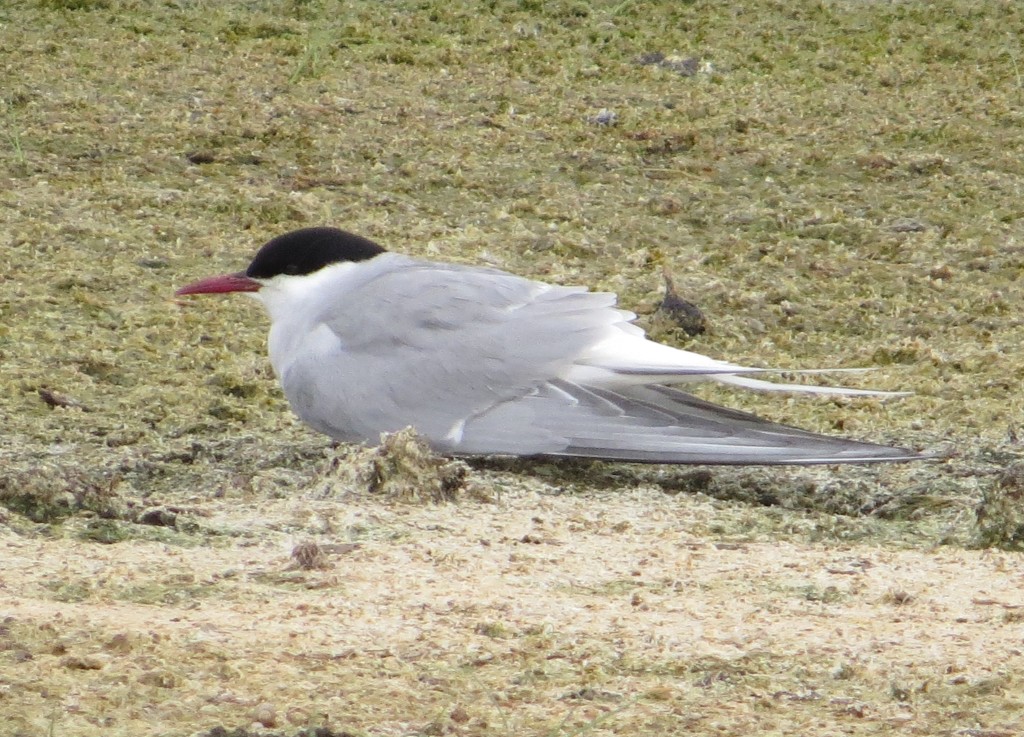 Keeping the Tern company was an American Avocet which is not that rare of bird this far west in Minnesota. Avocets have almost become something of a trash bird on this blog this year. Who would’ve thought?
Keeping the Tern company was an American Avocet which is not that rare of bird this far west in Minnesota. Avocets have almost become something of a trash bird on this blog this year. Who would’ve thought?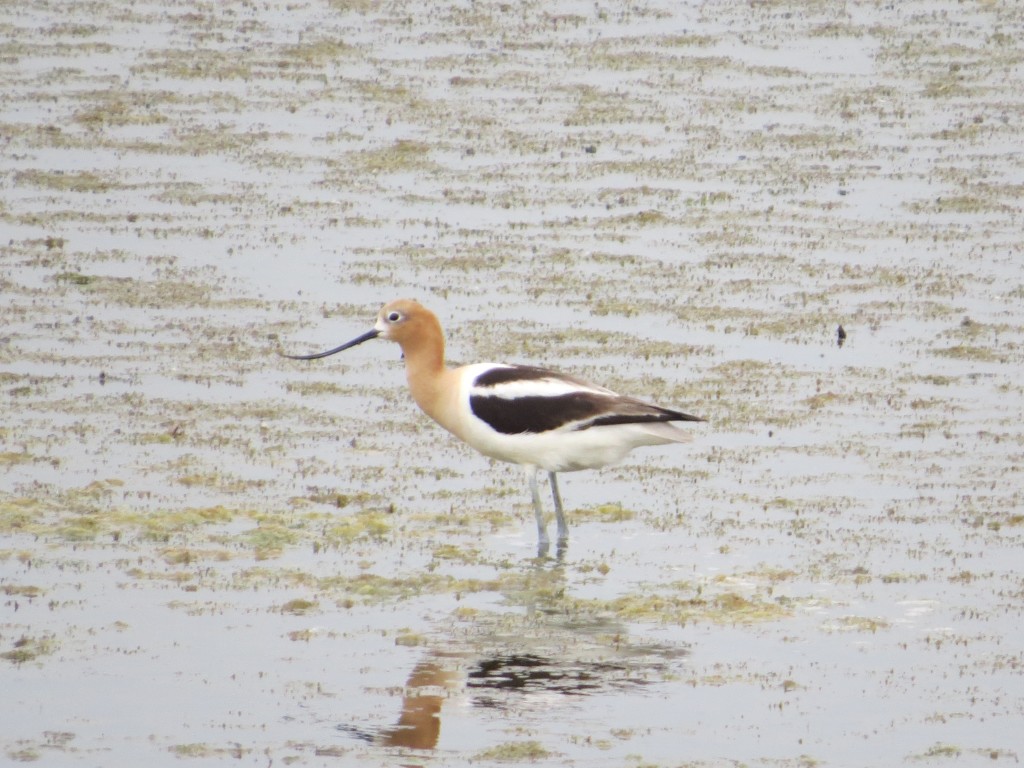 Since the Black-necked Stilts are a good bird for MN and since they had been relocated while I was on my way to the Tern, I decided to check up on them too. The Stilts would not even be a state bird, but I won’t pass up a chance to see some easy ones that are nearby. They are still quite revered here and have not attained the trash nickname of ‘Mud Poodles’ as they have in some other states.
Since the Black-necked Stilts are a good bird for MN and since they had been relocated while I was on my way to the Tern, I decided to check up on them too. The Stilts would not even be a state bird, but I won’t pass up a chance to see some easy ones that are nearby. They are still quite revered here and have not attained the trash nickname of ‘Mud Poodles’ as they have in some other states.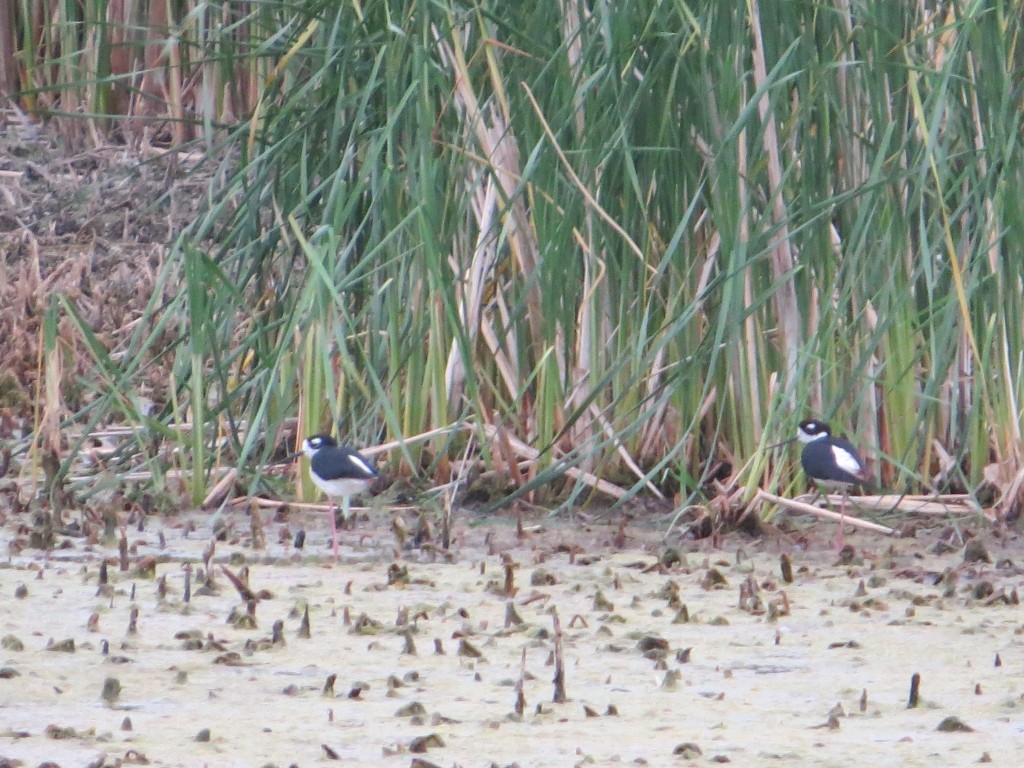 Three great birds, two of which were casual species and one of which was a lifer, made for a great day of birding. Terns out I made the right decision to chase when I did. Unfortunately for Randy and Steve, they were not able to relocate either the Arctic Tern or the Black-necked Stilts the next day.
Three great birds, two of which were casual species and one of which was a lifer, made for a great day of birding. Terns out I made the right decision to chase when I did. Unfortunately for Randy and Steve, they were not able to relocate either the Arctic Tern or the Black-necked Stilts the next day.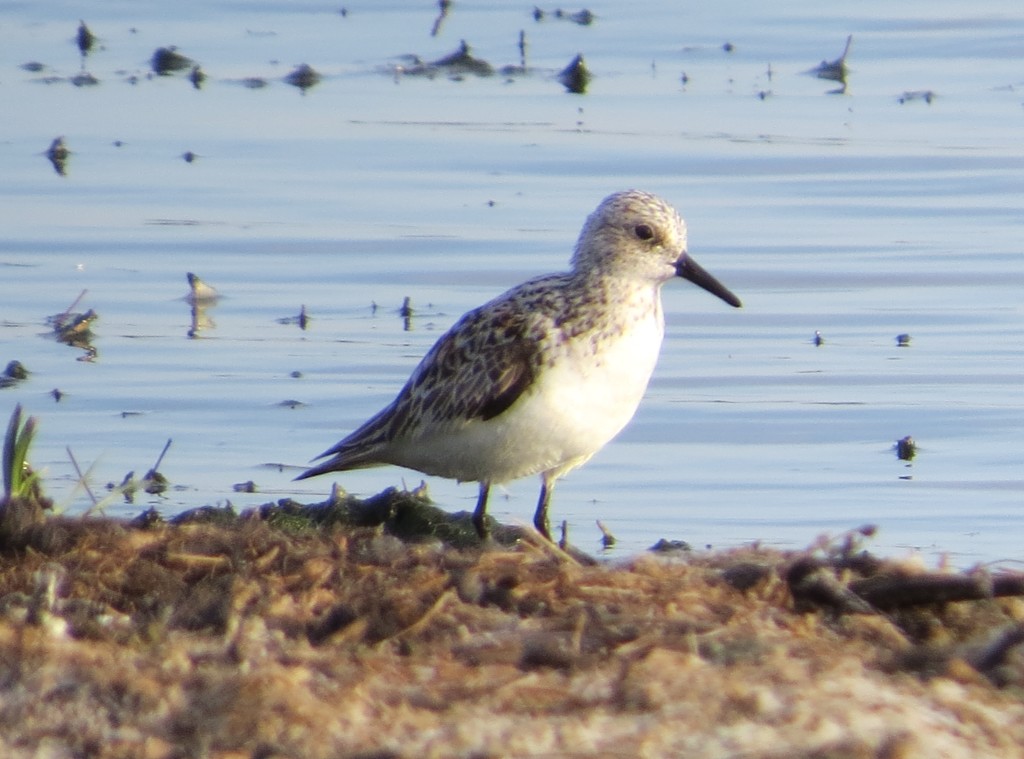 On the way out of Salt Lake I ran into Herb Dingman just heading in. He, of course, was disappointed to hear my report but decided to look anyway. I told him to call me if it showed before I got too far away. That call didn’t come…until I was 15 minutes from home. Herb had seen it. I couldn’t turn around; I had obligations at home before my parents came to visit.
On the way out of Salt Lake I ran into Herb Dingman just heading in. He, of course, was disappointed to hear my report but decided to look anyway. I told him to call me if it showed before I got too far away. That call didn’t come…until I was 15 minutes from home. Herb had seen it. I couldn’t turn around; I had obligations at home before my parents came to visit.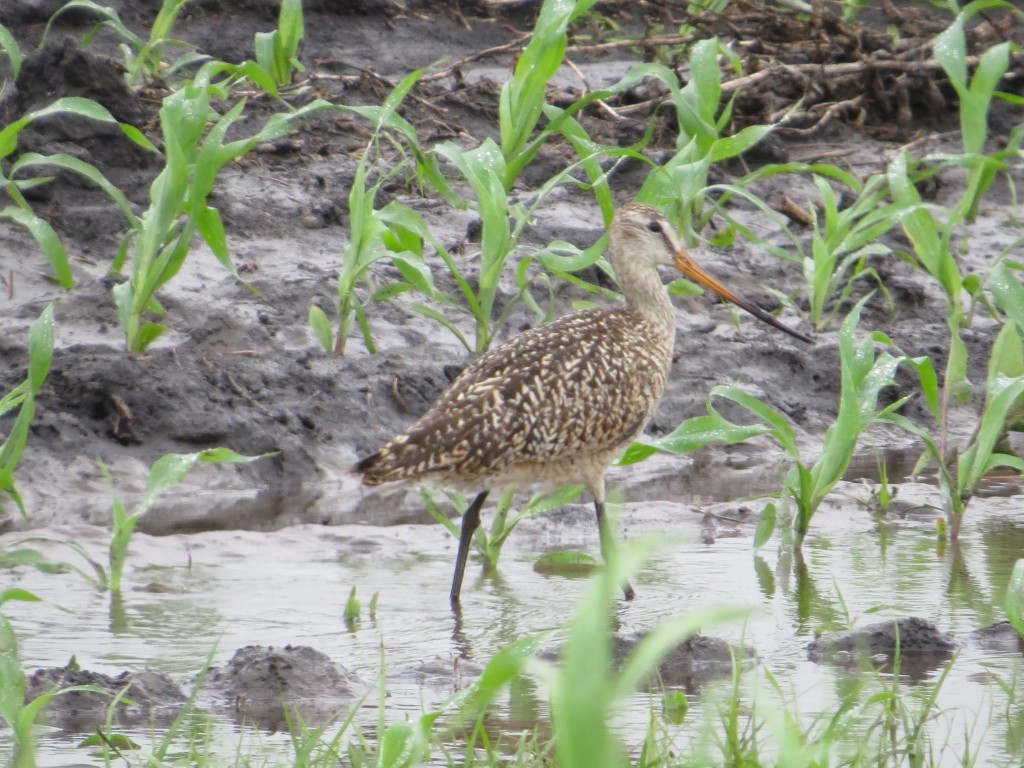
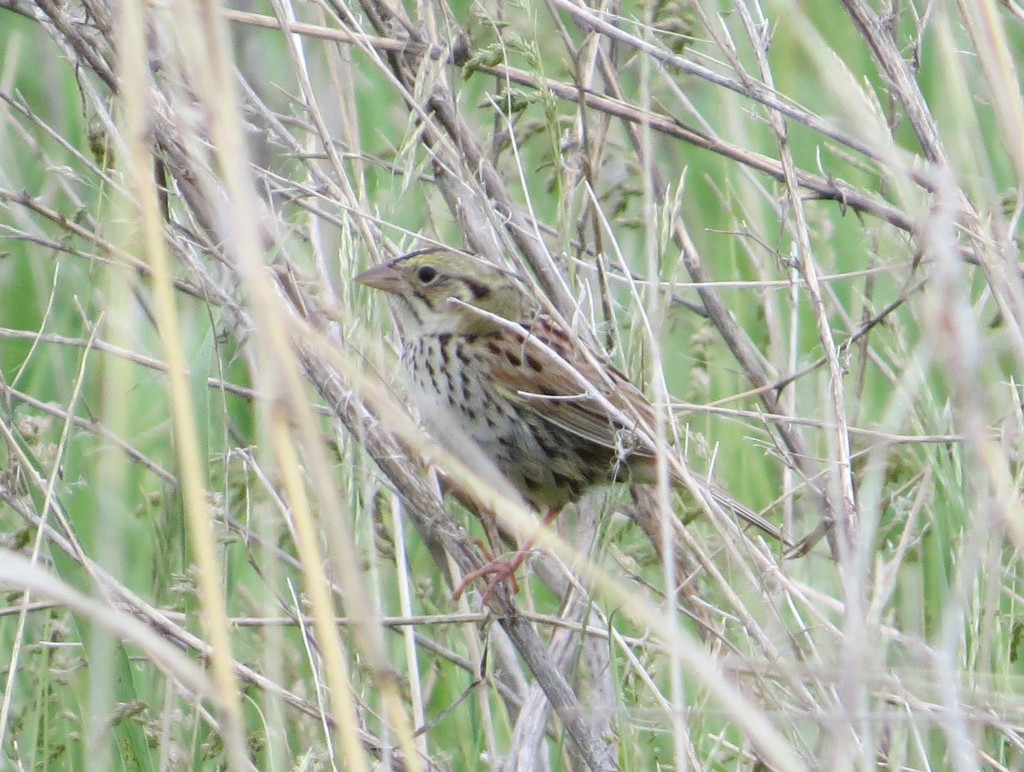
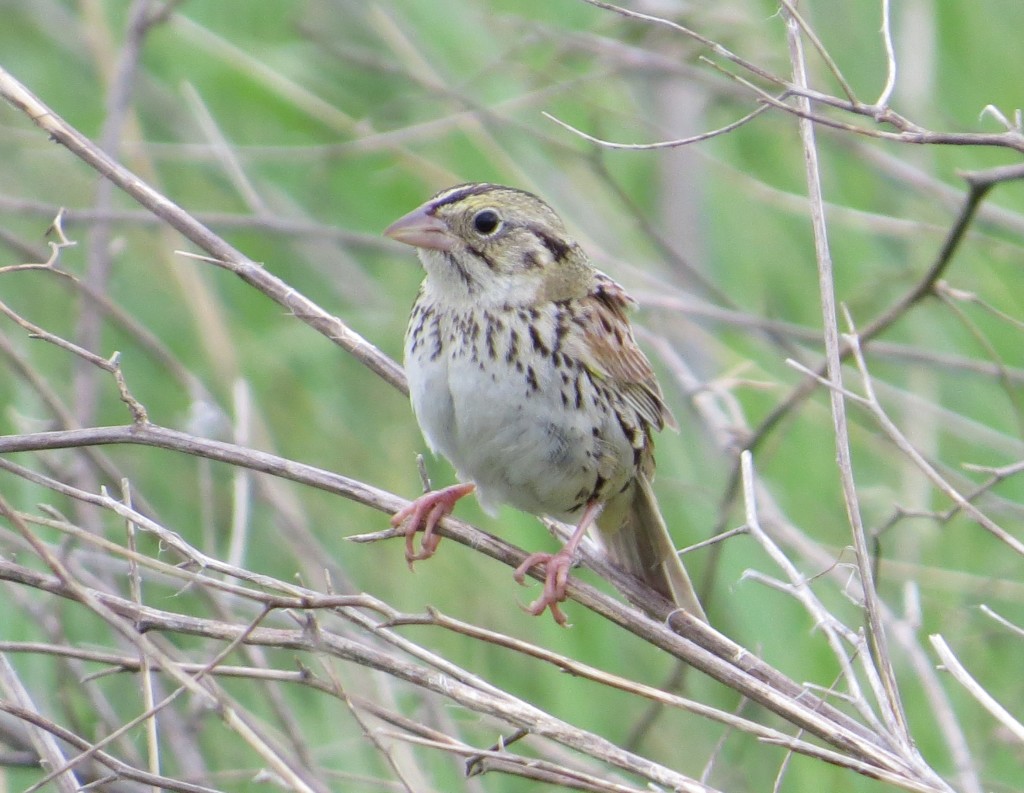
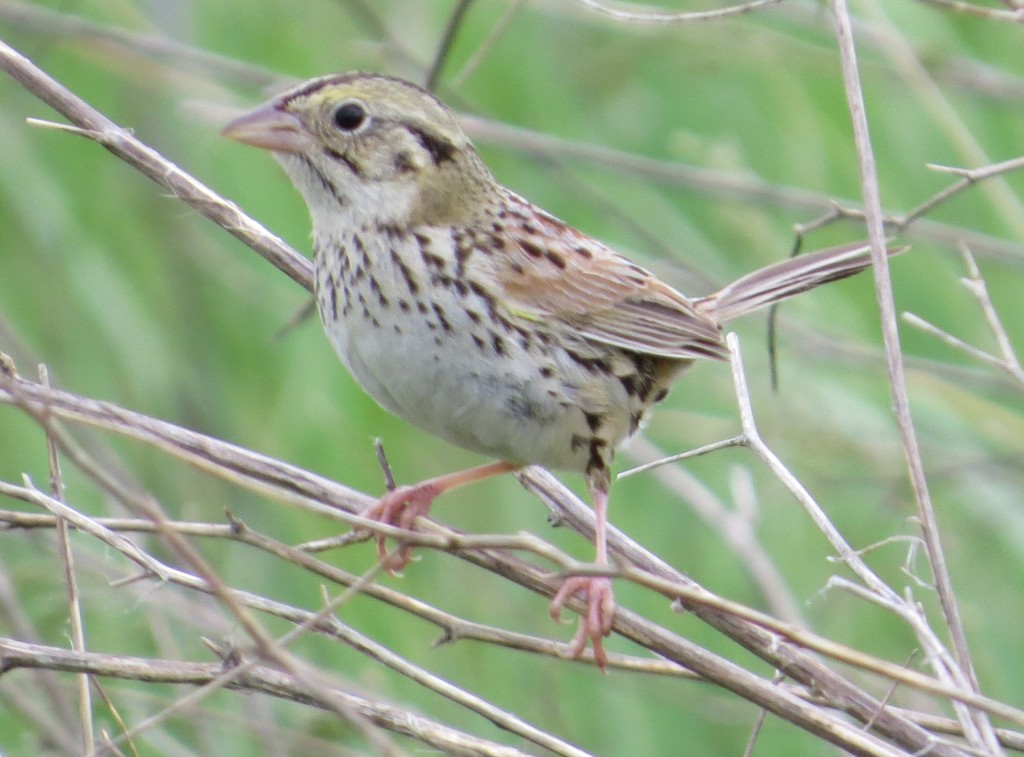 This felt great and made up for the double dip. Dad and I continued to check Salt Lake for the Tern who did not keep any kind of regular schedule. We were not successful, but we did enjoy some of the native grassland birds, like Bobolink and Dad’s favorite, Western Meadowlark.
This felt great and made up for the double dip. Dad and I continued to check Salt Lake for the Tern who did not keep any kind of regular schedule. We were not successful, but we did enjoy some of the native grassland birds, like Bobolink and Dad’s favorite, Western Meadowlark.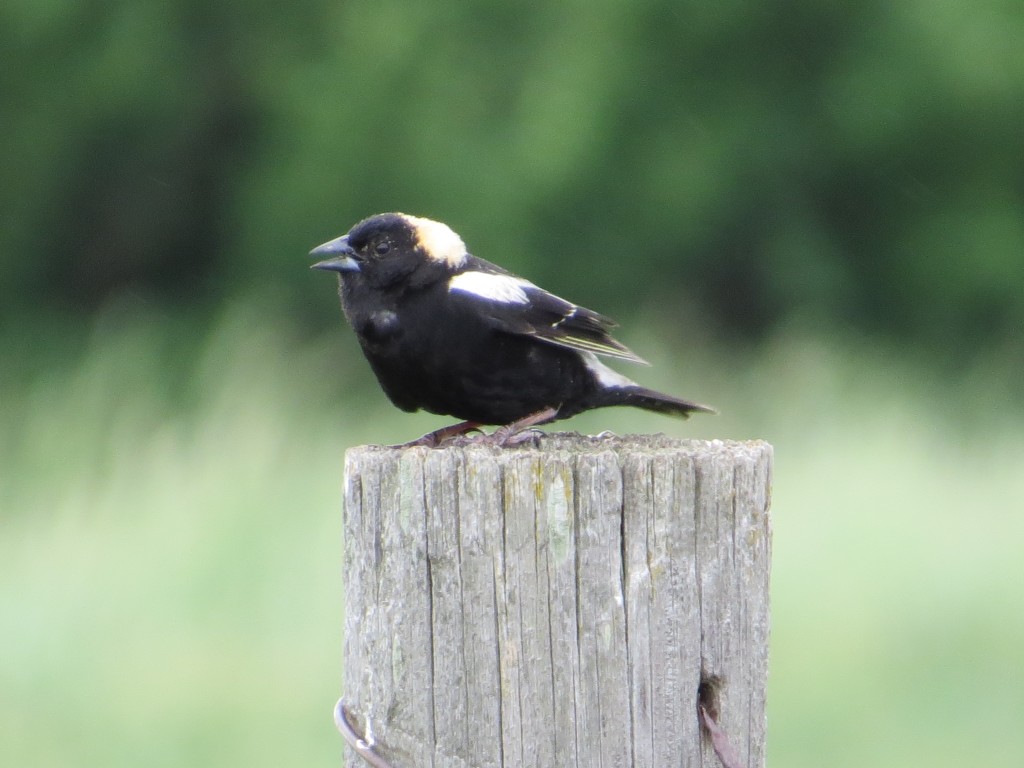
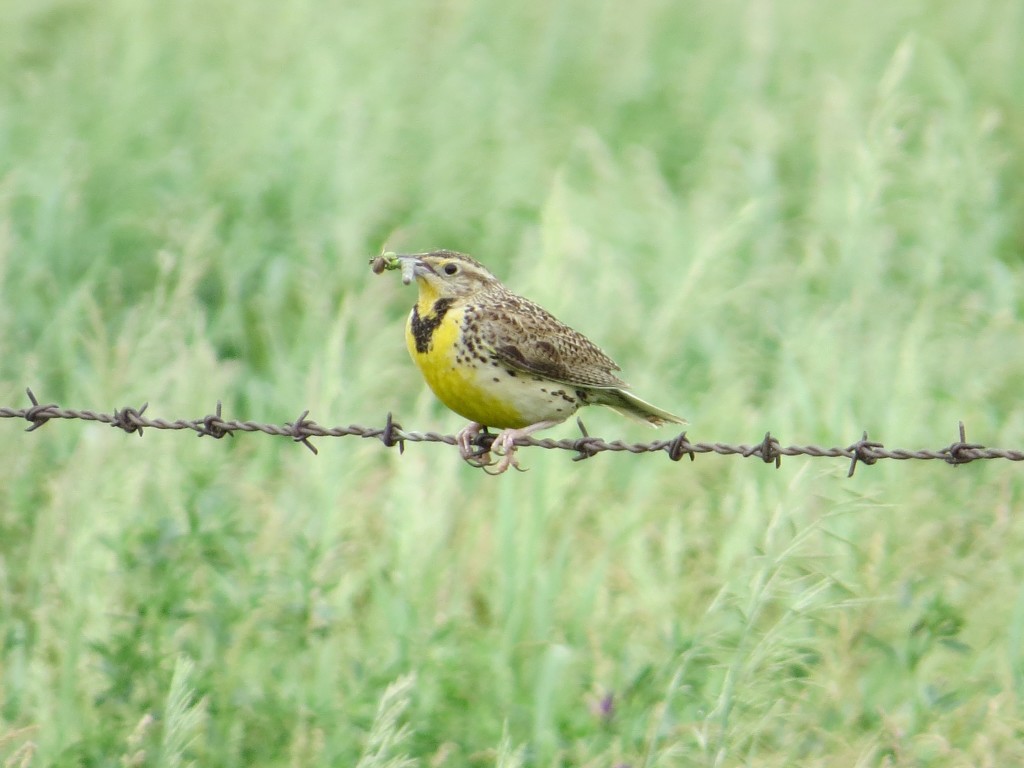 With no luck on the Tern, we decided to try one last time for the Bunting. Nothing. Grasshopper Sparrows are nice, just not LABU nice.
With no luck on the Tern, we decided to try one last time for the Bunting. Nothing. Grasshopper Sparrows are nice, just not LABU nice.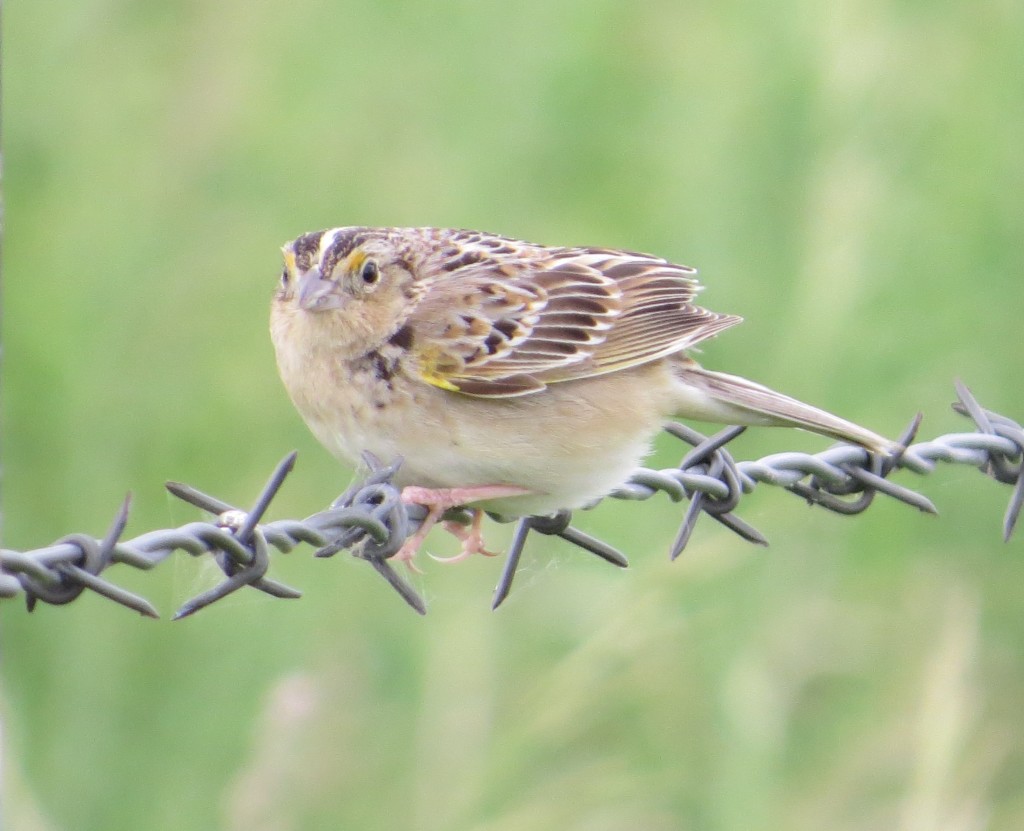
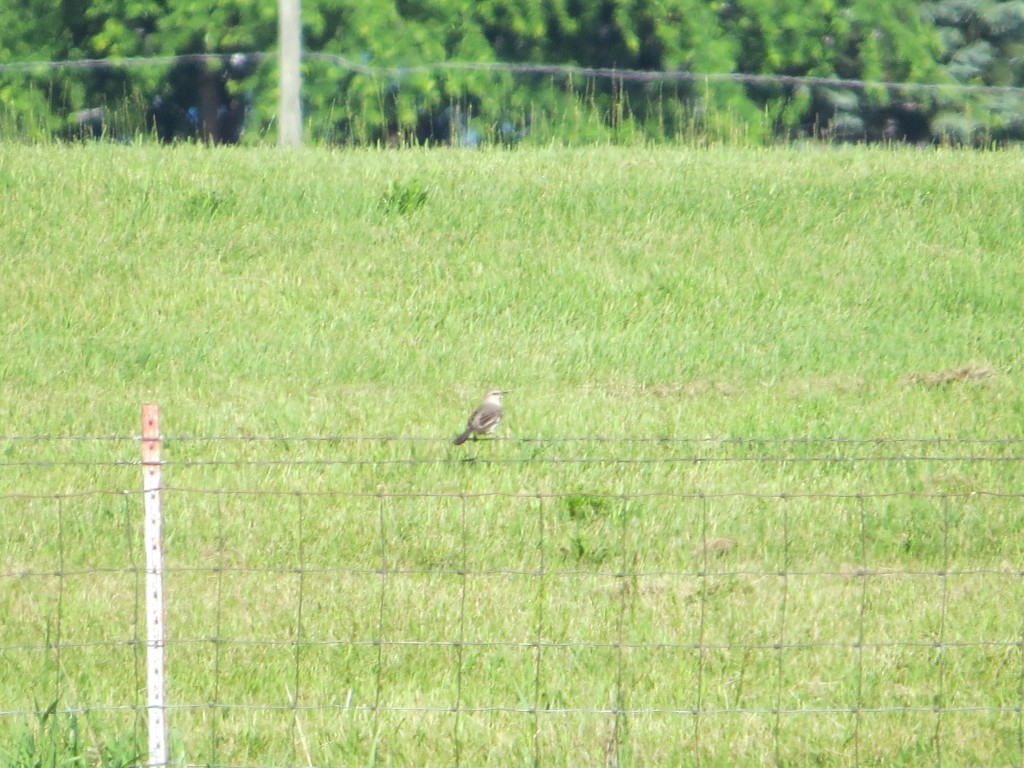 After church, the dreaded news came: the Tern had been re-sighted at Salt Lake. I hemmed and hawed over going back a third time. This bird had burned me bad. Finally I gave in. It is only 1.5 hours away. Dad and I hopped in the car for another chase. This time I was smart about it, though. ABWCH reader, Tod Eggenberger, had been there all day, left to go home, and turned around once he saw the news. He was 30 miles away. I asked Tod to keep me in the loop and let me know if this unpredictable, elusive bird were to give people the slip again. Unfortunately for Tod, he missed it by 5 minutes before the bird vanished again forever. Fortunately for me, I got the news before I reached the halfway point to Salt Lake. I decided I would go that far in case there was positive news. There wasn’t. So I turned around at the predetermined spot and cut my losses. Take that, you stupid Tern!
After church, the dreaded news came: the Tern had been re-sighted at Salt Lake. I hemmed and hawed over going back a third time. This bird had burned me bad. Finally I gave in. It is only 1.5 hours away. Dad and I hopped in the car for another chase. This time I was smart about it, though. ABWCH reader, Tod Eggenberger, had been there all day, left to go home, and turned around once he saw the news. He was 30 miles away. I asked Tod to keep me in the loop and let me know if this unpredictable, elusive bird were to give people the slip again. Unfortunately for Tod, he missed it by 5 minutes before the bird vanished again forever. Fortunately for me, I got the news before I reached the halfway point to Salt Lake. I decided I would go that far in case there was positive news. There wasn’t. So I turned around at the predetermined spot and cut my losses. Take that, you stupid Tern!